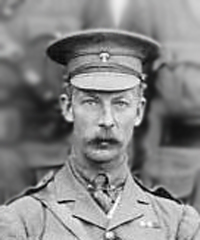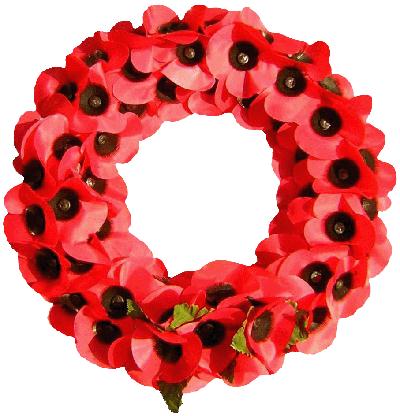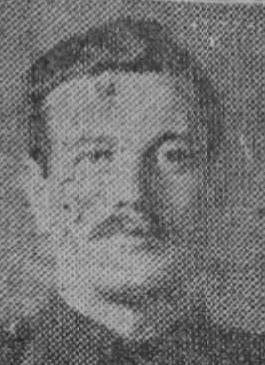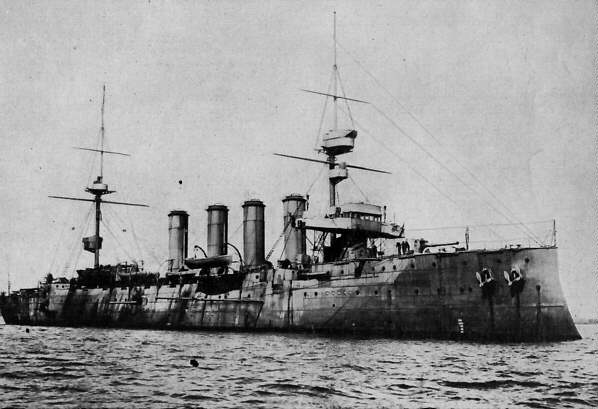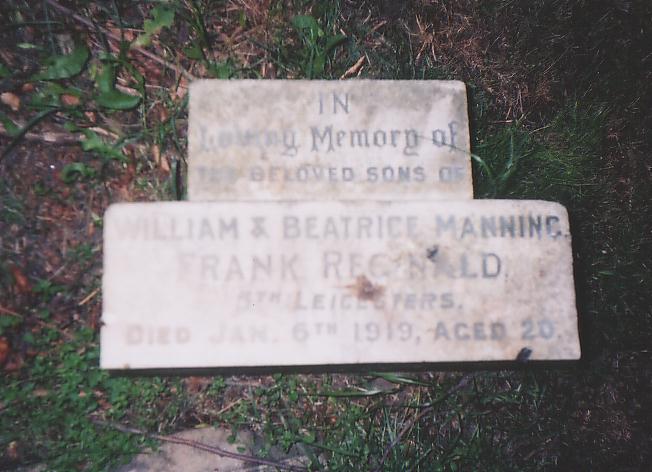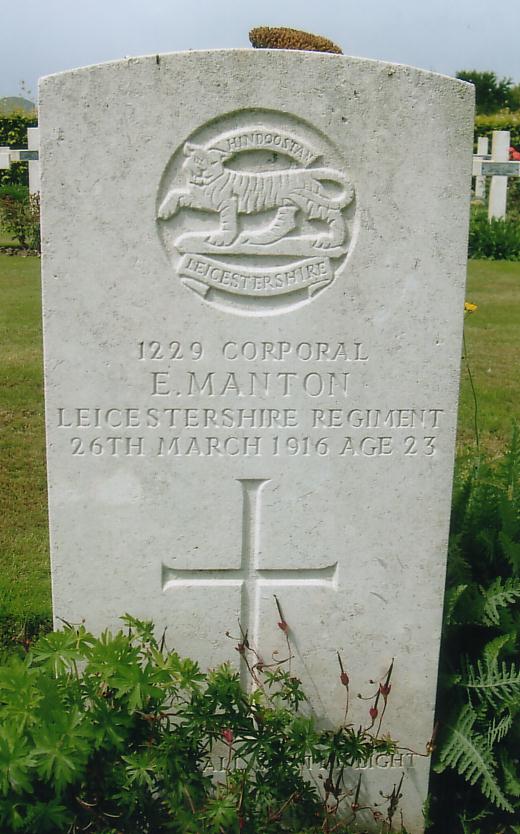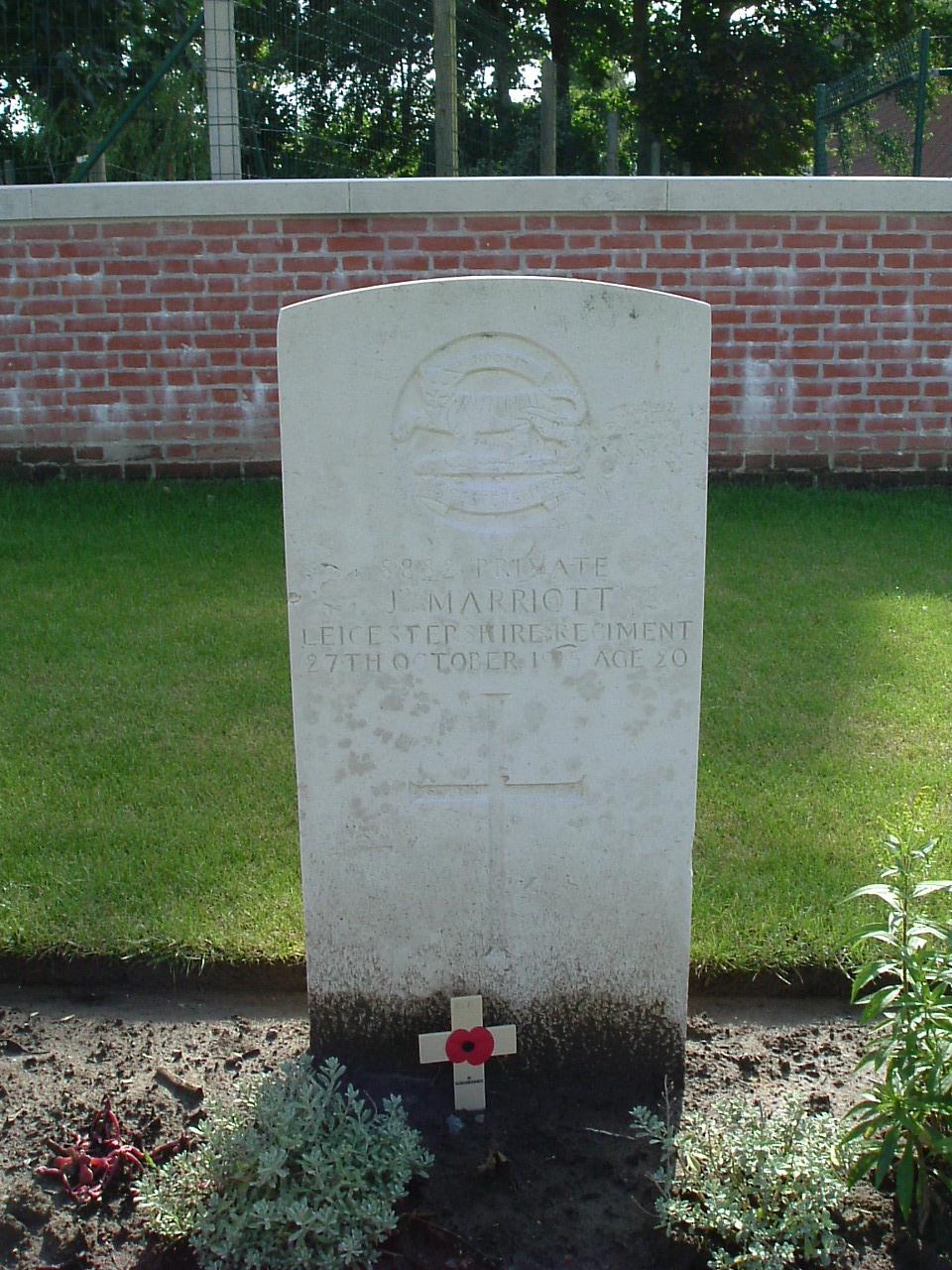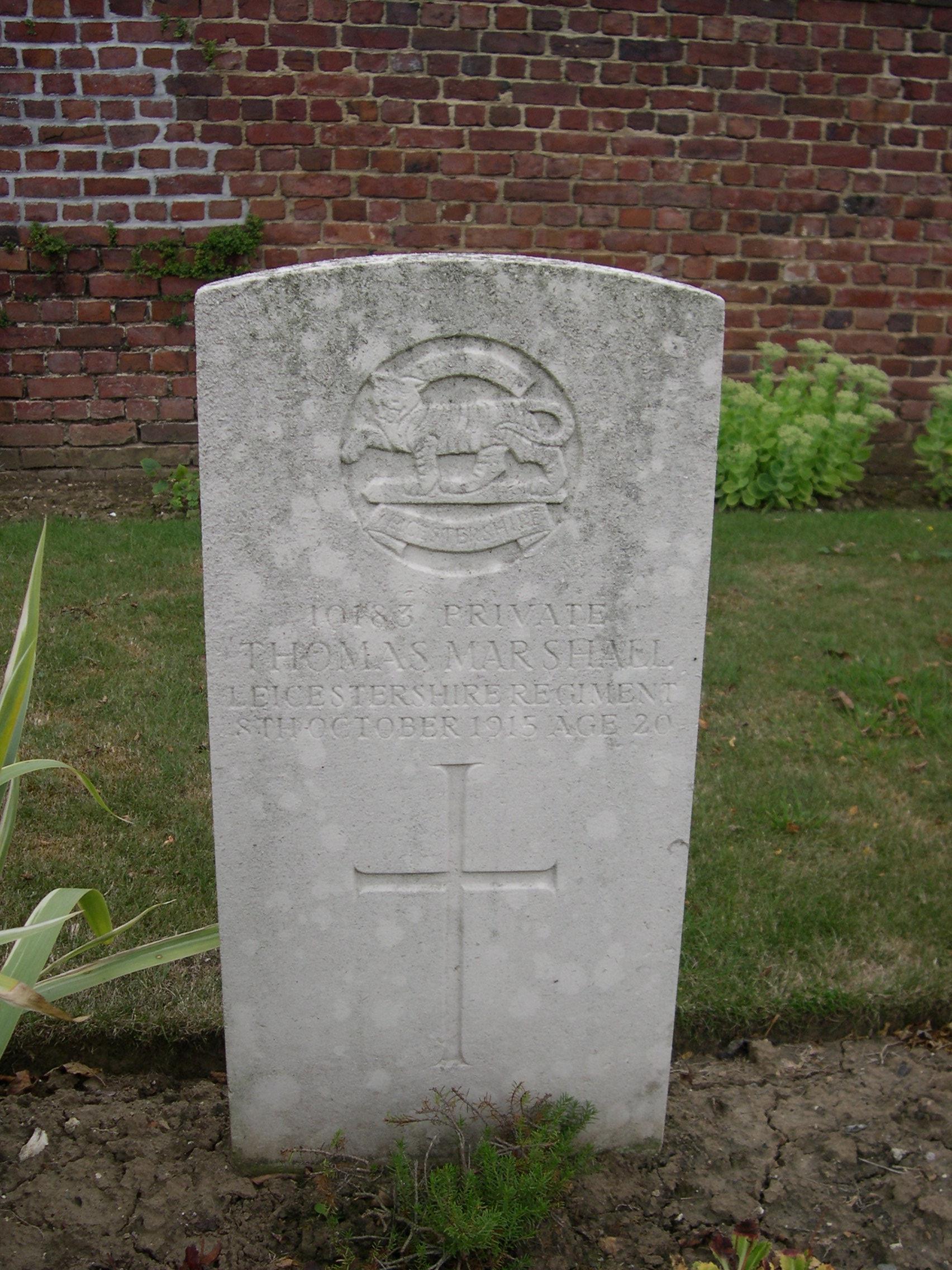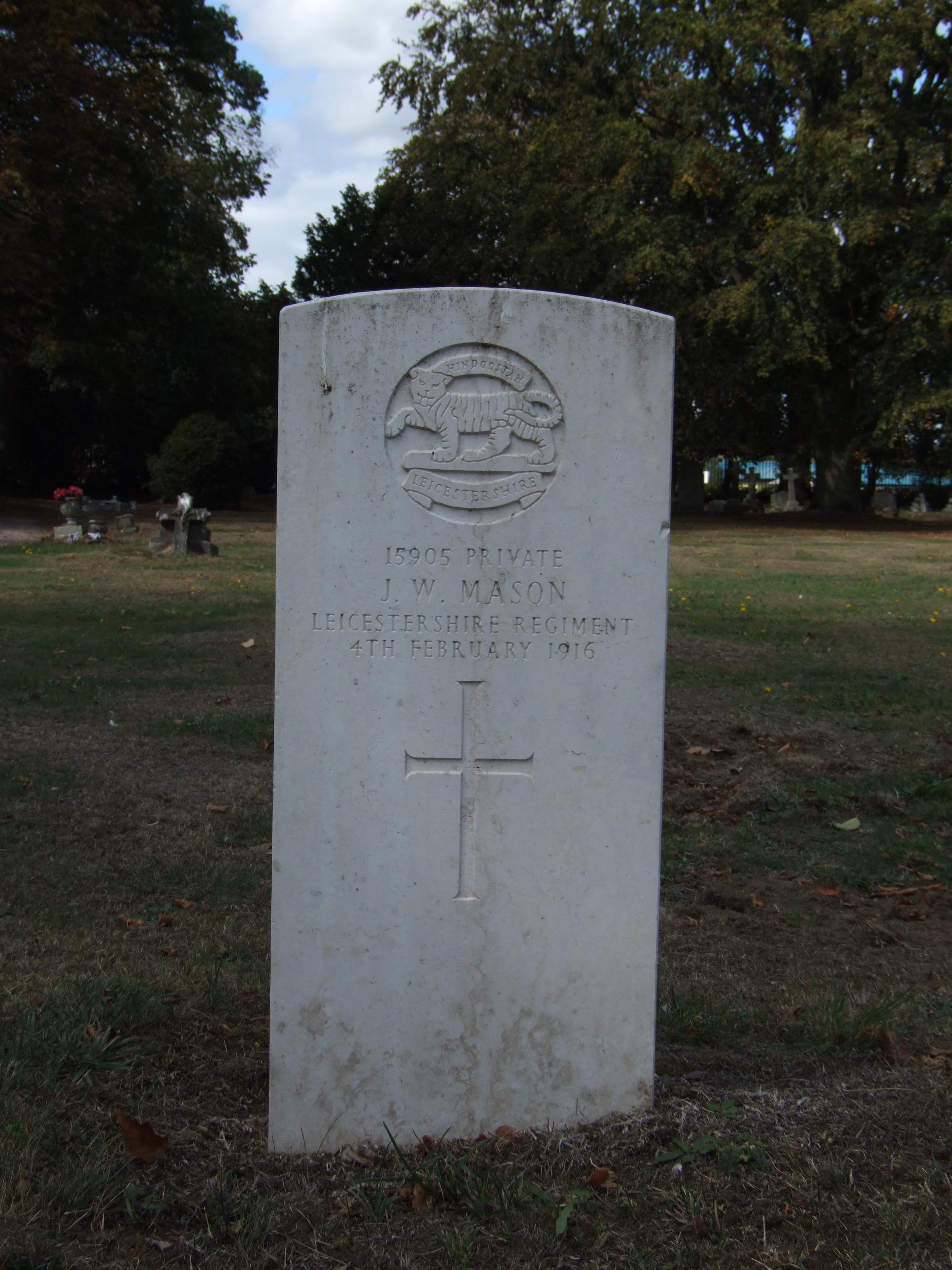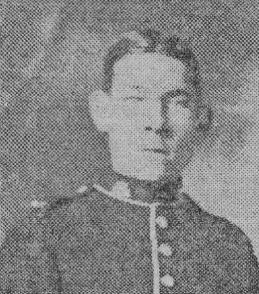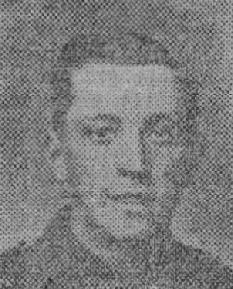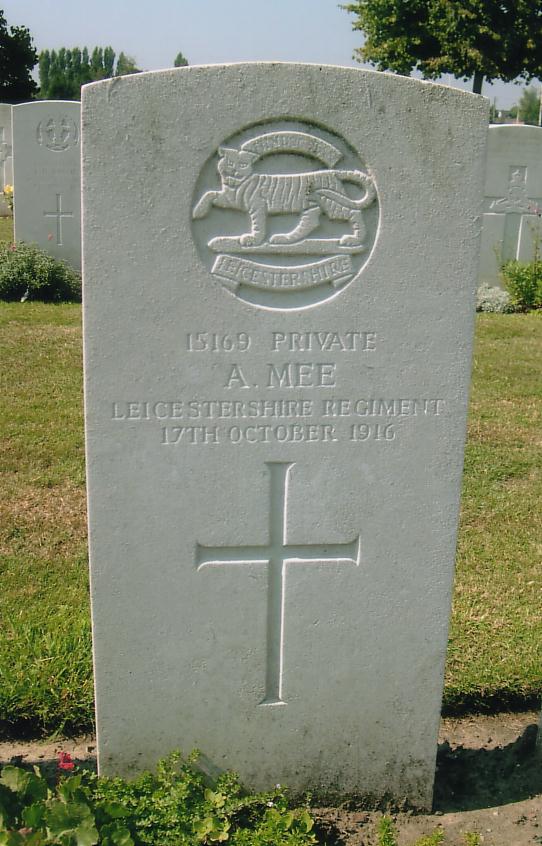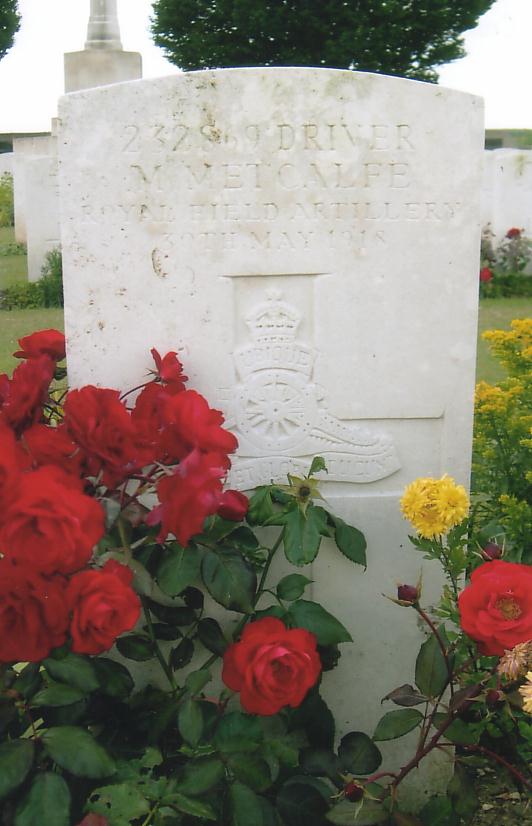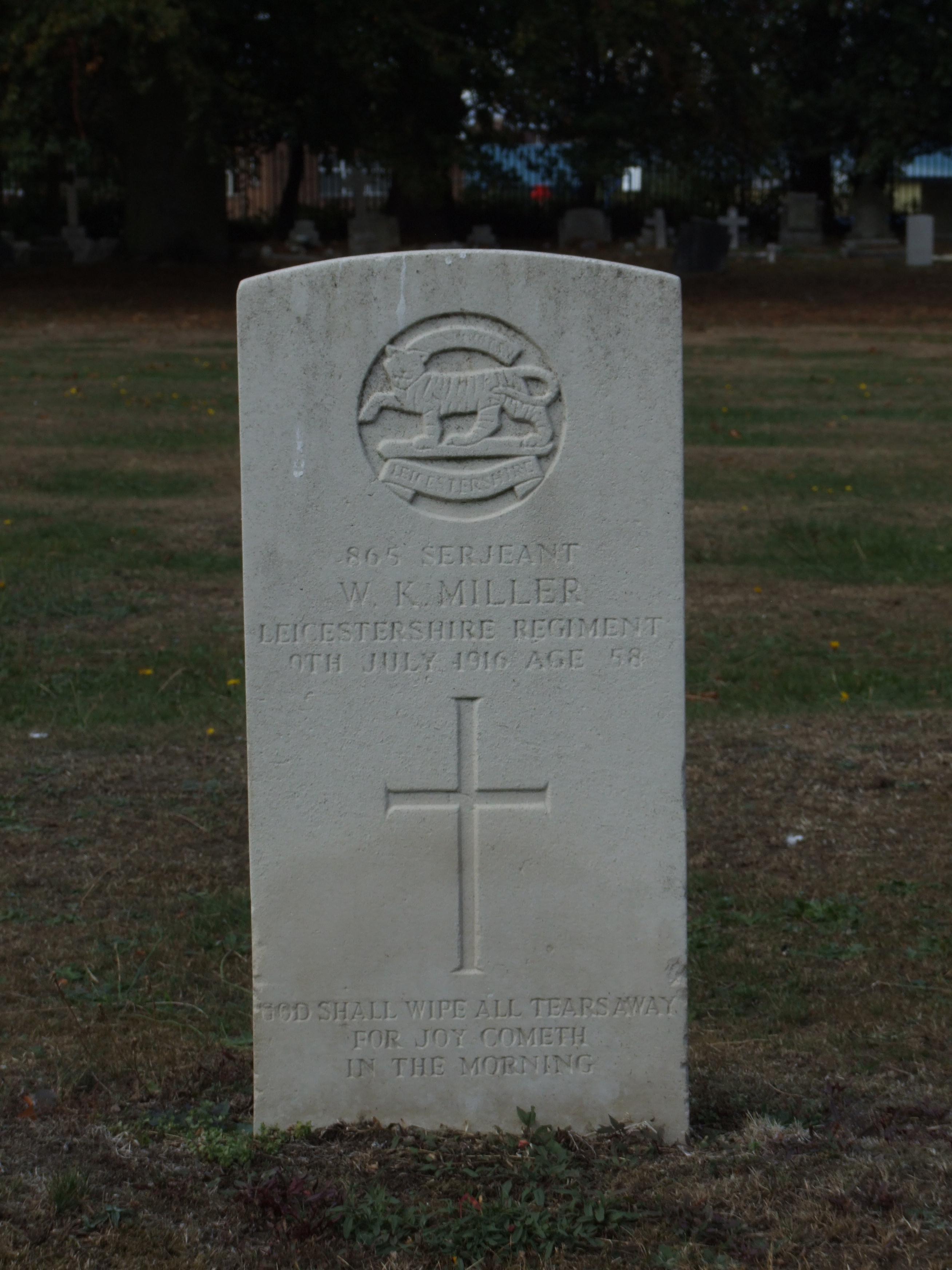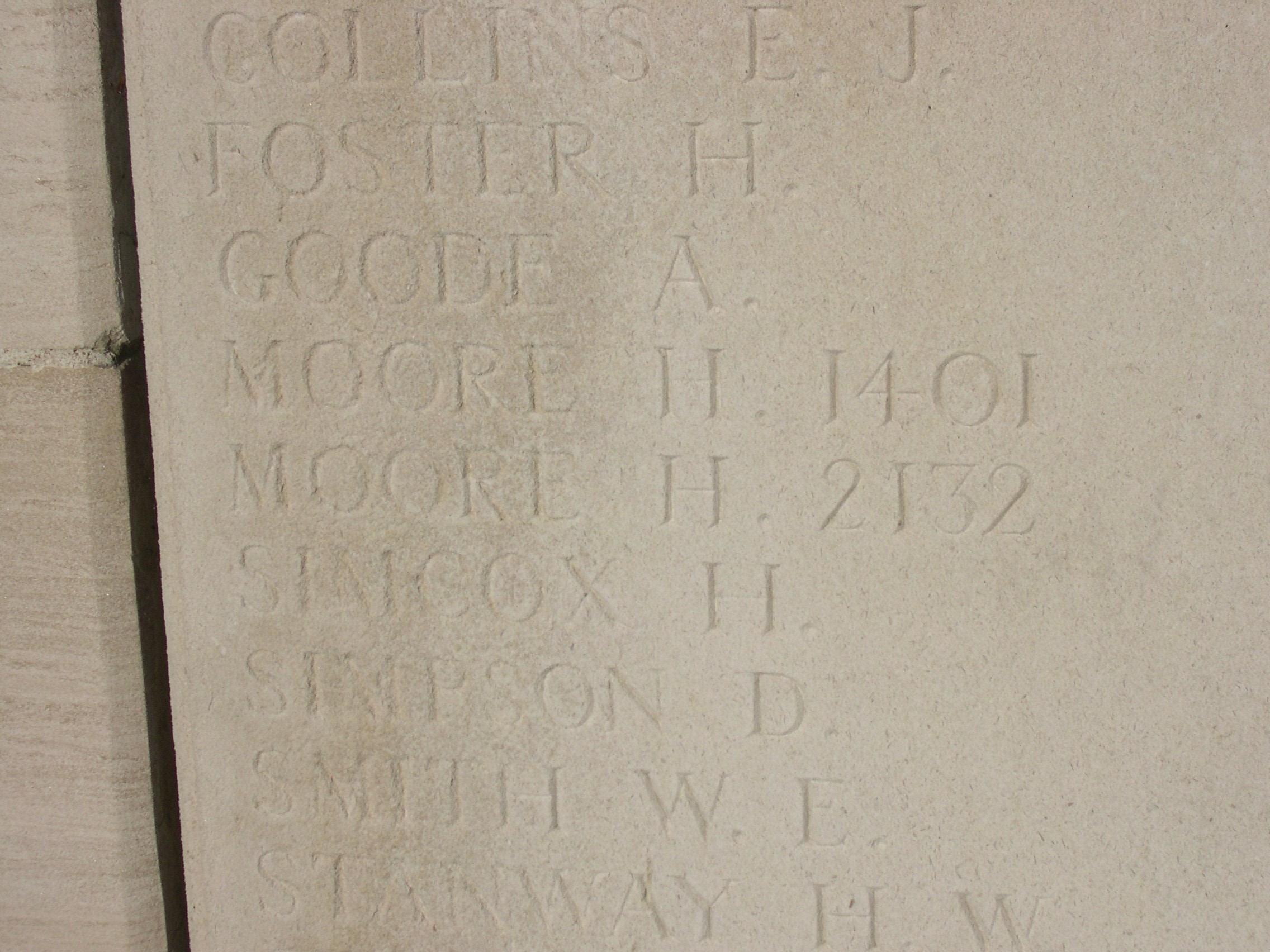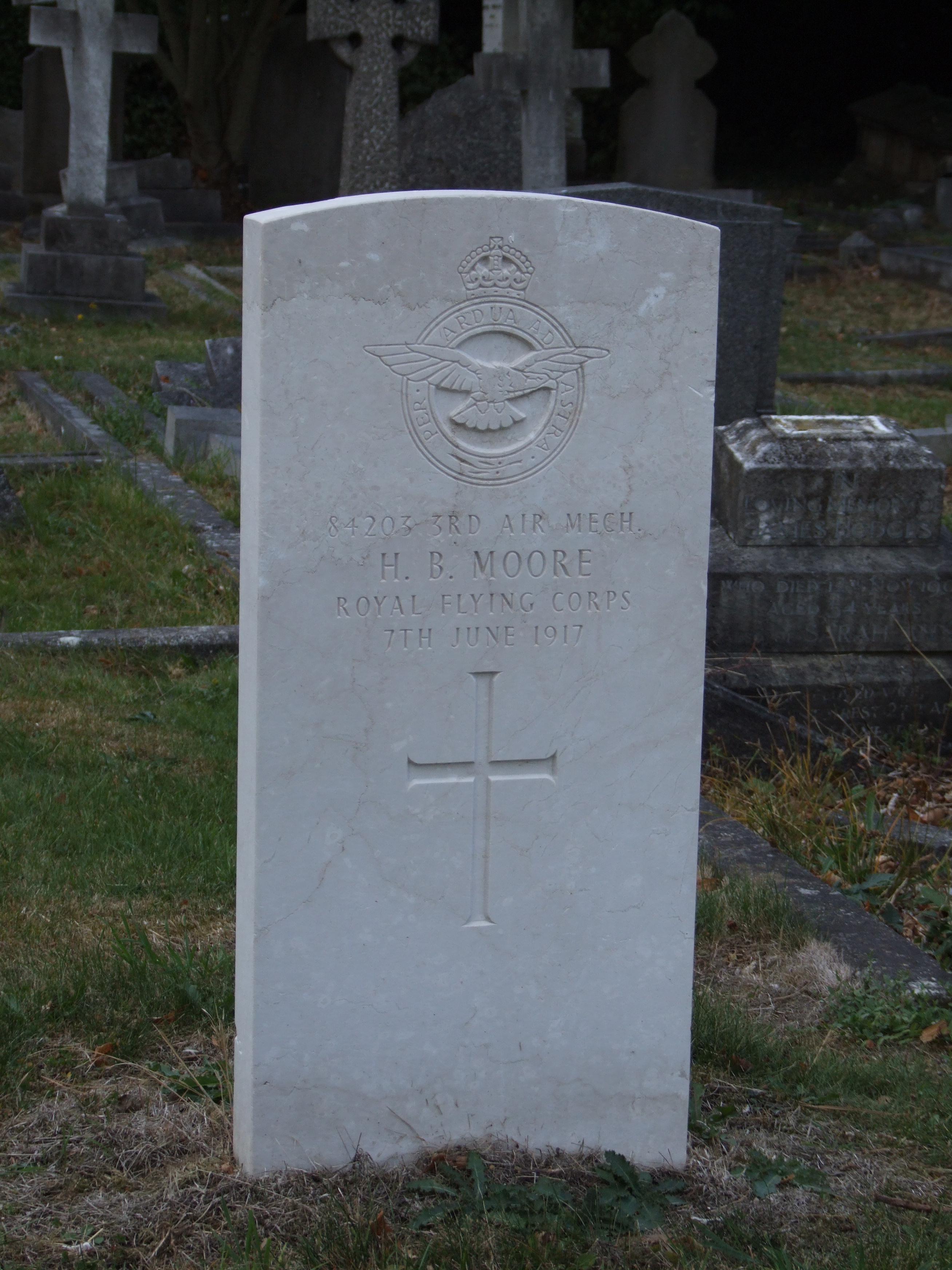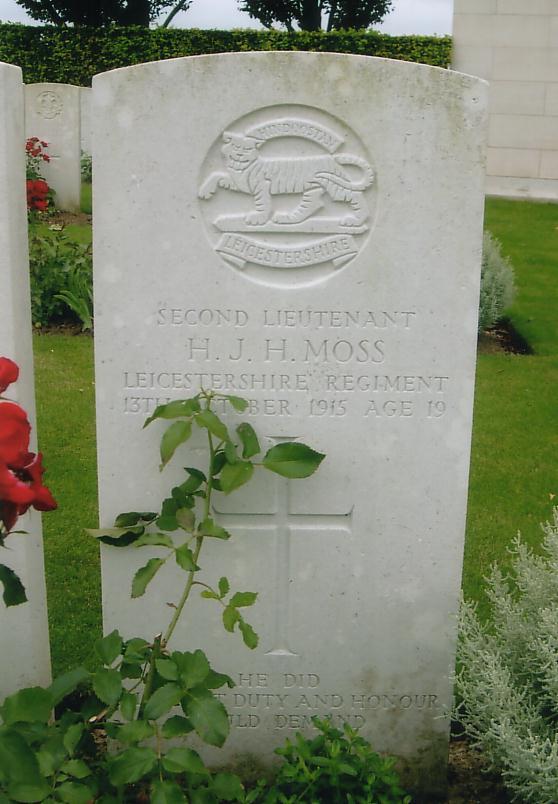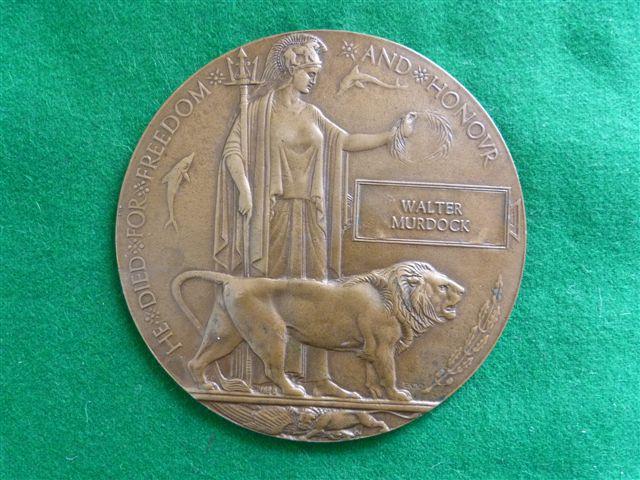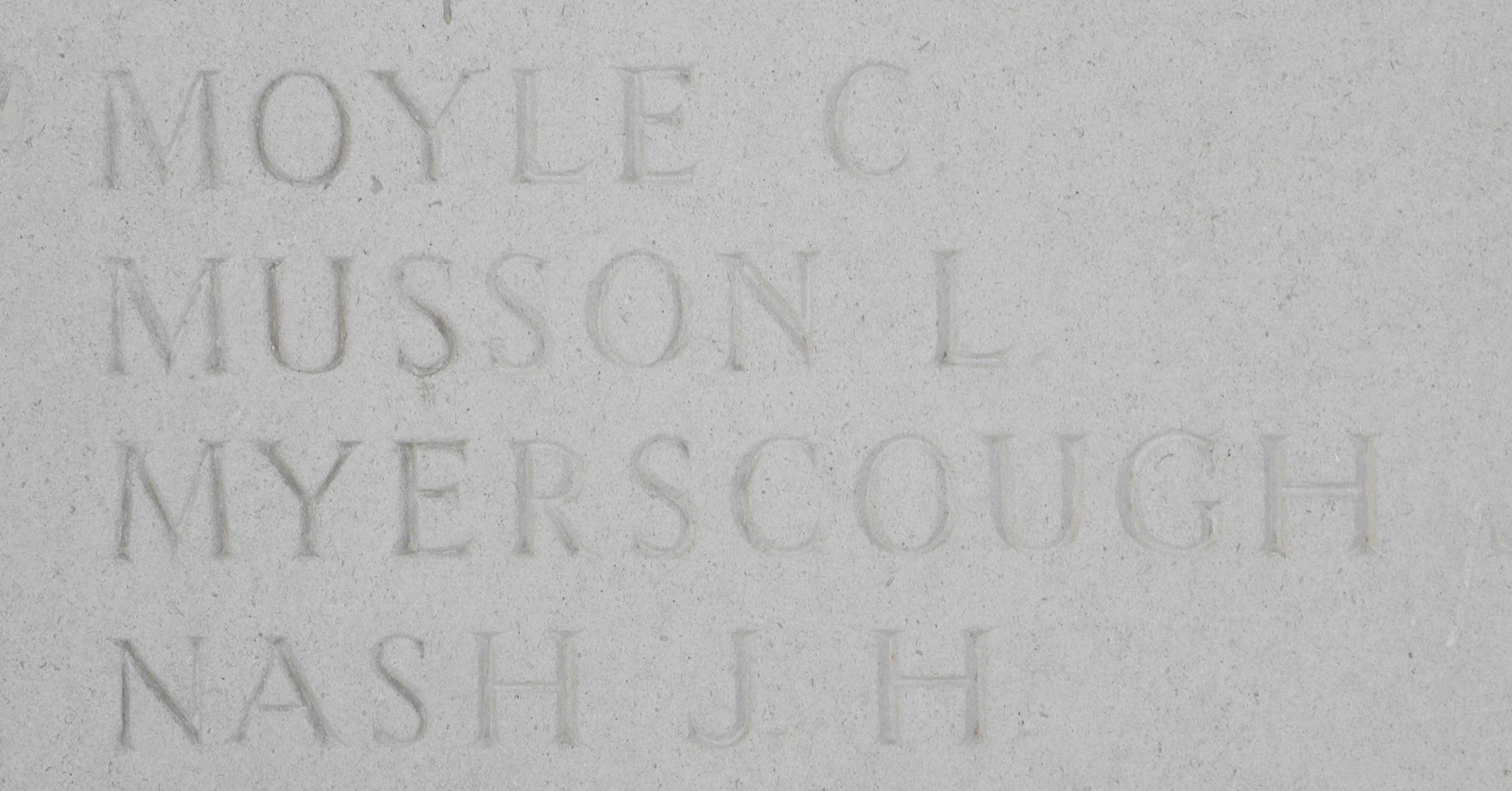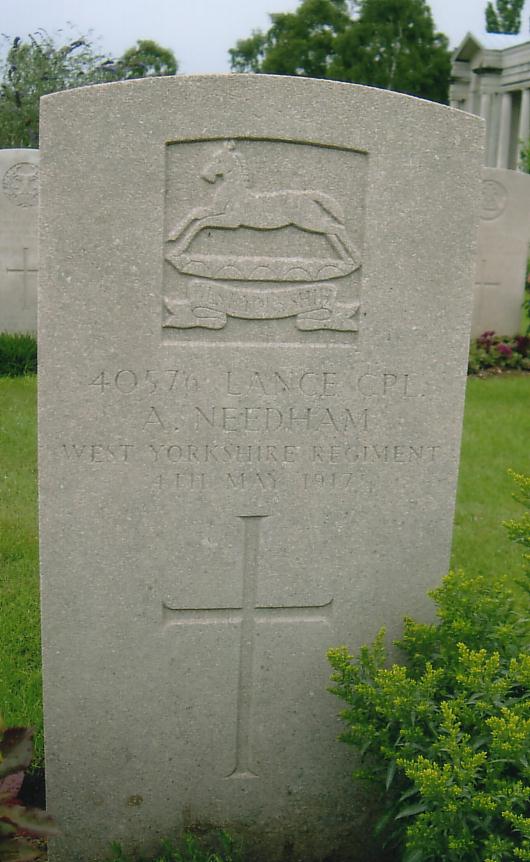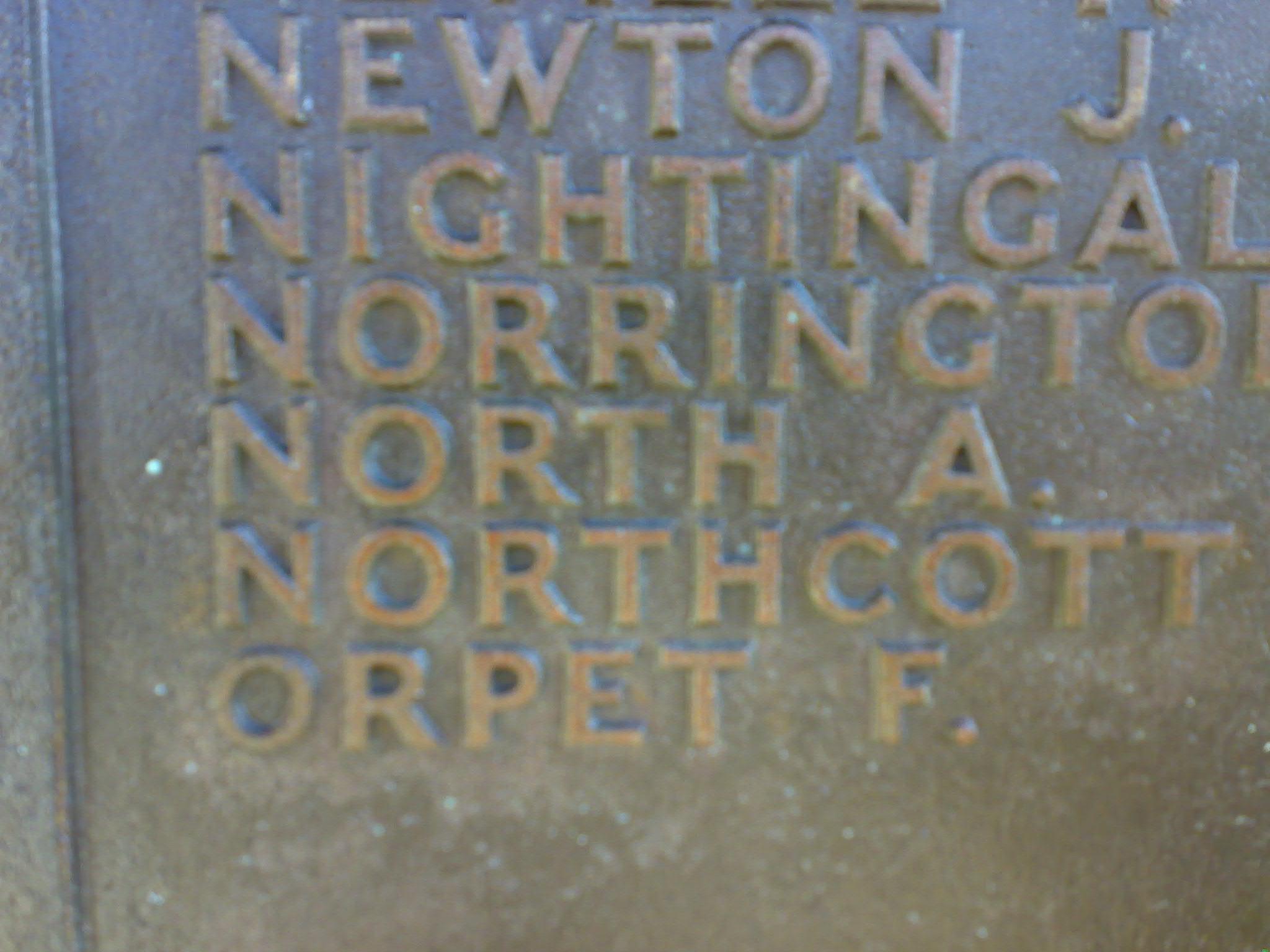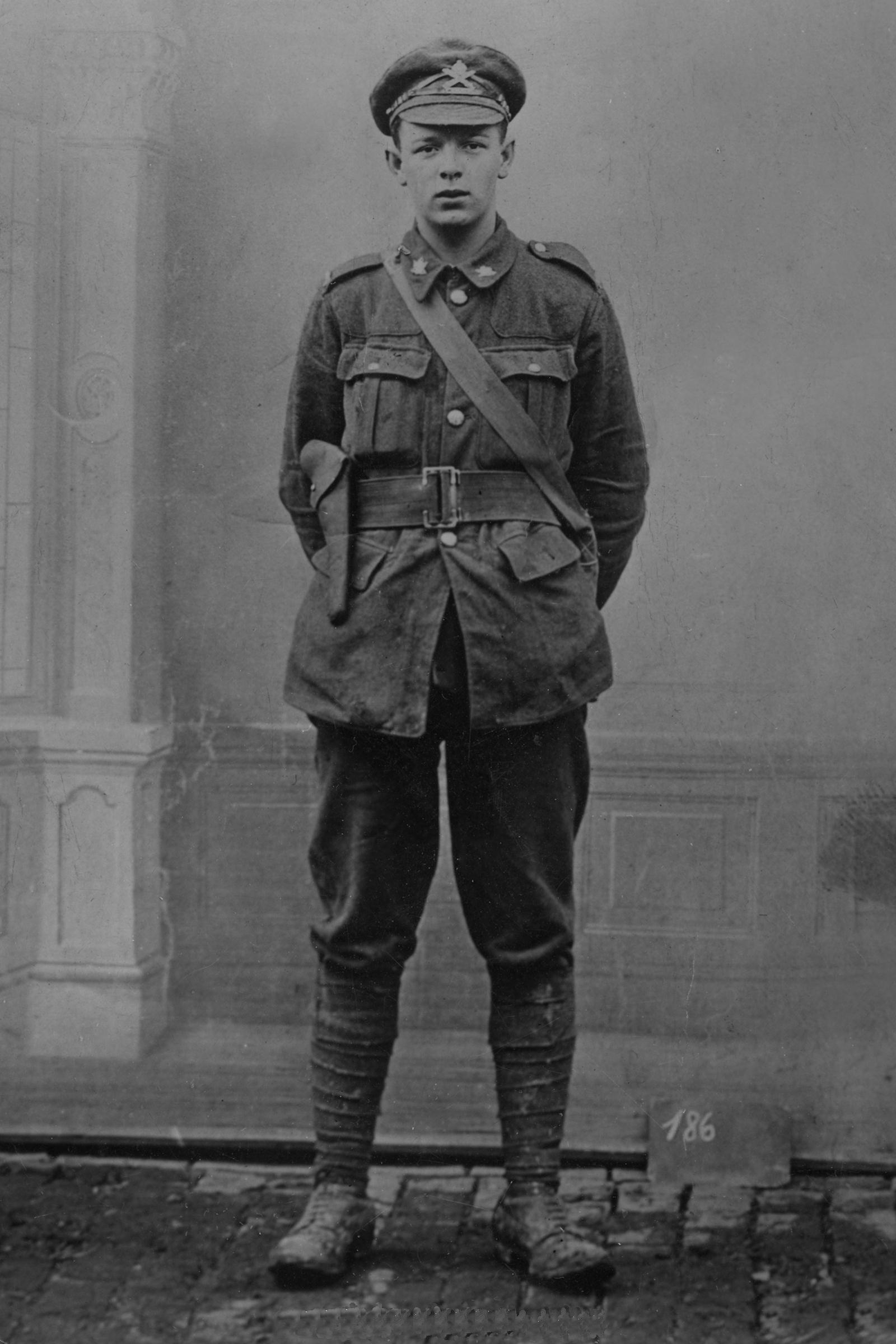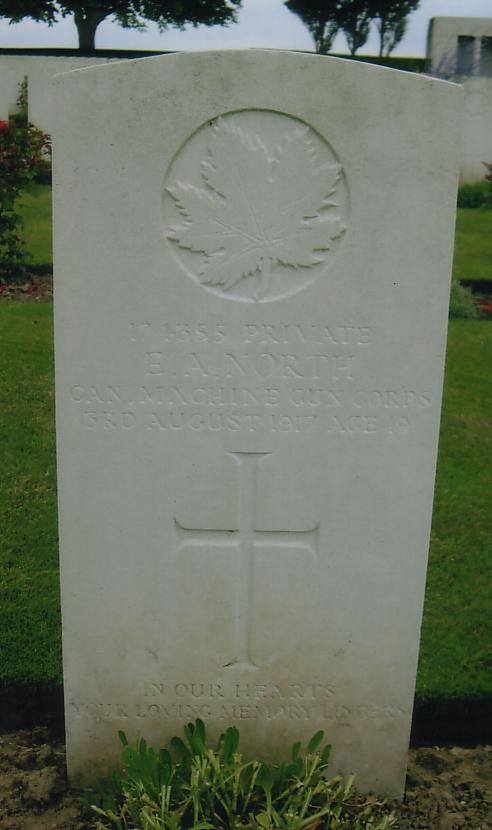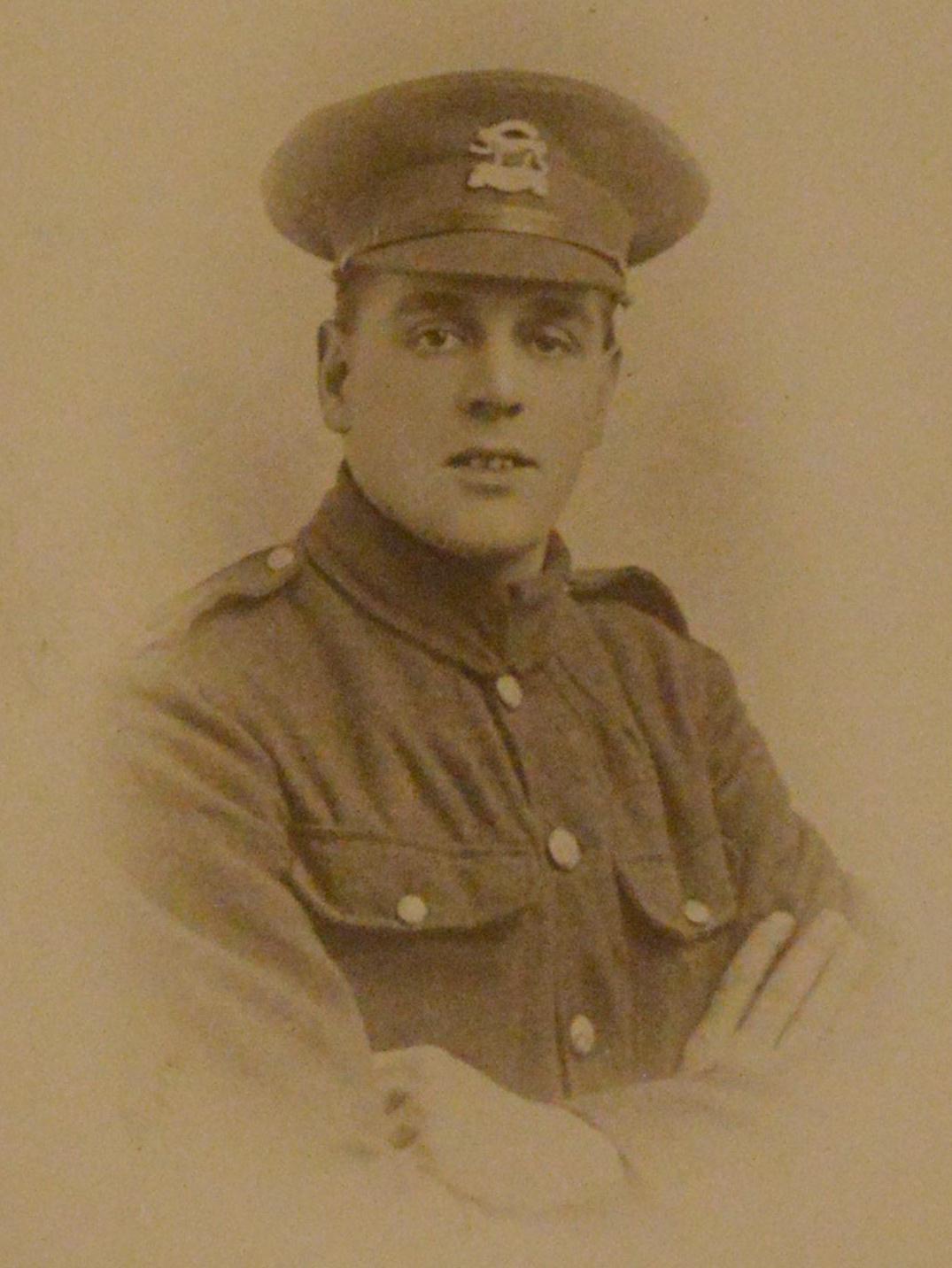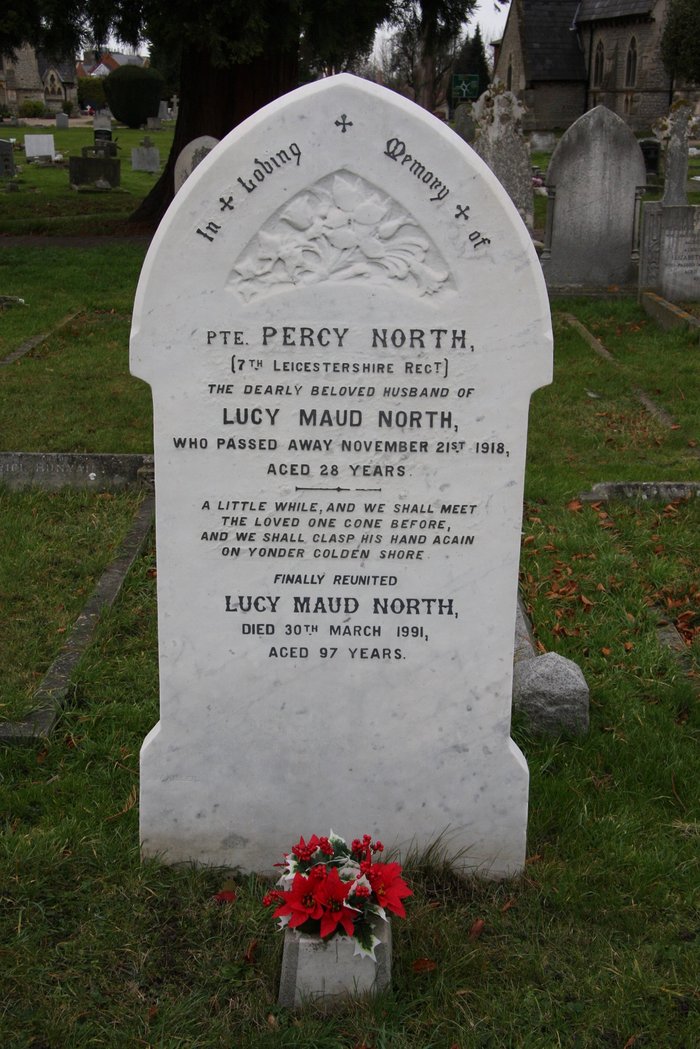|
Private 15632 Alexander MacIntosh
|
|
7th Bn, Leicestershire Regiment.
Killed in action 30th January 1916, Aged 22.
Buried Bienvillers Military Cemetery, I. A. 84.
|
Alexander MacIntosh was born in Christchurch, Hampshire, in 1892, the son of James
MacIntosh, a Scot from Ross-shire, and his Welsh wife Helen (née Tedstone) who were
married in Downton, Wiltshire in 1889. Alexander had a younger brother Alfred and a younger
sister Honor. Alexander's father was slightly deaf and earned his living as a gardener. In 1901
the family lived at Hordle, Hampshire, but by 1911 they had moved to Careys in Brockenhurst.
Between 1911 and 1913 Alexander must have left home for Loughborough as on 7th January
1914 he married a Loughborough girl, Alice May Pidcock, at Loughborough Register Office
and at the time of his marriage he was an ironmonger's assistant for Clemersons Ltd. He was
also 'an energetic and much esteemed worker in connection with the Loughborough Adult
School' and a member of the Baptist Church. His parents later moved to The Gardens,
Wainsford, near Lymington, Hampshire, while his wife remained in Loughborough at 22
Wharncliffe Road.
Alexander enlisted on 10th October 1914 at Leicester and was posted as Private 15632 to the
7th (Service) Battalion of the Leicestershire Regiment. He had previously served with the
Hampshire Territorials and was sent to Aldershot for further training. In April 1915 his battalion
was moved to Cholderton on Salisbury Plain, and on 25th June they were inspected by King
George V at Sidbury Hill. On 29th July 1915 they received orders to proceed to France.
Although Alexander had been appointed a Lance Corporal on 5th March 1915 he was
unfortunately deprived of his 'Lance stripe' in the field on 15th September - the reason for this
remains unrecorded.
Alexander was involved in various trench warfare activities on the Western Front in the Arras
area for the remainder of 1915. On 30th January 1916 the battalion had just relieved the 9th
Leicesters in the trenches at Bienvillers-au-Bois to work on support lines and communications.
It was a very foggy day and the German parapet could only be seen from the salient. At
'stand-to' in the evening a man was found to be missing. A patrol of four men, including
Alexander who like the other three men had nobly volunteered to look for their comrade
together with an N.C.O. went out to search for the missing man at about 6.00pm. About three-
quarters of the way across to the German wire a very large German patrol was encountered.
The Germans opened fire and the 7th Leicesters patrol retreated, but before they had gone far
Alexander was shot through the heart.
Alexander was 22 when he was killed in action. He was buried in Bienvillers Military Cemetery,
Grave I.A.84. His widow, Alice, was married again, in Loughborough, in 1922, to Edward
Lester.
|
|
|
|
Private G/15091 Alfred Manley
|
|
12th Bn, Royal Sussex Regiment.
Killed in action 21st October 1916, Aged 37.
Commemorated Thiepval Memorial, pier & face 7 C.
|
Alfred Manley was born in Borrowash, Derbyshire, in 1879, the son of Alfred Manley and Elizabeth Jane Manley (née Wall). Alfred Junior's parents were married at All Saints' Church, Ockbrook, Derbyshire, on 29th June 1874. Alfred's father was a general labourer and in 1881 his mother was a cotton factory operative. Alfred Junior had six brothers Joseph, George, Edward, Edwin, Robert and Walter and four sisters Annie, Agnes, Lavinia and Violet. In 1881 Alfred's parents were living in Turnpike Road, Borrowash, with young George and Edwin while Alfred Junior and his siblings Joseph and Annie were with their grandparents Joseph and Hannah Wall in Chapel Row, Nottingham Road, Borrowash. By 1891 the children were all back with their parents at No.14 Chapel Row, Borrowash.
In 1899 Alfred Junior, who had become a general labourer like his father, married Elizabeth Agnes Brooks in Loughborough and the couple set up home at 3 Court C, 9 Pinfold Gate. By 1911 Alfred Junior had become a theatre carpenter and lived with his wife and family at 13 Rectory Place, Loughborough. They now had four children Alfred, Annie, Elizabeth and Violet Kate (known as 'Kitty'). Kitty, however, sadly died between April and June 1911. Another son John born in early 1915 died a few months later.
Alfred Junior's service papers have not survived and it is therefore impossible to establish when he enlisted with the Leicestershire Regiment as Private 4676. At some point he transferred to the 12th (Service) Battalion of the Royal Sussex Regiment (2nd South Down) as Private G/15091 but again the date of transfer is unknown. It is possible, however, that he was sent to France in March 1916 when the 39th Division of the Army received substantial reinforcements which included the 12th Battalion of the Royal Sussex Regiment. Alternatively he may have joined the 12th Battalion of the Royal Sussex Regiment in France on 24th July 1916 or 4th or 12th September 1916 when the battalion received drafts of extra men. One detail is certain -Alfred was not in France before 1916 as he was not awarded the 1914/15 Star Medal.
In March 1916 the 12th Battalion of the Royal Sussex Regiment, having landed at Le Havre, joined its Army division which was concentrating at Blaringhem. The battalion then moved via Morbecque, Estaires, Fleurbaix, La Gorgue, Caudescure and Riez- du-Vinage to the Givenchy sector where it went into the front line from 15th -30th April. The month of May was spent in the village line at Festubert with rest periods at Le Touret or Chocques. In June the battalion was in the village line or front line at Cuinchy and Ferme du Bois with rest periods at Le Quesnay. On 30th June the battalion attacked the enemy at Ferme du Bois near Richebourg l'Avoué and suffered heavy casualties.
July was spent in village trenches at Annequin and the front line trenches near Cuinchy with billets at Festubert and Le Hamel. On 6th August the battalion took over the village line at Givenchy. Between 14th and 22nd August training took place in Monchy-Breton following which the battalion moved to Englebelmer and reconstructed the front line in front of Hamel amid continual enemy shelling.
On 3rd September the battalion successfully attacked the enemy's position near the River Ancre but were unable to hold the position. They returned to Englebelmer for a period of training until 10th September when they took over the front line at Auchonvillers. After a break in billets at Beausart they went into the trenches at Redan where they were heavily shelled.
They remained in the Auchonvillers area in October and moved to the Schwaben Redoubt on 15th where a heavy enemy barrage caused many casualties. On 17th October the enemy began a particularly heavy bombardment of the Redoubt with 28 inch shells. The casualty figures were 5 officers and 156 other ranks. In October the battalion was in billets at Aveluy. On 21st October 1916 the battalion marched to the Schwaben Redoubt to take part in an attack on the enemy and Alfred, aged 37, was killed in action. He is commemorated on the Thiepval Memorial, Pier and Face 7C, on the memorial at All Saints' Church, Ockbrook, on the war memorial in Victoria Avenue, Ockbrook, on the memorial at All Saints' Church, Loughborough, and on the Carillon.
|
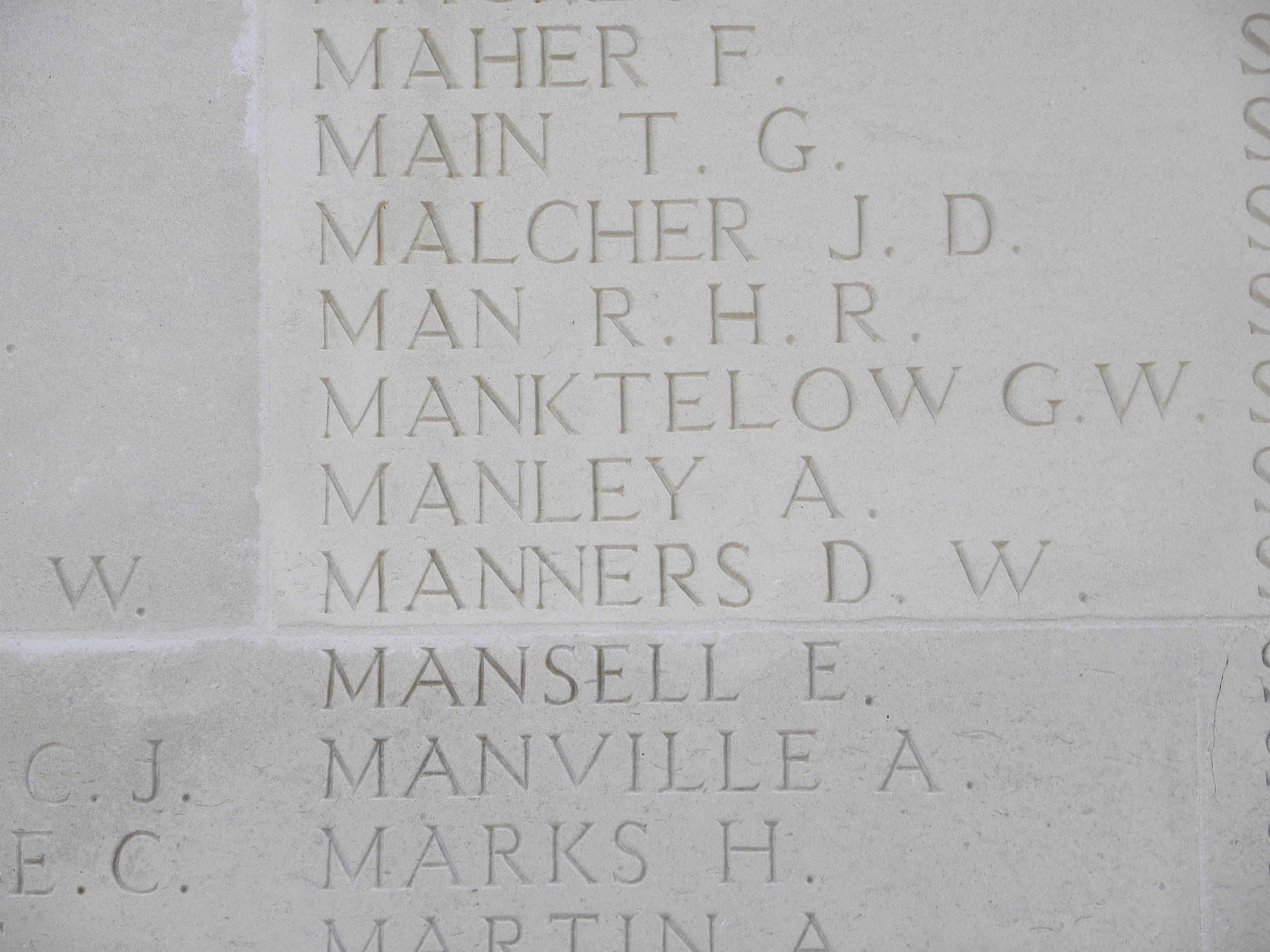
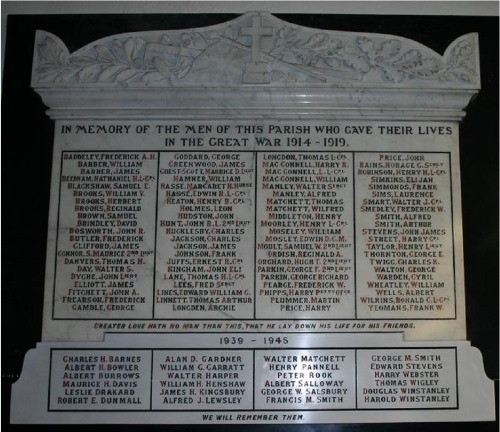 Memorial All Saints' Church, Ockbrook
Memorial All Saints' Church, Ockbrook
|
|
Corporal 235365 Horace Manley
|
|
8th Bn, Leicestershire Regiment.
Formerly 255764 Leicestershire Yeomanry.
Killed in action 27th May 1918, Aged 24.
Commemorated Soissons Memorial, Aisne.
|
Horace Manley was born in Derby in the summer of 1894. He was the son of Joseph Manley, a bricklayer, and his wife Rebecca (née Sharp) who were married on Christmas Day 1893 at All Saints Church, Ockbrook, Derbyshire. Horace had one sister Violet, born in 1895. By 1901 the Manley family had moved to Loughborough and were living at 41 New King Street, By 1911 Horace's father appears to have left his family and his mother, who was now employed as a hosiery linker in an underwear factory, was living with Violet at 6 Holland Street. Horace, meanwhile, aged 16, was working as a general servant at Thomas Jackson's farm in Hoton Hills. Some records suggest that Horace's father may have gone to Canada or the USA and remarried in Queen's, New York City, in 1925. Horace's mother, at any rate, was remarried to George H. Hoult in Loughborough in 1912 and subsequently lived in Southfield Road.
Horace joined the 8th (Service) Battalion of the Leicestershire Regiment as Private 235365, having previously served with the Leicestershire Yeomanry as Trooper 255764.
The exact dates when Horace left the Leicestershire Yeomanry and joined the Leicestershire Regiment and when he was sent to France are unknown as his service record has not survived. His medal record indicates that he was not sent abroad until sometime in or after 1916. He was certainly in Leicester in late 1915 or early 1916 as he married Mary Elizabeth Hutchinson of Enderby in Leicester at that time. Horace's service number with the Leicestershire Yeomanry also indicates that he was with the Yeomanry until at least April 1917 but whether he was sent abroad with the Yeomanry before joining the 8th Leicesters is also unknown.
The war diary of the 8th Battalion of the Leicestershire Regiment unfortunately does not include details of when the battalion received batches of reinforcements after 1st April 1917. Horace could have joined the 8th Leicesters at any point after that date.
In April 1917 the 8th Battalion was near Hamelincourt occupying the Outpost Line on the Hénin-Croisilles road until 13th April. The battalion then transferred to Bailleulmont for training before going into support at St. Leger. On 3rd May the battalion took part in an attack on the village of Fontaine-lès-Croisilles where casualties were high. After the attack the battalion bivouacked at St. Leger before going back into the line on 9th May. On 11th May the battalion marched to Berles-au-Bois for musketry training and practice in tactical schemes, brigade sports and inspections which lasted until the end of May.
On 1st June the battalion marched to huts in Hamelincourt for additional training in bombing and rifle grenades and field exercises until 7th June. On the night of 7th/8th the battalion went into the trenches in the Hindenburg Line. From there they attacked the enemy on 15th June but were compelled to withdraw. They remained in the front line until 19th June when they returned to camp at Hamelincourt. A period of rest at Blairville then lasted until 1st July, after which the battalion returned to Hamelincourt. On 9th July 1917 the battalion was in the trenches near Croisilles before going into Brigade Reserve. After one more front line trench tour at Croisilles the battalion moved to Camp A at Moyenville for eight days training. Following this the battalion was in brigade Support in the forward area until 17th August when it moved to a hutment camp in Ervillers for training. On 25th August the battalion moved by motor bus to Barly and from there, on the following day, marched to Ambrines. Two further periods of training followed, firstly at Ambrines and then at Avesnes-le-Comte.
On 16th September the battalion marched to Savy, entrained for Caestre and went into camp for more training. On 23rd September the battalion began a series of moves, firstly to Meteren, then by bus to Hallebast before marching to Sint Hubertushoek and from there to Ridge Wood south-west of Ypres. On 30th September they moved up to the front line at Polygon Wood.
On 1st October the enemy attacked the 9th Leicesters who were nearby and got possession of their front line. The 8th Leicesters went to assist but the enemy made repeated attacks. Counter-attacks were hit by a heavy enemy barrage in the neighbourhood of Joist Farm. On the night of the 2nd/3rd October the battalion was relieved and marched to Scottish Wood Camp. On 4th October the 8th and 9th Battalions of the Leicesters were amalgamated because of their high casualty rate. On 5th October the combined battalion moved to railway dugouts at Zillebeke and on 7th they went into the front line. The weather was very wet, the men suffered severely in the open trenches and shell holes and on 8th and 9th October 53 Ordinary Ranks were killed or wounded.
Relieved on 11th October the battalion moved to Anzac Camp where the combined battalion was restored to two units. On 12th October the 8th Battalion entrained at Ouderdom station for Ebblinghem and marched to Le Croquet. From here three days later the battalion moved by motor lorry to the Gheluvelt area on the Menin Road for six days of cable trench digging. The men worked under heavy hostile barrages, moving to and from the area under shellfire. Between 17th and 22nd October 86 Ordinary Ranks were killed, wounded or went missing.
Five days at Camp A, Kruistraat crossroads, for reorganisation and training followed, after which the battalion went into Brigade Reserve in railway dugouts south-west of Zillebeke Lake to work on cable trenches. While moving into the front line on the night of 3rd/4th November the battalion suffered heavy casualties from a hostile gas shell bombardment and were withdrawn to Divisional Reserve at Camp A. Between 9th and 16th November the battalion completed another front line trench tour as well as four days in the support trenches at Zillebeke Bund. On 17th November they began a six-day march from Pioneer Camp near Scottish Wood to Coupigne for five days cleaning and reorganisation, and then marched to Monchy Breton.
On 30th November the battalion was suddenly ordered to entrain at Savy for Cambrai in order to reinforce the line there on account of a large scale German attack. From Courcelles on 1st December the battalion moved into the support line and into the front line on the following day. Four more trench tours took up most of December and in between tours the battalion concentrated on improving the village defences of Epehy with barbed wire entanglements.
From Epehy, on 4th January 1918, the battalion moved back to Middlesex Camp, Heudecourt, in Brigade Reserve. Between 11th and 20th January the battalion was in training at Haut Allaines and working on wiring and tunnelling at Saulcourt. Two more trench tours in bad weather when the sides of the trenches kept falling in completed the month.
February 1918 included trench tours at Epehy, ten days at Noislains for training, digging a fire trench near Gurlu Wood, work on new aerodromes at Cartigny and near Nurlu and digging the main line of defence near Pezière.
In early March it became clear that the enemy was preparing for a large-scale attack. On 21st March the Germans opened their Spring Offensive, advancing in formation and accompanied by a bombardment of every description. The battalion, still in the neighbourhood of Epehy, suffered heavy casualties on the front line between 21st and 23rd March. On the night of the 23rd March the battalion moved into a position north-east of Cléry-sur-Somme but was forced into a further withdrawal on the following day when the enemy began an outflanking action. After moving to Bray-sur-Somme, Chipilly, and then Bresle, the nucleus of the battalion moved to the chateau at Vadencourt while the remainder operated in the Bray-Chipilly-Morlancourt-Ribemont area. By 31st March the entire battalion, which had suffered 415 casualties since 21st March, was at rest in Allonville.
On 1st April the battalion entrained at St. Roch station, near Amiens, for Hopoutre and proceeded by lorry to Monmouthshire Camp, near Dranoutre. Between 4th and 9th April they moved via Kemmel Shelters Camp, Curragh Camp near Westoutre and Ontario Camp near Reninghelst to Manawatu Camp near Zillebeke Lake. From 10th-13th April the battalion was in close reserve at Torr Top and Canada Tunnels before taking over the front and support lines for two days. On 15th they were ordered to withdraw to Forrester Camp near the Ypres-Kruistraakhoek road but when this was shelled, moved to the trenches. Between 18th April and the end of the month the battalion valiantly defended a line of posts, covering gaps wherever the enemy broke through.
May began with a two-day break at Buysscheure for seven days of training, after which the battalion entrained at Wizernes for Serzy-Savigny. Training continued at Aougny and then at D Camp, Chalons de Vergeur near Bouvancourt. On 20th May the battalion went into the trenches east of the Aisne-Marne Canal between Cauroy and Cormicy. On 26th May the enemy began a heavy bombardment along the whole of the Aisne front and began penetrating the battalion's trenches.
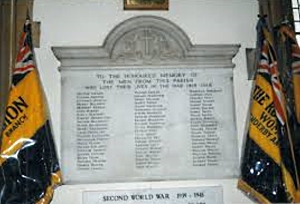
Memorial,
St. John the Baptist Church, Enderby
Horace, aged 24, was killed in action on 27th May 1918 in the 3rd Battle of the Aisne. His body was never found and he is commemorated on the Soissons Memorial, Aisne. He is also remembered on the memorial at St. John the Baptist Church, Enderby and on the Carillon.
Horace's widow, who lived at 103 Haddenham Road, Leicester, married Saxon H. Parker in the Leicester district in 1923.
|
|
|
|
Sergeant 2147 Reginald Frank Manning
|
|
1/5th Bn, Leicestershire Regiment.
Died at Home 6th January 1919, Aged 20.
Buried Loughborough Cemetery, 6-257
(his brother William Manning also fell see below)
|
Reginald Frank Manning was born in the summer of 1898 in Loughborough and baptised on 21st August 1904 at All Saints Church, Loughborough. He was the youngest son of William Manning and his wife Beatrice (née Ball) who were married in the Ashby de la Zouch registration area in the summer of 1880.
Reginald's father began his working life as a railway clerk. He later became an agent for brick and paper and then a commercial traveller in oil and grease products. From Heather the Manning family moved to Measham and by 1901 had settled at 15 Gordon Street, Loughborough. In 1904 they were living at 80 Ratcliffe Road. After Beatrice Manning died in 1904, aged 42, the family moved to 74 Oxford Street, Loughborough and in 1915 Reginald's father was remarried to Florence Bishop. His father and his new wife then moved to 24 Clarence Street.
Reginald had three brothers James, William Junior and Louis and three sisters Maud, Beatrice Alice, and Arabella. Another brother Bertram died, aged three months, in 1894 and another sister Louisa died, aged two in 1883. He also had a half-sister Florence from his father's second marriage.
Reginald was only 16 when he enlisted on 29th August 1914. His medical report noted that his 'physical development [was] poor [but] may improve'. Reginald joined the 1/5th Battalion of the Leicestershire Regiment as Private 2147.
After a training period in Luton Reginald's Battalion sailed for France on 26th February 1915 in very rough seas. They travelled by train via Rouen, Abbeville and St. Omer to Arneke where they detrained for Hardifort. The battalion was then held in reserve for, but did not take part in the Battle of Neuve Chapelle. For the whole of April they were in trenches near Wulverghem and subjected to continual sniping by the enemy, and then moved on to Zillebeke, followed by a tour in the area of Mount Kemmel. After this they were moved to a slightly different part of the line to relieve the Sherwood Foresters.
From July to September 1915 the battalion was in the area of Zillebeeke and Ouderdom, before moving to Hesdigneul in October, La Couture in November and Merville and Thienne in December. January 1916 was taken up with a potential move of William's battalion to Egypt which was aborted at Marseilles, the battalion being returned to Candas, and the area of Vimy Ridge.
In mid-February 1916 the 1/5th Battalion took over the line north of the River Ancre opposite Beaumont-Hamel in France. On 29th February the battalion moved to the area of Doullens where the men worked on improving the trenches despite being subjected to a considerable bombardment from the enemy with mines and craters being blown.
In mid-February 1916 the 1/5th Battalion took over the line north of the River Ancre opposite Beaumont-Hamel in France. On 29th February the battalion moved to the area of Doullens where the men worked on improving the trenches despite being subjected to a considerable bombardment from the enemy with mines and craters being blown.
From 9th March 1916 the 1/5th Leicesters were in the area of Vimy Ridge, Pas de Calais, either in the front line, in support, in reserve or at rest. On 27th April the battalion was sent to the neighbourhood of Neuville St. Vaast to work with the French and English tunnellers and then to billets in Luchaux for bayonet training. This was followed by a period at Souastre digging cable trenches, and constructing bomb stores and gun pits in preparation for a 'big push'.
On 4th June 1916 the battalion was moved up to trenches near Gommecourt. This was followed by further training at Warlincourt. On 30th June the battalion assembled in a trench near Foncquevillers Church ready for the diversionary attack at Gommecourt on the first day of the Somme Offensive planned for 1st July.
On 1st July 1916 the 46th Division of the Army, of which the 1/5th Leicesters were part, had 2445 casualties at Gommecourt. On 7th July they relieved the 4th Lincolnshires in the trenches opposite Essarts-lès-Bucquoy. The battalion remained in the area of Monchy-au-Bois until 29th October, either in the trenches or resting at Bienvillers or Pommier. On 19th July, however, Reginald was sent back to England. The reason for his return is unknown, but it is likely that his health had deteriorated.
Reginald appears to have been given an administrative job until 3rd November 1916 when he was posted to the 4th (Reserve) Battalion of the Leicesters. On 1st January 1917 Reginald was discharged from the Army as unfit for service. Although he was only 18 years old he had already achieved the rank of Sergeant.
Reginald died in Loughborough on 6th January 1919, aged 20. The cause of death was reported as 'heart displacement'. His funeral service was held at All Saints Church, led by the Reverend G. W. Briggs and the hymn 'Rock of Ages' was sung. Escorted by a contingent of his former battalion, the 5th Leicesters, and a number of discharged and wounded soldiers, the cortege proceeded to Loughborough Cemetery. The burial was given full military honours, with a firing party in attendance and the 'Last Post' being sounded.
Reginald is commemorated on the memorial in All Saints Church, Loughborough, on the memorial in the former St. Peter's Church building, Loughborough, and on the Carillon.
All three of Reginald's brothers served in the war. William, who served with the Norfolk Regiment, died of wounds in 1918. James who served with the Coldstream Guards survived the war and Louis, whose regiment is unknown, was discharged from service.
|
|
|
|
Lance Corporal 204287 William Manning
|
|
9th Bn, Norfolk Regiment.
Died of Wounds 9th August 1918, Aged 27.
Buried Esquelbecq Military Cemetery, II. F. 4.
(his brother Reginald Manning also fell see above)
|
William Manning was born in Heather, Leicestershire, in 1891 and baptised at the Church of St. John the Baptist, Heather, on 10th August 1891. He was the son of William Manning Senior and his wife Beatrice (née Ball) who were married in the Ashby de la Zouch registration area in the summer of 1880.
William Manning Senior began his working life as a railway clerk. He later became an agent for brick and paper and then a commercial traveller in oil and grease products. From Heather the Manning family moved to Measham and by 1901 had settled at 15 Gordon Street, Loughborough. In 1904 they were living at 80 Ratcliffe Road. After William's mother died in 1904, aged 42, the family moved to 74 Oxford Street, Loughborough and in 1915 William Manning Senior was remarried to Florence Bishop. William Senior and his new wife then moved to 24 Clarence Street.
William Junior had three brothers James, Louis and Reginald and three sisters Maud, Beatrice Alice, and Arabella. Another brother Bertram died, aged three months, in 1894 and another sister Louisa died, aged two in 1883. He also had a half-sister Florence from his father's second marriage.
William Manning Junior worked as a shop assistant. He joined the 1/5th Battalion of the Leicestershire Regiment as Private 3041 in late 1914. Although his service papers have not survived it is known that he was sent to France on 25th June 1915.
In June 1915 William would have joined the 1/5th Leicestershire Regiment in the area of Zillebeke, south-east of Ypres.
From July to September 1915 the battalion remained in the area of Zillebeke and Ouderdom, before moving to Hesdigneul-lès-Béthune in October, La Couture in November and Merville and Thienne in December.
January 1916 was taken up with a potential move of the battalion to Egypt which was aborted at Marseilles, the battalion being returned to Candas, and the area of Vimy Ridge.
In mid-February 1916 the 1/5th Battalion took over the line north of the River Ancre opposite Beaumont-Hamel. On 29th February the battalion moved to the area of Doullens where the men worked on improving the trenches despite being subjected to a considerable bombardment from the enemy with mines and craters being blown.
From 9th March 1916 the 1/5th Leicesters were in the area of Vimy Ridge, Pas de Calais, either in the front line, in support, in reserve or at rest. On 27th April the battalion was sent to the neighbourhood of Neuville St. Vaast to work with the French and English tunnellers and then to billets in Luchaux for bayonet training. This was followed by a period at Souastre digging cable trenches, and constructing bomb stores and gun pits in preparation for a 'big push'.
On 4th June 1916 the battalion was moved up to trenches near Gommecourt. This was followed by further training at Warlincourt. On 30th June the battalion assembled in a trench near Foncquevillers Church ready for the diversionary attack at Gommecourt on the first day of the Somme Offensive planned for 1st July.
On 1st July 1916 the 46th Division of the Army, of which the 1/5th Leicesters were part, had 2445 casualties at Gommecourt. On 7th July they relieved the 4th Lincolnshires in the trenches opposite Essarts-lès-Bucquoy. The battalion remained in the area of Monchy-au-Bois until 29th October, either in the trenches or resting at Bienvillers or Pommier. The battalion's next move was to Millencourt for intensive battle training, returning to Halloy and then Souastre at the beginning of December.
The battalion remained at Souastre until 11th March 1917 and then moved up to the front line taking over 2,600 yards of frontage from the La Brayelle road to the Hannescamps-Monchy road. On 17th March they moved into Gommecourt for road mending before moving to Bertrancourt, Raincheval and then Rainvillers not far from Amiens.
On 28th March the battalion marched to Saleux, entrained for Lillers in the north, and marched to Laires. Training took place until 13th April and continued for three further days at Manqueville, after which the battalion moved to the western outskirts of Lens. From there they marched to Bully-Grenay and went into the front line trenches where they were heavily shelled. On 29th April the battalion went into rest billets in cellars at Cité St. Pierre until 3rd May when they went into support trenches. On 8th they went into billets at Fosse 10 near Petit Sains for training and on 12th into reserve at Angres. Further trench tours south-west of Lens followed until 26th May when the battalion went into billets at Marqueffles Farm for training in bayonet fighting and bombardment and to practise methods of attack. On 6th June the battalion was back in the line and on 8th June went into the attack, suffering 96 casualties.
Apart from two breaks at Red Mill from 9th-13th and 18th-20th June the battalion was in the trenches until 22nd June. On 21st June C Coy was accidentally gassed by the Royal Engineers, resulting in 94 casualties of whom 22 died. Back at Marqueffles Farm from 22nd the battalion had Lewis gun and signalling classes as well as attack training over a flagged course. On 27th June the battalion moved up to the line ready to attack on the following day. As they climbed out of the trenches on 28th June they met with the inevitable machine gun fire and over the next two days 60 Ordinary Ranks were killed.
Relieved from the trenches at Lievin on 3rd July the battalion moved to Monchy-Breton for reorganisation and training until 22nd July when they moved to Vaudricourt before going into the line at Hulluch until 28th July. After respite at Noeux-les-Mines the battalion was at Fouquières until 14th August, practising for an attack. Moving to Noyelles the battalion went into the trenches from 15th-17th August. The battalion then had drill and instruction in Noyelles from 17th-22nd August before returning to the trenches until 29th August. Two companies were then left in the line and the other two moved to Philosophe.
After Philosophe was shelled on the 1st and 2nd September all the battalion went back in the line from 3rd to 9th September and then marched to Fouquières. Training took place there until 15th September. On 16th September another trench tour began at St. Elie. On 19th September the battalion was visited by Mr. Wilkes of the Leicester Mail 'attired in a grey suit, steel helmet and box respirator'. He went away 'greatly impressed with the cheerfulness of the men'. On 21st September the battalion was relieved. Two companies remained in support and two went to billets in Philosophe. The month ended with the battalion back in the trenches at St. Elie.
At some point in 1917, probably in September, William was sent back to England, the reason for his return being unknown. He then joined the Leicester Regiment's 4th Reserve Battalion at Louth. In early April 1918 he was posted, with a group of other soldiers from several regiments, to No. 12 Infantry Base Depot in Calais. While at the depot he appears for a very short time to have been part of the 1/4th Battalion of the Norfolk Regiment and given the new service number of 203287. He was then posted to the 9th (Service) Battalion of the Norfolk Regiment in the field.
He joined the 9th Norfolks in the Ypres Salient on 20th April 1918. The battalion had just arrived at Vancouver Camp, south of Vlamertinghe and west of Ypres. After some reorganisation and training the men commenced work on the Brandhoek-Ouderdom line. On 26th April the battalion moved up to an assembly point near Belgian Chateau but were not required and returned to Vancouver Camp. On 28th April the battalion moved to a strongpoint west of Ypres.
From 5th to 11th May the battalion worked on strengthening the Vlam line. From 12th to 21st May they guarded strongpoints near the Ypres Canal before moving to Ravine to provide working parties and returned to the trenches on 26th May. Relieved on 6th June the battalion proceeded to Dirty Bucket Camp. From the camp they provided working parties until 14th June when the battalion moved to School Camp for training.
On 20th June there was another move to Cormette Musketry Camp, Martin-au-Laert. For this transfer the battalion entrained at Proven for St. Omer. The return journey to Proven took place on 25th June and from Proven the battalion marched to Bayly Camp in the Rosendahl area south-east of Watou. After two days training the battalion went into the trenches to carry out wiring work on the Dickebusch and Vyverbeek lines, with a break at Micmac Camp. This work lasted until 9th July when the battalion went into the front line in the Villebeek area.
After a short break at Micmac Farm on 19th and 20th July the battalion took up battle positions in the Dickebusch-Scherpenberg line but the expected attack by the enemy never materialised. After two days in Brigade reserve near Malin House the battalion moved to the Westoutre-Goed-Moet Mill sector on 27th July.
During this trench tour William was wounded and he died of his wounds in No. 2 Canadian Casualty Clearing Station on 9th August 1918. He was 27 years old and by the time he died he had been promoted to Lance Corporal. He was buried in Esquelbecq Military Cemetery, Grave II. F. 4. He is remembered on the memorial in All Saints Church and on the memorial in the former St. Peter's Church building, Loughborough, and on the Carillon.
William's brother Reginald who was with the 1/5th Leicestershire Regiment, died in 1919. His brother James served with the Coldstream Guards and survived the war. His brother Louis, whose regiment is unknown, was discharged from service.
|
|
|
|
Corporal 1229 Edward Manton
|
|
1/5th Bn, Leicestershire Regiment.
Died of Wounds 26th March 1916, Aged 23.
Buried Aubigny Communal Cemetery, I. A. 10.
|
|
Edward Manton was born in 1893 in Loughborough, the only son of Richard Manton and Emma Manton (née Spray) who were married in Loughborough in 1892. Edward's father, who originally came from Holbeach, Lincolnshire, was a hot water fitter. Edward had five sisters: Harriett, Lucy, Florence, Edith and Sarah. In 1901 the family lived at 25 Old King Street, Loughborough but by 1911 had moved to 95 Station Street and by then Emma Manton's widowed father had joined the household.
Edward, who in 1911 was an iron moulder's apprentice at the Empress Works, Loughborough, enlisted at Loughborough with the 1/5th Leicestershire Regiment (Territorials) on 21st November in that year. As Private 1229 he underwent training at Aberystwyth. When war broke out in 1914 Edward's battalion was mobilised as part of the North Midland Division, Lincoln and Leicester Brigade. The battalion moved to Luton for further training in marching and night work and by November 1914 was based in Bishops Stortford. On 25th February 1915 they were ordered to entrain at Harlow for Southampton and sailed for France the following day in very rough seas.
Having landed at Le Havre the battalion travelled by train via Rouen, Abbeville and St. Omer to Arneke where they detrained for Hardifort. The battalion was then held in reserve for, but did not take part in the Battle of Neuve Chapelle. For the whole of April 1915 they were in trenches near Wulverghem and subjected to continual sniping by the enemy before being moved to Zillebeke in the Ypres Salient, followed by a tour in the area of Mount Kemmel. Edward was promoted to an unpaid Lance Corporal on 8th August 1915.
At the beginning of October 1915 the 1/5th Leicesters were ordered to move towards Loos. On 13th October during the attack on the Hohenzollern Redoubt, part of the final stages of the Battle of Loos, they went 'over the top' just after midday and came under intense machine gun fire. After the Battle of Loos, which Edward was fortunate to have survived, he went into the trenches between Festubert and Neuve Chapelle and in mid-December moved to the area between Haverskerque and Thiennes. On 4th December Edward was promoted to Corporal.
In early January 1916 the Battalion was sent to Marseilles to await transport to Egypt. They had only just embarked on H.M.T. Andania when orders came that they were to disembark and travel back to the Somme area of Picardy. In mid-February orders came for the battalion to take over the line north of the River Ancre opposite Beaumont Hamel. On 29th February the battalion moved to the area of Doullens where the men worked on improving the trenches despite being subjected to a considerable bombardment from the enemy with mines and craters being blown.
On 24th March 1916 Edward, wounded and suffering from concussion, was admitted to the 1st North Midlands Field Ambulance, from where he was transferred to No. 30 Casualty Clearing Station at Gezaincourt and admitted to hospital. He died on 26th March, aged 23, and is buried in Aubigny Communal Cemetery Extension, north-west of Arras, Grave 1.A.10.
|
|
|
|
Private 15465 Edward Revell Marriott
|
|
6th Bn, Leicestershire Regiment.
Killed in Action 16th March 1916, Aged 24.
Buried Bienvillers Military Cemetery, I. A. 91.
|
Edward Revell Marriott was born in 1892 in Loughborough, the son of Charles Samuel Marriott and Jane Elizabeth Marriott (née Clarkson). His parents were married in Loughborough in 1881 and his father was an ironmonger and coal dealer. Edward had one older brother Charles Ernest and three sisters Mabel, Evelyn and Ellen. Until 1901 the family lived at 1 Dead Lane, Loughborough, but by 1911 had moved to Churchgate and Edward was now assisting his father in the business. Edward's mother Jane died at the end of 1911.
Edward enlisted at Loughborough on 23rd September 1914. He was almost 23 years old and now a motor lorry driver. He was sent to the Leicestershire Regiment Depot and a month later was posted to the 6th (Service) Battalion which was attached to the 9th (Scottish) Division of the Army. The troops trained in Bordon, Hampshire, and gradually arms and equipment were obtained. In April 1915 they were transferred to the Army's 37th Division at Cholderton on Salisbury Plain and shortly afterwards judged to be ready for war. King George V inspected the Division at Sidbury Hill on 25th June.
Edward's battalion entered France on 29th July 1915 and joined the rest of the 37th Division which was concentrating at Tilques, near St. Omer in the Nord-Pas-de-Calais. In September the battalion was in Berles-au-Bois, south-west of Arras. The battalion remained in the Amiens/Doullens area for the following six months and were engaged in localised operations seeking a tactical advantage. Edward was killed near Bienvillers on 16th March 1916, aged 24. He is buried in Bienvillers Military Cemetery, Grave I.A.91.
Edward is remembered on the All Saints with Holy Trinity Memorial, Loughborough, as well as on the Carillon.
|
|
|
|
Private 1027387 Henry Marriott
|
|
3rd Bn, Canadian Infantry (Central Ontario Regt.)
Previously 9527 Lancashire Fusiliers and 5609 Leicestershire Regiment.
Killed in Action 30th August 1918, Aged 42.
Buried Valley Cemetery Vis-en-Artois, A. 10.
|
Henry Marriott was born in Loughborough on 9th January 1876 and baptised on 2nd April 1876. He was the son of John Marriott and his wife Hannah (née Mimack, or Mimmack) who were married at the Church of St. Peter at Gowts, Lincoln, on 4th May 1857. Henry's father was originally a farm worker in Doddington, Lincolnshire, but later on he became a milk seller in Loughborough. Henry had one brother Joseph and two sisters Rhoda and Fanny. He also had a half-sister Mary Ann, born in the Lincoln Workhouse before his mother married John Marriott. By 1875 the Marriott family had left Doddington and was living at 75 Freehold Street in Loughborough.
By the early 1890s Henry was lodging at 147 Plodder Lane, Bolton, Lancashire, and working as a labourer for a Mr. Bridge. On 18th April 1893 he attested at Bury to join the 3rd (Territorial) Battalion of the Lancashire Fusiliers. He served as Private 9527 with them from 18th April 1893 to 28th July 1894. In 1894 Henry returned to Loughborough and settled at 8 Albert Terrace, High Street, Loughborough.
On 23rd November 1899 Henry attested again, this time at Loughborough, to join the Leicestershire Regiment. Curiously he did not declare his previous service with the Lancashire Fusiliers. Now aged 23, still a labourer and with a tattooed cross on his left arm, he was sent to the Leicester Depot at Glen Parva and numbered as Private 5609. He was following the example set by his older brother Joseph who served with the Leicestershire Regiment and with the South Wales Borderers in Nova Scotia, Jamaica, Egypt and South Africa.
On 4th February 1901 Henry was posted to the 2nd Battalion of the Leicestershire Regiment and sent to the garrison in Egypt. On 31st January 1903 he was transferred to the 1st Battalion and posted to Fort St. George, Madras, India, at a time when the Raj was at the height of its power. Henry remained in India for over four years, returning to England on 9th November 1907 and transferring to Army Reserve. He was twice awarded a Good Conduct Badge.
In late 1907 Henry married Emma Joynes in Loughborough, whom he had met through his sister Fanny who had married Herbert Joynes, Emma's brother. On 2nd January 1908 Henry and Emma emigrated to Canada, sailing from Liverpool to Halifax, Nova Scotia, on the SS Dominion. In Canada they took up residence at 198 Queen Street, Campbellford, Northumberland County, Ontario. Henry was employed as a carpenter and labourer and their son Lawrence Herbert was born on 15th August 1912.
Henry enlisted at Campbellford to join the Canadian Expeditionary Force on 28th September 1916 and joined the 235th Battalion as Private 1027387. He embarked on the SS Megantic at Halifax, Nova Scotia, on 3rd May 1917. He arrived at Liverpool on 14th May and proceeded to West Sandling Camp, near Saltwood, Kent. He was immediately transferred to the 3rd Canadian Reserve Battalion and appointed an Acting Corporal. On 19th June he was transferred to the 134th Battalion, reverted to the rank of Private, and sent to Witley Camp in Surrey.
On 6th March 1918 Henry was posted to the Canadian Base Depot in Etaples and sent to France. Five days later he left Etaples for the Canadian Corps Reinforcement Camp at Aubin Saint-Vaast and on 23rd March joined the 3rd Battalion (Central Ontario Regiment) of the Canadian Expeditionary Force in the field at the Bois de Froissart near Hersin.
After several days of physical training and one day 'Standing to' the battalion moved by bus to Mondicourt and on to Dainville. On 30th March they went into support near Beaurains and then into the front line until 4th April. Between 5th and 9th April the battalion moved from Dainville to Villers-au-Bois and on to Louez. From 12th-28th April they were in the front and support lines in the Fampoux section, after which they moved to billets in Maroeuil and provided working parties on a trench south of Anzin.
The first days of May were spent at Maroeuil and Le Pendu and included instruction in wiring and games of football and baseball. The battalion then moved to Izel-lès-Hameau for further training (range firing, Lewis gun classes, signalling and attack practice) until 18th May. There was also a boxing tournament and the YMCA put on a cinema show. On 15th and 16th May the battalion took part at Ambrines in practice for a brigade tactical scheme. On 19th they returned to Louez for trench digging on the Arras West line and the men enjoyed bathing in the River Scarpe. May concluded with a battalion concert party, a flat oar being used as a stage.
During June and the first part of July the battalion was based at Caucourt, in the area of Chelers and Magnicourt, and at Marne Camp, Agnez-lès-Duisans. During this time there were practices in tactical schemes, a rehearsal of night manoeuvres in the Berthonsart training area and Divisional sports at Tinques. Towards the end of June a flu epidemic broke out and on 29th June eighty-five cases were recorded, including the Commanding Officer. On Dominion Day (1st July) training was cancelled and the Duke of Connaught and numerous French generals attended a parade accompanied by the Brigade band.
On 8th July the battalion began working on defence systems at Brunehaut Farm and between 12th and 15th July moved up to the front line by bus. During this trench tour they completed wiring and carried out numerous patrols on the enemy positions and were shelled by the enemy. On 18th July they moved back to Stirling Camp on the railway embankment and then to 'Y' Hutments.
On 23rd July the battalion moved by train from Maroeuil to the area of Neuville-Vitasse and went into the front and support line on the following day. On 26th July the enemy dropped 600 Yellow Cross mustard gas shells on the front followed by trench mortars, scoring several direct hits. Relieved on the last day of July the battalion moved back to Berneville by bus, marched to Warlus and embussed for Beaufort. On 4th August they entrained at Petit Houvin for Rambures and travelled by bus to Boves Wood, south-east of Amiens.
On 6th August they were ordered to move up to the Bois de Gentelles as soon as it was dark. The Battle of Amiens, also known as the 3rd Battle of Picardy began on 8th August and was the opening phase of the Allies' Hundred Days Offensive. It was a decisive Allied victory and a turning point in the war but it cost the 3rd Battalion numerous casualties in the action at Rouvroy-en-Santerre.
For two weeks after the battle the battalion rested and underwent training at Folies before entraining at Prouzel for Tinques and travelling by bus to Dainville. On 27th August the battalion initially moved to assembly positions in the Telegraph Hill area, east of Beaurains, but this position was subsequently changed in preparation for an attack on the Drocourt-Quéant line.
Henry was killed in action, aged 42, on 30th August 1918. He was buried in Valley Cemetery, Vis-en-Artois, Grave A. 10. Henry is remembered on the Campbellford War Memorial, Ontario, and on the Canadian Virtual War Memorial.
|
|
|
|
Private 8882 Joseph Marriott
|
|
1st Bn, Leicestershire Regiment.
Killed in Action 27th October 1915, Aged 24.
Buried Potijze Burial Ground, Ypres, EI. 2.
|
|
Joseph Marriott, known as 'Joe', was born in Whitwick, Leicestershire in 1891, the son of James Walter Marriott and Emma Elizabeth Marriott (née Bowley and sometimes known as Emmeline) who were married in Loughborough in 1885. Joe was one of ten children in the family, but two died young. He had one surviving brother George and six surviving sisters Theresa, Alice, Winifred, Jane Ann, Mary and Eva. By 1901 the family had moved from Whitwick to Forest Street, Shepshed. In 1911 they were still in Shepshed, but at Mary's Place, Charnwood Road. They later moved to 17 Falcon Street, Loughborough. Joe's father was an agricultural labourer.
Joe attested at Leicester on 3rd March 1910 and joined the 1st Battalion of the Leicestershire Regiment as Private 8882. In August 1911 he was sentenced to 42 days detention 'for stealing goods belonging to a Regiment'. At the end of November 1911 he was moved to the 2nd Battalion and sent to India on the SS Dongola. He remained in India until 19th September 1914 and was stationed in Bareilly, Madras, Delhi and Ranikhet. Between 1910 and 1914 he was hospitalised seven times suffering variously from scabies, gonorrhoea, and dengue fever.
In August 1914 Joe's battalion was in Ranikhet with the Indian Corps (Gharwal Brigade) in the Meerut Division and was ordered to proceed to France. The troops arrived at Marseilles on 12th October 1914. Having travelled north, Joe went into the trenches at Calonne, near Bethune in the Pas-de-Calais, on 28th October. In mid-November Joe became ill with dysentery, was transferred to a hospital ship and brought home. He returned to France to join the 1st Battalion at Armentières on 19th May 1915 and went into the trenches at Rue du Bois, Fleurbaix, on 20th May. A few days later, however, he was again admitted to hospital. He convalesced at Le Havre and rejoined his battalion near Ypres where the men were often subjected to shelling, whizz-bangs and gas attacks. On 19th, 20th and 31st July they fought in the action at Hooge and were part of the first division to be attacked by flamethrowers or 'liquid fire'. The British retook Hooge on 9th August. From mid-August, and during September and October Joe's battalion was variously in the Weltje Line, at Vlamertinghe, at the Ypres-Yser Canal Bank, 'Frascati' (Ypres), La Brique (NE of Ypres), Morteledge Farm near Ypres and in the Potije Line. Joe was killed in action on the Potije Line on 27th October 1915, aged 24, and was buried at Potijze Burial Ground, near Ypres, Grave El.2.
|
|
|
|
Private 10183 Thomas Marshall
|
|
6th Bn, Leicestershire Regiment.
Killed in Action 8th October 1915, Aged 20.
Buried Berles-Au-Bois Churchyard Extension, S.11.
|
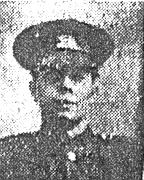
|
|
Thomas Marshall, known as 'Tom', was born at 60 Woodgate, Loughborough in 1894. He was the son of Albert Marshall, a boiler maker, and his wife Sarah Ann Marshall (née Gould) a runner in a hosiery factory, who were married in Loughborough in 1889. Tom was one of eleven children in the Marshall family, but only five of his siblings survived, like him, to adulthood: Ethel, Florence, Edith, Alice and Albert. By 1911 the family had moved from Woodgate to 4 Albert Place, Loughborough.
When war broke out Tom was a boiler riveter and aged almost twenty. He enlisted at Loughborough on 15th August 1914 and joined the 6th (Service) Battalion of the Leicestershire Regiment as Private 10183. This Battalion was attached as army troops to the 9th (Scottish) Division of the Army. Initial training was at Salisbury in August 1914, and continued at Bordon, Hampshire, from September 1914. In April 1915 the battalion was transferred to the 37th Division of the Army at Cholderton on Salisbury Plain and by the end of May was considered to be ready to join the British Expeditionary Force in France. On 25th June the 37th Division was inspected by King George V at Sidbury Hill and on 28th July Tom embarked for France. By 2nd August Tom was near Tilques.
Tom was killed near Berles-au-Bois, Pas de Calais, on 8th October 1915, aged 20.
The War Diary records, '6.15pm Battalion relieved in the trenches by 8th Bn. Leicestershire Regt. and returned to billets at Berles au Bois for the night 8/9th Oct. casualties 8th Oct. 1 man killed, Lt. M. C. Hill wounded in knee by rifle bullet late in the evening.'
The Loughborough Echo reported:
'News has been received from the front of the death whilst in action of Private Tom Marshall, 6th Leicesters and Private J. Ireland, 2nd Leicesters, both Loughborough lads and associated with the Church Lads Brigade'.
Tom's medals and ID disc are displayed in the Carillon War Memorial Museum.
|
|
|
|
|
|
Major William Francis Martin
|
|
C Sqdn, 1/1st Leicestershire Yeomanry
Killed in Action 13th May 1915, Aged 39.
Buried Oosttaverne Wood Cemetery VI. H. 23.
|
|
William Francis Martin was born in 1876 at Whitehaven, Cumberland, and baptised on 8th March 1876 at St. James's Church, Whitehaven. He was the younger son of Robert Frewen Martin JP, a civil engineer and the managing partner of Mountsorrel granite quarry, Leicestershire, and his wife Henrietta Susan (née Larken). William's parents were married on 30th October 1873 at the Church of St. John the Baptist, Burton-by-Lincoln.
The Martin family lived at The Brand, Woodhouse, Leicestershire, and William was educated at Harrow and Trinity College, Cambridge. He joined the Leicestershire Yeomanry in 1897 and was gazetted 2nd Lieutenant in September 1898. He served in South Africa with the 7th Company of the Imperial Yeomanry in the Second Boer War, receiving the Queen's Medal with four clasps. In July 1901 he was made Honorary Lieutenant and in 1904 a Captain.
The Leicestershire Yeomanry was headquartered in Leicester and C Squadron was based in Loughborough. In 1911 William became a Major in command of C (Loughborough) Squadron.
Major Martin was a Director of the Mountsorrel Granite Company, his father having died in 1912, and he took an active part in public life in Leicestershire. He was also a member of the Cavalry Club and enjoyed hunting and shooting. He and his brother were both Freemen of the City of Leicester.
Major Martin married Violet Anne Philippa, elder daughter of Colonel Walter Wynter of Woodhouse Eaves, Leicestershire, on 13th June 1912 at All Saints Church, Knightsbridge, London. Major and Mrs Martin lived at The Holt, Woodhouse. They had a son Robert Andrew St. George Martin (born 1914) and a daughter Diana Violet Anne (born 1913).
The 1/1st Leicestershire Yeomanry was mobilised on 5th August 1914 and billeted in the village of Palgrave, Suffolk, until 1st November 1914. On 2nd November they entrained at Diss with the horses and travelled to Southampton Docks. They sailed for France, arriving at Le Havre the following day, and proceeded to No. 2 Rest Camp. On 4th November they entrained for St. Omer and marched to Esquerdes where they remained for four days to carry out bayonet and entrenching exercises.
On 11th November they marched to Eecke to join the 3rd Cavalry Division and on the following day proceeded via Poperinghe to Bellewaarde Farm on the Hooge Road east of Ypres. Here they joined the 7th Cavalry Brigade and were sent to the support and reserve trenches. On 16th they moved to billets in Ypres where they were heavily shelled. From 17th - 21st November A and C Squadrons were in the advance, support and reserve trenches east of Zillebeeke and B Squadron was in dugouts near the Menin-Ypres road. From 22nd November to 4th December they were at St. Sylvestre near Caestre refitting and exercising while being on duty in General reserve.
On 3rd December they paraded with the 7th Cavalry Brigade for an inspection by His Majesty the King. From 7th -17th December they were based at Oxlaere and then Berthen for drill and entrenching practice while again being in General reserve. On 18th December they moved to an area south of Hondeghem and the Caestre road. Here classes for reserve stretcher bearers and machine gunners took place. On 22nd December they moved to La Brearde where they remained until 2nd February 1915 for training in an advanced guard scheme, hand grenade and entrenching instruction, route marches and inspections.
On 3rd February they were transported by bus to Ypres and marched to Zillebeke where they took over the front line trenches. They spent several days draining and improving the trenches amid enemy sniping. Relieved on 8th February they moved to billets in Ypres as part of the General reserve. On 11th February there was heavy shelling near their billets and on the following day they moved by bus back to La Brearde. Training took place there until 11th April.
On 12th April they moved to Renescure and on 23rd April marched via Abeele to Godewaersvelde. On 24th they proceeded to Vlamertinghe before moving at night to Reninghelst. On 25th and 26th April they moved via Poperinghe and Watou to Forge, where they left the horses, and returned to Vlamertinghe. On 27th they were shelled out of their huts and bivouacked in a field. On 28th they moved to Abeele and over the next three days met up with the Brigade at Forge.
In early May they left the horses at Vlamertinghe and marched to Hazebrouck before going by bus to Brielen near Ypres. On 12th May, as dismounted infantry, they took over the trenches north of the railway near Bellewaarde Farm and immediately became involved in the Battle of Frezenberg Ridge (otherwise called the 2nd Battle of Ypres). During this battle on 12th and 13th May the Leicestershire Yeomanry suffered 186 casualties.
Major Martin, aged 39, was killed at the Battle of Frezenberg on 13th May 1915. Killed in the same trench as Major Martin were Major Leibert, Lt. Brooks, Troopers Hickling and Adams and Sgt. Burton.
Major Martin was buried in Oosttaverne Wood Cemetery Grave VI. H. 23.He is commemorated on the Woodhouse Eaves War Memorial. He is also remembered on the Harrow School War Memorial website and on the Trinity College, Cambridge, War Memorial.
Major Martin's older brother, Lieutenant Colonel Robert Edmund Martin, who was with the 1/4th Leicestershire Regiment, was wounded twelve days after his brother was killed but survived the war and in 1925 married the widow of Captain Lawrence Peel.
|
|
Major W. F. Martin is seen here leading off C. Squadron,
in the Market Place Loughborough, on mobilization in 1914.
|
|
|
|
Private 15905 John William Mason
|
|
Depot, Leicestershire Regiment.
Died at Home of Wounds 4th February 1916, Aged 25.
Buried Loughborough Cemetery 11/312
|
John William Mason was born in Mansfield, Nottinghamshire, in 1891. He was the son of John
Henry Mason and Clara Mason (née Smith). His parents were married in Loughborough in
1888. John had three brothers Albert, Thomas and Herbert and three sisters Ivy, Edith and
Mabel. In 1901 the family lived at 55 Ashby Square, Loughborough and John William's father
was a hosiery trimmer at a dye works. By 1911 the family had moved to 23 Granville Street
and John William worked as a fitter's labourer.
John William enlisted on 9th November 1914 and was posted as Private 15905 to the 10th
Battalion of the Leicestershire Regiment. Eight days later he was reposted to the 3rd (Reserve)
Battalion which was in training at Portsmouth. He remained with the 3rd Battalion until 8th April
1915 when he was posted to join the 1st Battalion of the Leicesters and sent to France. He
joined the 1st Battalion which was in Divisional Reserve in billets at Armentières, not far from
Lille and went into the trenches at Rue du Bois, Fleurbaix. At the end of April the battalion
marched to Bailleul, where the men were inspected by Mr. Asquith. They then marched to
Poperinghe and went into trenches in the Wieltje-Ypres area. Here, for most of June and July,
they were often subjected to shelling, whizz-bangs and gas attacks. On 16th July, just before
the action at Hooge, John William received a gunshot wound to the neck. He was treated in
France until 12th September when he was sent back to England. His wound unfortunately
turned gangrenous and John William died at the 4th London General Hospital (King's College
Hospital, Denmark Hill, SE5) on 4th February 1916, aged 25.
John William is buried at Loughborough Cemetery, Grave 11/312. He is remembered on the
Emmanuel Church War Memorial as well as on the Carillon.
|
|
|
|
Private 18600 George Harry Matthews
|
|
7th Bn, Leicestershire Regiment.
Died of Wounds 15th July 1916, Aged 38.
Buried Heilly Station Cemetery II. B. 46.
|
|
George Harry Matthews (or Mathews) was born in Loughborough in 1878, the son of Henry Matthews (or Mathews) and his wife Mary (née Willett) who were married in Loughborough in 1873. George's father Henry was a butcher and he had learnt his trade from his uncle William who was a master butcher with a shop at 34 Market Place, Loughborough. By 1875 Henry was a butcher in Church Gate and by 1887, the year before George was born, he had taken over his uncle William's premises in Market Place. Unfortunately George's father died on 22nd October 1881 but the business was subsequently run by George's mother Mary for many years. George had two sisters Mary Ellen and Annie Maria and as soon as he was old enough he assisted his mother in the butcher's shop. Away from the premises the family lived in School Street and Pinfold Gate at various times in the 1880s and 1890s. In 1901 George, his mother and sister Mary Ellen were living at 17 Rectory Road. By 1911 they were at 14 Cobden Street with the butcher's shop in Market Place still in the name of Mrs. Mary Matthews. George's mother retired by 1916 and died in Loughborough in 1922.
The exact date of George's enlistment is unknown but it seems likely to have been sometime in the spring of 1915 when the 7th (Service) Battalion of the Leicestershire Regiment, which George joined as Private 18600, became part of the 37th Division of the Army. George went to France on 5th November 1915 where his battalion was in the area of Berles-au-Bois, south-west of Arras. The battalion remained in this area around Bienvillers and Bailleulmont until April 1916 and was engaged in localised operations seeking a tactical advantage. When not in the trenches being subjected to enemy shelling the 7th Leicesters received intensive training in bombing, Lewis gunnery, visual signalling and a host of other activities. In April 1916 they were moved to the Doullens area and formed working parties to cut down trees and prepare brushwood for the front line as well as preparing the support trenches in the area. In May they worked on building a new railway line between Le Bret and Bienvillers-au-Bois. Towards the end of May the battalion returned to the trenches in the Bienvillers-Bailleulmont area.
At the beginning of July the 7th Battalion moved on to the Somme, leaving Bailleulmont for Souastre on 1st July. Between 4th and 9th July the battalion was held in reserve at Wallincourt, Talmas and Hangest-sur-Somme. On 10th July they left Hangest for Méricourt and went from there by bus to Méaulte. On the following day they relieved the 7th Battalion of the Yorkshire Regiment in the trenches where they were subjected to a slow enemy bombardment. On 13th July they were relieved and marched to Fricourt for a day's rest. On 14th July they were at Mametz Wood and in the attack on Bazentin Wood and Bazentin Le Petit. At some point during this period George was wounded. He died from his wounds on 15th July, aged 38.
George is buried at Heilly Station Cemetery Grave II.B.46. He is commemorated on the war memorial of Holy Trinity Church, Loughborough, and on the Carillon.
|
|
|
|
Private 11263 Robert Mayson
|
|
2nd Bn, Kings Own Scottish Borderers.
Died from wounds while a Prisoner of War 16th September 1914, Aged 20.
Commemorated La Ferté-sous-Jouarre Memorial.
|
|
Robert Mayson was born in Loughborough in late 1893 or early 1894. He was the son of Henry (known as 'Harry') Mayson and his wife Elizabeth (née Elliott) who were married in Nottingham in the summer of 1883. Robert had three brothers Harry Junior, Bertie and Lawrence and two sisters Charlotte and Rose. Another brother James died aged 3 in 1889. Another sister Charlotte died in 1901 aged 17 and another sister Ruth died aged 7 in 1908.
Robert's father was an iron moulder. The family originally lived in Nottingham but by 1891 had moved to Loughborough, settling firstly at 33 Pinfold Street and then, by 1901, at No. 13 in the same street. In 1911 they were living at 16 The Avenue, Gladstone Street, and in 1914 at 19 Gladstone Street. In 1911 Robert, aged 18, was employed in a brickyard.
Robert enlisted as Private 11263 with the King's Own Scottish Borderers. His precise date of enlistment, however, is unkown as his service record has not survived. He was sent to France to join the 2nd Battalion of the regiment on 15th August 1914. On 16th August the battalion stayed at No. 3 Rest Camp and on the following day entrained at La Gare Maritime. They arrived in Landrecies on 18th August and marched to billets in Maroilles. On 21st they moved to Houdain and began preparing part of the Mons Canal for defence. On 23rd August the battalion took part in the 1st Battle of Mons. On 23rd and 24th they bivouacked at Wasmes before proceeding to Le Cateau. During preparations for the Battle of Le Cateau the battalion was heavily shelled in the trenches. The great retreat then began via St. Quentin, Ollezy, Pomerai and Jaulzy to Crépy-en-Valois. On 1st September, at Crépy, they were attacked by the Jaegers. The retreat then continued to Silly-le-Long, Cuisy-en-Colommes and Villegenard, near Presles.
On 6th September the retreat ended and the battalion began to move forward via Courtry and Boissy. On 9th September they supported an attack on Mauroy and came under heavy shrapnel fire before proceeding to Noisement. On 10th September they crossed the River Marne at Saacy and on the following day advanced via Crécy to Hartennes. On 12th they bivouacked in Serches.
Robert was reported as missing during the 1st Battle of the Aisne which began on 13th September 1914. His battalion successfully crossed the river on 14th September and reached Missy-sur-Aisne in spite of the increased severity of the fighting. The Germans had entrenched themselves and pounded the Allied trenches with heavy artillery.
The official notice stated that Robert's death took place in Germany on or before 16th September and it would seem, therefore, that he was severely wounded and taken to a German Field Hospital where he died, aged 20, as a Prisoner of War.
Robert is commemorated on the La Ferté-sous-Jouarre Memorial. He is also remembered on the memorials in All Saints Church and Emmanuel Church in Loughborough.
Robert's three brothers also enlisted but although they were all wounded they survived the war. Harry served with the Lincolnshire Regiment, and Bertie and Lawrence, together with their brother-in-law Pte. J. Hopewell, served with the Leicestershire Regiment.
|
|
|
|
Private 15169 Bernard Albert Mee
|
|
9th Bn, Leicestershire Regiment.
Died of Wounds 17th October 1916, Aged 22.
Buried Chocques Military Cemetery I. J. 118.
(his brother Frederick Mee also fell see below)
|
|
Bernard Albert Mee, known as 'Albert' to his family and friends, was born in Loughborough in 1894. He was the son of Charles Mee, a machine turner, and his wife Ann Mee (née Stretton) who were married in Loughborough in 1873. In 1891 the Mee family lived at 17 Falcon Street, Loughborough and in 1901 in Ratcliffe Road. Albert had five brothers John, Charles, Ernest, Fred and Clarence and three sisters Sarah, Rosetta and Mary. Albert's mother died in 1909 and in 1911 Albert, who was an engineer at the Brush Works, and his brothers Fred and Clarence were living with their widowed father at 2 Canal Bank, Bridge Street, Loughborough. Albert later moved to 33 Ratcliffe Road.
Albert enlisted soon after war broke out and joined the 9th Battalion of the Leicestershire Regiment as Private 15169. The 9th (Service) Battalion was raised at Leicester in September 1914 as part of Kitchener's Third New Army and joined 23rd Division as Divisional Troops. The units of the Division began to assemble at Bullswater and Frensham in Hampshire from September 1914 and the King, Queen and Princess Mary visited the fledgling Division on 29 September. In early December, as the weather worsened, the Division moved into Aldershot and then, at the end of February 1915, to Shorncliffe in Kent. In April 1915 Albert's battalion became part of the newly established 37th Division of Kitchener's 2nd New Army and the Division began to concentrate on Salisbury Plain. Albert was encamped on Perham Down.
On 29th July 1915 Albert was sent to France, travelling from Folkestone to Boulogne on the SS St. Seiriol.
Initially the 37th Division concentrated near Tilques. The 9th Battalion then moved via Watten, Houlie, St. Omer, Eecke and Dranoutre to Wulverghem and Bienvillers-au-Bois, a short distance from the front line. In the months that followed the 9th Battalion did tours in the trenches, alternating with the 7th Leicesters who relieved them. They were Involved in operations in Bailleul, Le Bizet, Armentières, Mondicourt, Beauval and Berles-au-Bois. In April 1916 the 9th Leicesters moved to the Doullens area for six weeks for cleaning up, resting and training. In mid-May they returned once more to the trenches in the Bienvillers-Bailleulmont sector. In June there was a series of nightly excursions into No-Man's Land with patrols attempting to gather information on the enemy's dispositions. On other occasions there were working parties out repairing the British barbed wire entanglements. The situation became increasingly hazardous as the month wore on when the Germans began to use a new and more accurate type of trench mortar. At some point Albert was wounded in the leg, but he recovered and returned to his battalion.
On 1st July 1916 the 9th Leicesters moved into position at Souastre in readiness to reinforce the troops attacking at Gommecourt. No orders came, however, and the men marched back to Humbercamps. Training continued on the 4th and 5th July. On 6th and 7th July they marched via Talmas to Crouy and on 8th and 9th July they rested and were addressed by the Divisional Commander on the forthcoming battle. On 10th July they moved to Ailly-sur-Somme and then entrained for Méricourt before going by bus to bivouacs in Méaulte north-east of Amiens. They then took over as Quadrangle Trench and Quadrangle support. On 11th there was heavy shelling but no infantry attack. On 12th July the 9th battalion was relieved and moved back to Fricourt. On 14th July the battalion moved up to the south edge of Mametz Wood just as an intense bombardment of the German positions began, and on to Bazentin-Le-Petit Wood.
Finally relieved on 16th July the battalion, which had suffered heavy casualties, marched to Fricourt and on to Ribemont on the following day. On 18th July they entrained at Méricourt for Saleux. After nine days of marching and some motor lorry transit the battalion arrived at Arras on 27th July, where for all of August the battalion was in the trenches or resting in billets at Arras. After some days training and resting at the beginning of September the battalion marched to Frévent and entrained for 'Edgehill' station near Dernancourt. On 16th September the battalion moved to bivouac near Fricourt and after two days moved again to bivouac in front of Bernafay Wood.
On 24th September the battalion moved up to the assembly trenches in front of Gueudecourt in preparation for an attack on the following day and were heavily shelled in the process. From 25th to 28th September the battalion took part in the Battle of Morval and sustained considerable casualties - 12 officers and 274 ordinary ranks.
On 2nd October the battalion moved from Bernafay Wood to Bernancourt and on 4th October entrained at 'Edge Station' for Longpré-les-Corps-Saints and then marched to Francières. On 7th October they entrained at Pont Remy for Béthune and marched to Fouquières-lès-Béthune. On 10th October they marched to Sailly-la-Bourse and went into the support trenches in the Hohenzollern Sector where trench mortars from the enemy did considerable damage. Albert was wounded and died, aged 22, in No. 1 Casualty Clearing Station on 17th October.
The news of Albert's death came in a letter to his relatives from the Lieutenant of his company, who wrote that he was shot through the head while on sentry duty, and died a few hours afterwards without regaining consciousness. He was a competent Lewis gunner, and would be greatly missed. A letter of sympathy was also received from the chaplain.
Albert was buried in Chocques Military Cemetery, north-west of Béthune, Grave I. J. 118. His brother Fred who served with the Cheshire Regiment was killed in action in July 1916. His brother Charles who served with the 6th Worcestershire Regiment was severely wounded in 1914 and given a discharge. His brother Clarence lived in Rendell Street, Loughborough, but emigrated with his wife and daughter to the United States in 1928. His sister Mary (Mrs. Marriott) lived at 26 Cartwright Street, Loughborough.
|
|
|
|
Lance Corporal 7789 Charles Arthur Mee
|
|
2nd Bn, Leicestershire Regiment.
Died of Wounds 14th March 1915, Aged 25.
Buried Boulogne Eastern Cemetery III. C. 86.
|
Arthur Mee, later known as Charles Arthur Mee, was born in Loughborough in 1889. He was the natural son of Clara Mee, a cotton operative, who died shortly after his birth and his father is unknown. Clara Mee was buried at All Saints Church, Loughborough, on 23rd December 1889 and Arthur was baptised on 19th March 1890, also at All Saints Church.
In 1891 Arthur was living with his widowed grandmother, Sarah Ann Mee, his aunt Edith Mee and his sister or half-sister Jemima Mee at 17 Canal Bank, Meadow Lane, Loughborough. Arthur's grandmother died in late 1891 and by 1901 Arthur was in the Loughborough workhouse.
Arthur became a labourer. On 3rd October 1905 he enlisted with the Leicestershire Regiment as Private 7789. On enlistment he stated that his name was 'Charles Arthur Mee', the name by which he subsequently became known, and that he was 18 years and 11 months old, when in fact he was not quite 16 years old. Arthur seems to have partly assumed the identity of his brother or half-brother Charles who died, aged 20 months, in 1887.
On enlistment Charles Arthur was sent to the Leicestershire Regiment Depot until 9th January 1906 when he was posted to the 2nd Battalion at Colchester. On 29th September 1906 he was posted to the 1st Battalion at Shorncliffe, Kent. On 5th February 1907 he was reposted to the 2nd Battalion and he embarked on the SS Plassy for India. Between 1907 and 1914 he served in Belgaum, Bellary, Madras, and Ranikhet. In 1913, while in Ranikhet, he was in hospital five times with hepatitis, dental problems, an abscess and congestion of the liver.
In August 1914 Charles Arthur's battalion was in Ranikhet with the Indian Corps (Gharwal Brigade) in the Meerut Division and was ordered to proceed to France. The troops moved to Karachi, embarked on the SS Devanha and the SS Elephanta and sailed on 21st September. The battalion arrived at Marseilles on 12th October 1914 and stayed at La Valentine Camp. On 26th October they transferred via Orleans, Lillers and Calonne-Ricouart to the frontline trenches.
For the next month they came under continued shellfire, bombing and sniping from the enemy but, nevertheless, continued to strengthen the trenches. They also took part in the operations connected with the Battle of La Bassée and were given breaks in billets at La Couture.
On 23rd November the battalion was ordered to move to Gorre and took part in an attack on the enemy before returning to La Couture and further trench duty.
On 24th December 1914 Charles Arthur was appointed a Lance Corporal.
On 31st January 1915 Charles Arthur was admitted to No. 6 Casualty Clearing Station with appendicitis. He returned to duty on 11th February. He then took part in the Battle of Neuve Chapelle (10th-13th March), during which he was shot in the thigh. He was sent to No. 13 General Hospital in Boulogne and died there from his wounds, aged 25, on 14th March 1915. He was buried in Boulogne Eastern Cemetery, Grave III. C. 86.
|
|
|
|
Private W/164 Frederick Arthur Mee
|
|
13th Bn, Cheshire Regiment.
Killed in Action 7th July 1916.
Commemorated Thiepval Memorial, pier & face 3 C & 4 A.
(his brother Albert Mee also fell see above)
|
Frederick Arthur Mee, known as Fred to his family and friends, was born in Loughborough in 1891. He was the son of Charles Mee, a machine turner, and his wife Ann Mee (née Stretton) who were married in Loughborough in 1873. In 1891 the Mee family lived at 17 Falcon Street, Loughborough and in 1901 in Ratcliffe Road. Fred had five brothers John, Charles, Ernest, Bernard and Clarence and three sisters Sarah, Rosetta and Mary. Fred's mother died in 1909 and in 1911 Fred, who was now a brass moulder in a foundry, and his brothers Albert and Clarence were living with their widowed father at 2 Canal Bank, Bridge Street, Loughborough.
In 1912 Fred married Emma Oliver in Loughborough and the couple moved to Port Sunlight in the Wirral where Fred had obtained employment at Lever Brothers' soap factory. Fred and Emma soon had two children, Irene and Alfred.
On 1st September 1914 at a meeting convened by Gershom Stewart MP in the Gladstone Hall, Port Sunlight, 500 of Lever Brothers' employees volunteered to join up to what would become 13th (Service) Battalion of the Cheshire Regiment. By 7th September 700 employees had joined. All original members had W prefixes to their service numbers, and Fred became Private W/164. The 13th Battalion moved to Chester and joined 74th Brigade, 25th Division in Kitchener's Third New Army. The Division assembled in the area around Salisbury for training and the 13th Cheshires spent the winter in billets in Bournemouth. In May 1915 the Division moved to Aldershot for final instruction.
The Division proceeded to France on 25th September 1915 and concentrated in the area of Nieppe in the Lys Plain not far from Dunkerque. Their first action was in defence of the German attack on Vimy Ridge in May 1916. They then moved to the Somme and joined the Battle just after the main attack, with 75th Brigade making a costly attack near Thiepval on 3rd July 1916. On 5th July the 13th Cheshires marched from Bouzincourt to La Boiselle where they went into the trenches.
On 7th July 1916 the 13th Cheshires went over the top at La Boiselle into the attack at 8.05am in a square held three sides by the enemy. Zero hour was preceded by an intense half-hour bombardment which produced a heavy enemy reply. After suffering severe casualties the Cheshires reached their objective and consolidated and a number of prisoners and war material fell into their hands. Casualties on this day were very heavy, with 18 officers and 243 other ranks being killed. Fred Mee, aged 24, was one of those killed.
Fred is commemorated on the Thiepval Memorial, Pier and Face 3C & 4A, and on the Lever Brothers War Memorial in Port Sunlight on the Wirral. His brother Albert who was with the 9th Leicestershire Regiment died of wounds in October 1916. His brother Charles William who served with the 6th Worcestershire Regiment was severely wounded in 1914 and given a discharge.
Fred's widow Emma was remarried in Port Sunlight in 1923 to Andrew G. King.
|
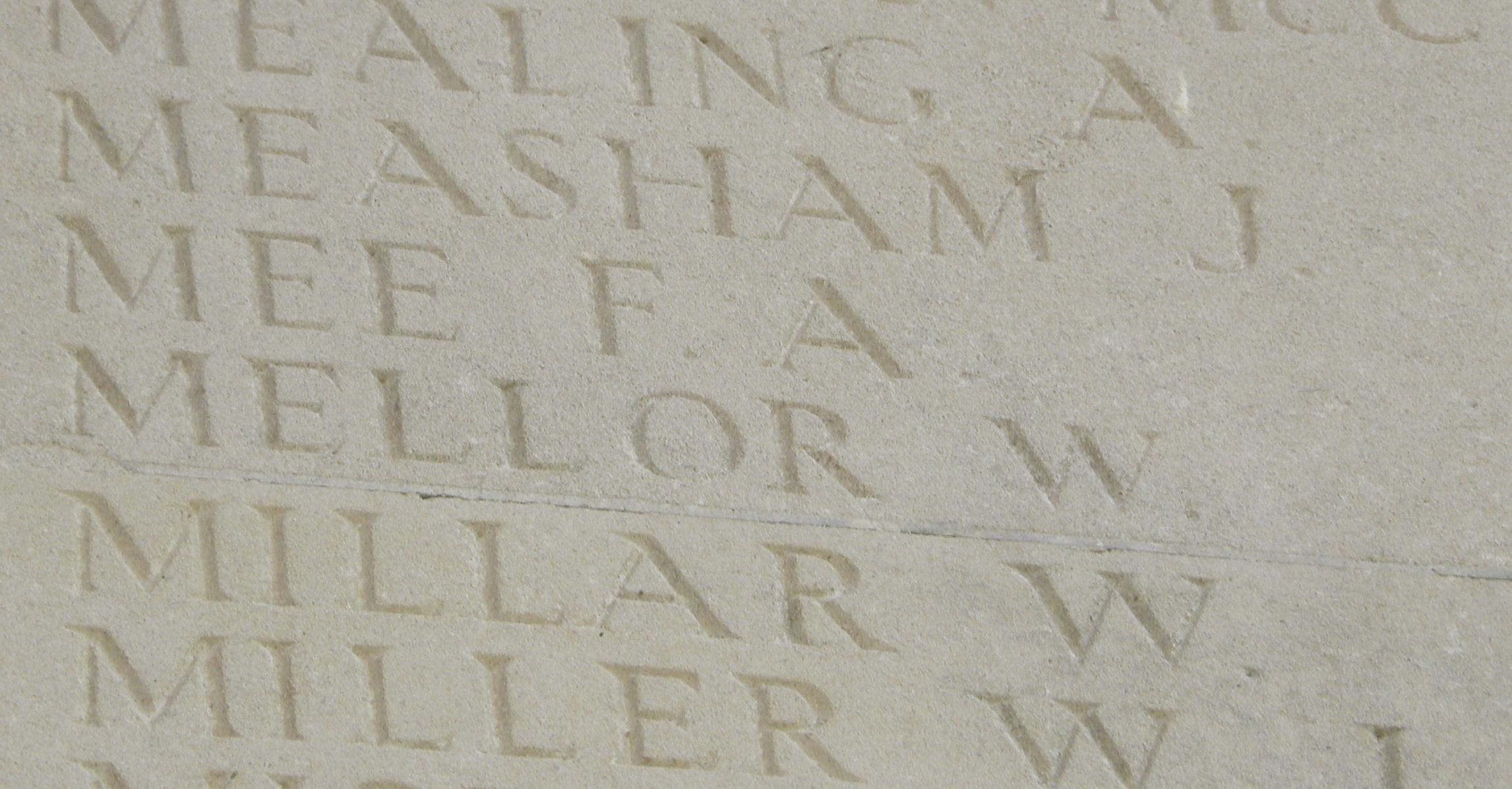
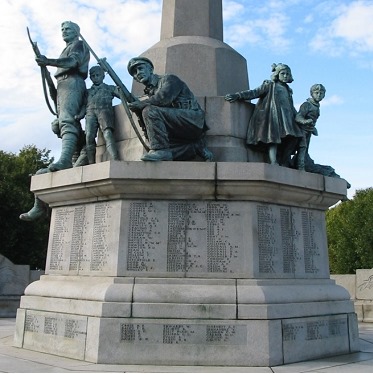
Memorial at Port Sunlight |
|
Private 18112 George Walter Frederick Mee
|
|
10th Bn, Cameronians (Scottish Rifles).
Killed in Action 29th January 1916, Aged 17.
Commemorated Loos Memorial, panel 57 - 59.
|
|
George Walter Frederick Mee was born in Quorn on 27th February 1898. He was the son of
Francis Henry Mee, a carpenter who later became a car finisher, and Elizabeth Mee (née
Clarke) a machine hand. George's parents were married on Christmas Day 1889 in
Loughborough. In 1901 the Mee family lived at 68 Pinfold Street, Loughborough but later
moved to 23 Boyer Street. George had attended Desford Industrial School in Desford,
Leicestershire and he is listed at Desford in 1911, aged 13, as a stoker and part-time
schoolboy. In 1915 his family were at 55 Queen's Road, Loughborough. George had four
brothers James, Fred, Jack and Frank, and three sisters Florence, Eva and Mary.
When George enlisted at Leicester on 21st February 1914 he said that he was almost 16 years
old and a musician. He joined the 1st Rifle Brigade at Colchester two days later as boy soldier
no. 5410. In February 1915 he was admitted to hospital in Winchester for just over two weeks
with bronchitis. He was discharged on 12th March 1915 as his services 'were no longer
required'.
He managed to reenlist with the Cameronians (Scottish Rifles) by not giving his true age and
using the alias 'George Walter Moor'. He was taken on as Private 18112 in the 10th (Service)
Battalion and sent to Chisledon Camp on Salisbury Plain. He went to France in July 1915,
aged just 17. George's battalion was sent from Boulogne via Audruicq, Nielles-lès-Ardres,
Arques to Lozinghem where they practised bayonet fighting, route marching and trench
procedure. During September 1915 they moved on to Verquin and then Mazingarbe near
Loos-en-Gohelle. The battalion first saw action on 25th September 1915 at the Battle of Loos,
where they made steady gains at Hill 70 but at the high cost of 255 of their soldiers being
killed in action. George was wounded in the arm at Loos but was very keen to return to the
front. When he rejoined the newly reinforced battalion the men were alternately in the front line
trenches at Vermelles or resting at Sailly-Labourse.
Throughout January 1916 the battalion was holding a part of the front line in the area opposite
the Hohenzollern Redoubt and subjected to shelling. George was killed in action on 29th
January 1916, aged 17, and was the first Loughborough boy soldier to die in the war. In a
letter to his parents, his company officer said: 'He was one of the most popular of the men in
my company. He was always so bright and full of energy; one could not help liking him. I had
the greatest confidence in his courage and intelligence'. The officer added that Mee was on
patrol work when he was wounded by a bomb, and died very soon after. George is
remembered on the Loos Memorial, Panel 57-59.
|
|
|
|
Private 42164 James William Mellors
|
|
6/7th Bn. Gordon Highlanders.
Died at Home 29th December 1921, Aged 22.
Buried Loughborough Cemetery 20/210.
|
James William Mellors was born in Loughborough in the early summer of 1899. He was the son of Ernest Mellors and his wife Mary Ann (née Hart) who were married in the Shardlow district in 1893. James's father was a blacksmith and in 1901 the family lived at 60 Derby Road, Loughborough. By 1911 they had moved to 15 Paget Street. James had two brothers John and Sidney and one sister Caroline. Another sister Sarah died, aged 2, in 1898.
On 30th December 1916 James was fined at the Petty Sessions for playing football in Queen's Park and wilfully damaging the turf.
James's service record has not survived but it is likely that he enlisted when he was 18, in the summer of 1917. He joined the Gordon Highlanders, in the Army's 51st Highland Division, as Private 42164. His war medals were curiously issued under the name of 'John Mellors' but whether this was an error or whether that was the name by which he was known in the Army cannot be confirmed.
James would have received some training at the Castlehill Barracks, Aberdeen. The date on which he was sent to France to join the 6th Battalion of the Gordon Highlanders is unknown but he may have been among the large batch of young reinforcements who joined the battalion near Béthune and Lillers at the end of March 1918.
On 9th April the enemy launched a surprise attack at Armentières and the battalion was hastily moved to the area of Vieille Chapelle. A battle to hold the enemy back from the Lawe and La Bassée canals ensued. The conduct in this action of the reinforcements of eighteen and a half year old boys, none of whom had seen action before, was remarkable. They behaved with the firmness of veterans. The action continued on the following days, but the battalion suffered considerable losses.
After the Battle of Armentières the weakened battalion lay at Busnes. Between 16th April and 4th May the battalion was at Witternesse for reorganisation and training. On 5th May the battalion moved by train to Acq. For two months spells in the line were followed by tours in support and in reserve at Ecurie Wood Camp. Sports and games were sometimes possible in the afternoons and performances by 'The Balmorals' in the evenings.
In July the battalion was hit by the influenza epidemic. On 11th July they moved back to St. Michel, near St. Pol. On 14th July they marched to Pernes and entrained for Romilly-sur-Seine. They then marched to Chapillon, on the edge of the Forest of Rheims. On 21st July orders were received to advance through the Bois de Courton. On 23rd July the battalion took part in an attack between the Bois de Courton and the River Ardre and held new ground for three days. On 30th July the battalion was withdrawn to bivouac near Nanteuil and Oiry.
On 3rd August the battalion entrained at Avize for Arras and for two weeks rested at Caucourt. On 18th August the battalion moved by light railway to Anzin and took up a support position in front of Athies. In a night attack on 21st August they seized two lines of enemy trenches. Three days later they moved to the forward position and were hit by an enemy mustard gas attack. The 6th Gordons led another attack on the enemy on 26th August. On 28th August the battalion moved back to Balmoral Camp.
During September the battalion spent only nine days in the battle line, six of these being in support at Roeux. On 11th September they marched back to Athies and moved by light railway to Chateau de la Haie. Ten days were spent here in training while in Reserve. On 22nd September they moved to Duff Camp and on 29th into Reserve near Plouvain before being withdrawn to billets at Frevin Capelle on 2nd October.
On 6th October the 6th Gordons were amalgamated with the 7th Gordons, both battalions being rather depleted, to form the 6/7th Battalion. This new unit was immediately moved by bus towards Cambrai. For four days they lay in trenches and dugouts near Quéant as the enemy began to retreat. The battalion then advanced to Escadoeuvres. By 12th October the battalion had taken over the line beyond Iwuy. The advance continued amid counter-action by enemy artillery and snipers. When relieved the battalion spent eight days in Iwuy and Thun St. Martin reorganising and refitting. They returned to the attack on 25th October, regained all the ground around Rougemont and established a line east of Famars. The Gordons defended this line until the enemy finally gave up.
The battalion rested at Thun Leveqcue and were there when the Armistice was declared. They remained there until 7th January 1919 when they moved to Houdeng-Aimeries, Belgium, and demobilisation began.
James returned to Loughborough but died, aged 22, on 29th December 1921. He was buried in Loughborough Cemetery Grave 20/210.
James's older brother John, who served with the Sherwood Foresters, was wounded in action and discharged from the Army in 1915. He died in 1925.
|
|
|
James William Mellors
Has no memorial on his grave.
|
|
Driver 232869 Morton Metcalfe
|
|
44th Res. Bty. 86th Bde. Royal Field Artillery.
Died of Wounds 30th May 1918, Aged 26.
Buried Crouy British Cemetery II. E. 18.
|
Morton Metcalfe was born in Huddersfield, Yorkshire, in the summer of 1891. He was the eldest child of James Metcalfe and his wife Mary Ann (née Bushell) who were married at St. Stephen's Church, West Bowling, Bradford, Yorkshire, on 5th March 1890. At the time of his birth Morton's father was a draper in Huddersfield but by 1901 the family had moved to 35 Boothferry Road, Goole, and Morton's father was manager of a boot shop. Between 1901 and 1911 the family moved again, this time to 11 The Avenue, Loughborough, and Morton's father had become an insurance agent. In 1911 Morton, now 19, was a commercial clerk at the Brush Works, where he had been working since leaving school. In his youth Morton was a member of St. Peter's Church Lads Brigade and he later became deputy organist at Emmanuel Church. At the time he enlisted he was acting organist and choirmaster at Holy Trinity Church, Barrow on Soar.
Morton enlisted in 1917 and joined the Royal Field Artillery. He was trained as Driver 232869 with 3C Reserve Brigade at Deepcut Barracks, Surrey Heath, near Camberley. The precise date of his enlistment and the date on which he was sent to France are unknown as his service record has not survived. Between March and June 1917, however, Morton was married in Market Harborough to Ellen Wilkins (known as 'Nellie') and it seems likely that he did not go to France until sometime after this date.
Morton was sent to France to join A Battery of the 86th (Howitzer) Brigade of the Royal Field Artillery.
As the war diary of the 86th Brigade does not record the occasions on which the brigade received batches of ordinary rank reinforcements it is difficult to determine when Morton might have joined the brigade on the Western Front.
On 10th July 1917 the 86th Brigade was preparing positions north of the Ypres-Comines Canal. D Battery went into action defending the line on the night of the 13th, the other batteries joining on the next day. Between the 23rd July and 2nd August, in the opening stages of the Passchendaele Offensive, the brigade issued a number of intense bombardments as well as harassing night fire and was shelled by the enemy in return. Withdrawn to the wagon lines on 3rd August the brigade then moved up to the Ypres Ramparts where the same firing patterns continued until 18th November. From 1st-18th December the brigade was resting at Watou before returning to the Ramparts at Ypres.
On New Year's Day 1918 the brigade was at the front just south of Poelcappelle as the line gradually moved forward. On 8th February the brigade began entraining at Hopoutre for Amiens and proceeded via Longueau to Hamelet and Vaire where they rested until 2nd March. The brigade then went into reserve and marched to the wagon lines at Buire. Supplies of ammunition were taken to new positions and the guns calibrated at Peronne.
On 21st March, the first day of the German Spring Offensive, the 86th Brigade in the wagon lines was bombarded by the enemy, causing heavy casualties, and was ordered to withdraw to another position. The withdrawal continued over the next few days. One gun was lost and there were further casualties among the men and horses. The remaining guns nevertheless kept up harassing fire on the enemy. At one point the brigade was covering the bridge crossing at Brie, at another the canal from Eterpigny to Chapelette. After the enemy gained a footing on the high ground above Villers Charbonnel the brigade was ordered to retire to west of Assevillers but to continue with day and night fire. On 28th March, when the enemy broke through west of Harbonnières, the brigade was moved to Caix and then Beaucourt. As the enemy continued to advance in large numbers the brigade was called into action again. After they ran out of ammunition they were ordered to retire across the river at Moreuil and rendezvous at Rouvrel, but at Rouvrel they were heavily engaged by aeroplanes and also shelled. The situation after this became confused as the battle fluctuated and the batteries were moved around to new positions until they were relieved on the night of the 7th/8th April. Casualties numbered 113 men and 95 horses.
Between 8th and 23rd April the brigade was at rest at Yonval before moving to St. Jean on 24th. On 28th April the 86th Brigade took over from the 291st Brigade near Villers-Bretonneux. On 3rd May the brigade co-operated in an attack by the French on Bois de Hangard and the 4th Australian Division on Villers-Bretonneaux.
On 19th May the brigade received warning about suspected enemy infantry operations and from 20th May to 4th June was continuously in action. Morton was dangerously wounded in the head by a shell splinter on 30th May. He died the same day without ever regaining consciousness, aged 26, in No. 47 Casualty Clearing Station, Crouy.
Morton was buried in Crouy British Cemetery, Grave II. E. 18. He is remembered on the memorial in All Saints Church, Loughborough, on the memorial in the former St. Peter's Church building, and on the Carillon.
Morton's widow was remarried at Market Harborough in 1921 to Kenneth J. Crowhurst.
|
|
|
|
Lance Sergeant 241216 Arthur Miller
|
|
2/5th Bn, Leicestershire Regiment.
Died of Wounds 27th September 1917, Aged 23.
Buried Dozinghem Military Cemetery V. E. 20.
|
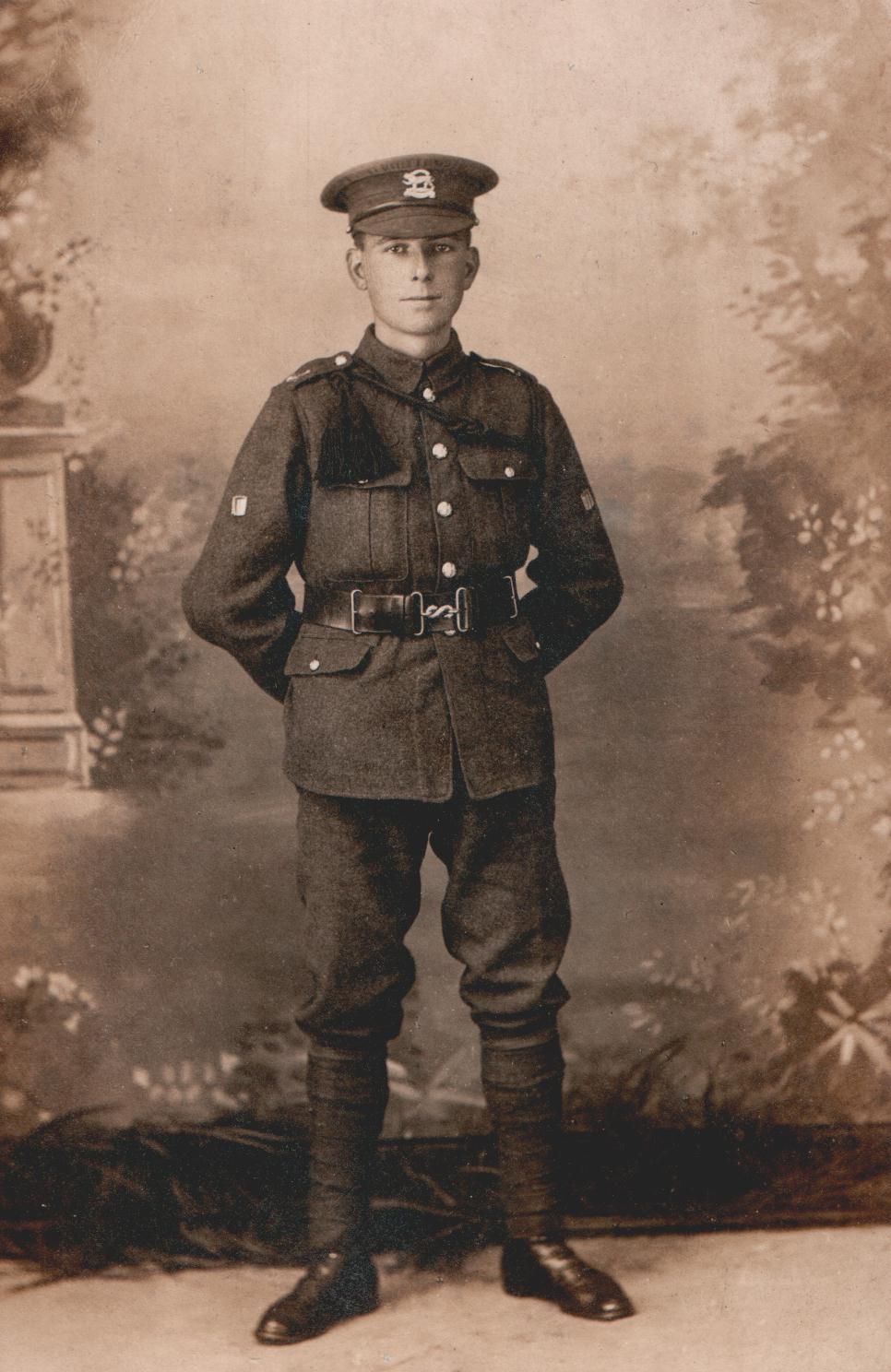
|
Arthur Miller was born in Loughborough in 1894, the son of Henry Miller and his wife Harriett (née Powdrill) who were married in Loughborough in 1889. Arthur had one brother Reginald and six sisters Doris, Eveline, Ethel, Elsie, Hilda and Ida. Two other brothers died under one year old. In 1901 Arthur's father was a Griswold knitter and in 1911 a ribbon-maker. In 1911 Arthur, aged 16, was a hosiery trimmer. In 1901 the Miller family lived at No. 61 Ashby Road, Loughborough, and by 1911 had moved to No. 54 in the same road. Arthur's father was the conductor of the Borough Band and Arthur was also in the band as a player of a silver baritone horn.
Arthur enlisted at Loughborough on 3rd November 1914. At the time he was employed at Messrs. Clarke's Dyeworks. He joined the 2/5th (Territorial) Battalion of the Leicestershire Regiment as Private 3496, later being renumbered as 241216.
The 2/5th Battalion had its HQ in Loughborough as part of the Lincoln and Leicester Brigade, North Midland Division and was mobilised in September 1914. In January 1915 the battalion moved to Luton being billeted in private homes, in February and March they had a spell at Epping digging practice trenches. In July the battalion moved to the St Albans area, under canvas at Briton Camp for training and route marches. In August 1915, the Brigade was retitled 177th Brigade, 59th Division (2nd North Midland) and in October they were moved back to billets in Harpenden. Throughout 1915 some members of the 2/5th Leicesters also provided guards for the prisoner of war camp at Donington Hall.
In January 1916 parties of officers were sent to France on tours of instruction in the trenches and in March, the long awaited orders to proceed overseas were received. On Easter Monday, however, the rebellion in Ireland forced a rapid change of plans. The 177th Brigade was recalled from leave and ordered to move to Liverpool at midnight. The following day they sailed on the SS Ulster, a fast mailboat, escorted by a Royal Navy destroyer. Their first taste of action was not to be in the trenches of the Western Front, but in the streets of Dublin.
By the end of the month the main uprising was over and the 2/5th Battalion supplied search parties for Ballsbridge and guarded railways, bridges and other key infrastructure. On the 10th May they moved out of the city to tackle pockets of resistance in County Kerry, searching homes and making arrests. In June word was received that the Battalion would be moving to France and training resumed with long route marches through Ireland. In August they marched 80 miles from Tralee to Fermoy Barracks, where they would remain until January 1917, engaged in live fire training in trench warfare. The return trip from Ireland was made aboard the SS Ulster and the battalion arrived at Fovant Camp in Wiltshire by train at 7pm on 6th January 1917.
After embarkation leave they proceeded to France via Southampton, arriving at Le Havre on the 24th February 1917. They were sent to the Somme area where the enemy was retreating to the Hindenburg Line. They made their first attack on the villages of Hesbecourt and Hervilly on 31st of March 1917, capturing both villages and suffering a number of casualties.
On 1st April the battalion began constructing a line of cruciform posts and on the following day were shelled while doing so. On 3rd and 4th April part of the battalion supported the 4th Leicesters in an attack on Fervaque Farm while the rest of the battalion built posts in Templeux. On 11th and 12th April the battalion moved to Hervilly and Hamelet to provide working parties and on 15th A and C Coys were in support for an attack on Villeret. On 17th April the battalion moved from Brosse Woods to Templeux and Hervilly and were in support again on the following day in an attack on a quarry north of Villeret. On 19th April the battalion moved to Hancourt for cleaning up, working parties and training. On the night of 27th/28th April Hancourt was bombarded by the enemy and the battalion moved to the front line at Le Vergier.
Trench tours continued until 15th May when the battalion marched back to Bois Bias training camp between Bouvincourt-en-Vermandois and Le Catelet. Training took place until 25th May when they moved to Equancourt and went into the front and support lines at Villers Plouich. Here until 7th June more posts were constructed amid some heavy enemy bombardment. From 7th-16th June the battalion was in Brigade Reserve at Dessart Wood, after which the battalion returned to the front line at Villers Plouich and carried out cable digging and laying for the Royal Engineers. Attack training took place at Equancourt from 22nd-30th June, after which the battalion went into support at Metz-en-Couture until 10th July. For the rest of July and the first three weeks of August the battalion was in training at Barastre camp.
On 22nd August the battalion moved via Senlis to a front one mile south-west of Le Sars for further training. On 31st August they entrained at Albert for Hazebrouck and marched to a training camp north of Winnezeele where they remained until 20th September. By 23rd September the battalion was in the reserve trenches at St. Jean near Ypres, before taking over the front line at Hill 37, Hill 35 and Elmtree Corner. On 26th September the battalion went into attack to capture all enemy positions on Hill 37 (part of the Battle of Polygon Wood, a phase in the 3rd Battle of Ypres or Passchedaele) .An enemy counter-attack was subsequently beaten back.
At some point in September Arthur was wounded. On 27th September 1917 Arthur died of wounds, aged 23, in a Casualty Clearing Station at Dozinghem. He had been promoted to the rank of Lance Sergeant by the time he died.
Arthur was buried in Dozinghem Military Cemetery Grave V. E. 20. He is remembered on the Carillon War Memorial in Loughborough.
|
|
|
|
Sergeant 865 William Kilgour Miller
|
|
1/5th Bn, Leicestershire Regiment.
Died at Home 9th July 1916, Aged 57.
Buried Loughborough Cemetery, 14/298.
|
William Kilgour Miller was born in 1859 in the parish of St. Cuthbert's Church, near Princes Street, Edinburgh. He was the son of John Miller, who later lived at 9 East Montgomery Place, Edinburgh, and attended the Presbyterian Church.
William had already served with 1st Battalion of the Black Watch (Royal Highlanders) for seven years when, on 22nd September 1883 at Ballincollig, County Cork, Ireland he attested to join the 2nd Dragoons of the Royal Scots Greys. He was 25 years old and had a tattoo of a Highlander and girl on his right arm, and on his left arm a tattoo of a shield. He secured his release from the Black Watch by a payment of £14 and joined the Royal Scots Greys in Ballincollig as Private 2512. He was appointed a Bandsman in the 2nd Dragoons on 1st July 1884, a position he held until 21st September 1890.
In November 1883 he was sent to Piershill Barracks in north-east Edinburgh where he stayed for two years until October 1885 when he moved to Aldershot. On 27th November 1886 he married Kate Harrington, a farmer's daughter, in Farnham, Surrey. In August 1887 he was posted to Brighton for eleven months. In July 1888 he was sent to Ireland, firstly to Dundalk and then, in July 1890, to the Curragh.
On 22nd September 1890 William transferred to Royal Scots Greys, 1st Class A Reserve, moved with his wife and two young sons James and William Kilgour Miller to Nottingham and joined the Nottingham City Police Force. He left the Army Reserve on 29th September 1895. His military papers record the following: 'Conduct very good. Habits regular and temperate' and that he had been awarded Royal Humane Society Medal for Saving of Life.
Between 1893 and 1901 five daughters were born to William and Kate Kilgour Miller: Kate, Annie, Edith, Laura and Florrie. In 1901 the family was living at 3 Baden Terrace, Nottingham, and William was a musician with the Robin Hoods (a unit of the Volunteer Force of the British Army).
Sometime between 1901 and 1909 the family moved to 88 Cobden Street, Loughborough as William had obtained employment as a fitter and electric furnace labourer at the Brush Electrical Engineering Company. On 16th April 1909 he attested at Loughborough, this time to join the 1/5th Leicestershire Regiment (Territorials) for four years. He was appointed Private 865 and was almost 50 years old. Between 1909 and 1911 he attended annual training camps at High Tor and Aberystwyth and was subsequently re-engaged in November 1912 and in February 1914. He played a clarinet in the band.
William went to France with the 1/5th Leicesters on 28th February 1915 but two weeks later was sent to No. 11 Stationery Hospital at Rouen with bronchitis. He was transferred back to England on 22nd March 1915.
William resumed military duties in Loughborough and was attached to the administrative centre of the battalion at the Loughborough Drill Hall. He was promoted to Acting Corporal on 1st May 1915 and to Acting Sergeant on 3rd July 1915. In March 1916, however, his health deteriorated and he was in Loughborough Hospital from 30th March to 11th April suffering from mitral stenosis. He died at home (44 Leicester Road, Loughborough) on 9th July 1916 from pleurisy and pneumonia, aged 57.
A local newspaper report on William's funeral recorded that it was 'conducted by the Rev. Pitts, and deceased was accorded military honours. In addition to the family mourners there were present: Capt. Woods, Lieut. Harrison, Observation Posts, and men from the Drill Hall. At the conclusion of the service three volleys were fired over the open grave by a firing party from Glen Parva, and the bugler sounded the Last Post'.
William is buried in Loughborough Cemetery Grave 14/298. He is remembered on the memorial in All Saints Church, Loughborough as well as on the Carillon.
William's sons both had Army careers and served in WW1, James with the 2nd Dragoons of the Royal Scots Greys and William with the 1st Battalion of the Sherwood Foresters. Both survived the war. Two of William's grandchildren James Acquilla Kilgour Miller and John William Kilgour Miller served in the Royal Navy in the Second World War and both lost their lives [See Loughborough WW2 Roll of Honour ].
|
|
|
|
Driver 820657 George Henry Mills
|
|
46th Div. Ammunition Col., Royal Field Artillery.
Previously served as No. 399 Royal Field Artillery (T.F.)
Died of Wounds 29th May 1917, Aged 20.
Buried Bully-Grenay Communal Cemetery II. G. 10.
|
George Henry Mills was born in Loughborough in late 1896 or early 1897. He was the eldest son of George Mills and his wife Hannah Maria (née Glasse) who were married at Emmanuel Church, Loughborough, on 10th November 1894. At the time of his marriage George Mills was a groom, but he later became a cab driver. George Henry had three brothers Wilfred, Harold and Eric and two sisters Lily and Mabel. In 1901 the Mills family lived at 1 Moor Lane, Loughborough, but they later moved to 80 Wellington Street. In 1911 George Henry, aged 14, was an iron turner at Cotton's hosiery machine works in Pinfold Gate.
George Henry's service papers have not survived but it is known that he was mobilised with the local Territorials at the outbreak of war. Initially having been given the service number of 399 he joined the Royal Field Artillery as Driver 820657. He was part of the 46th (North Midland) Divisional Ammunition Column and was sent to France on 5th March 1915. At some point, probably in 1916, he became a gunner attached to a trench mortar battery in the 46th Division.
During the Battle of Loos the 46th Division was decimated in an attack on the Hohenzollern Redoubt on 13th October 1915. It was later involved in the Battle of the Somme in July 1916, where in the opening phase as part of VII Corps, the southern-most corps of the British Third Army, the Division took part in the diversionary attack at Gommecourt on the first day on the Somme, 1st July 1916. This was a catastrophic failure resulting in heavy losses. The event dogged the division afterwards with a poor reputation until 29th September 1918.
George Henry, having survived the war for over two years, died of wounds aged 20, on 29th May 1917. He was buried in Bully-Grenay Communal Cemetery, Grave II. G. 10.
His parents, who in 1917 lived at 80 Moor Lane, received a letter from a lieutenant as follows: 'I regret to have to inform you of the death in action of your son, Gunner G. H. Mills. He was going up to the guns, during an attempted enemy raid when a shell, which burst a few yards from him, mortally wounded him. Everything possible was done, but he died about ten minutes later. I can assure you that you have the sincere sympathy of the whole battery in your sad loss. He was one of the best men in the battery, popular with the officers and with his companions, and his loss is a blow to all of us. I trust that it is some consolation to you to know that he died doing his duty as a soldier'.
|
|
|
|
Private 10899 Henry (Harry) Mitchell
|
|
6th Bn, Leicestershire Regiment.
Killed in Action 17th July 1916, Aged 24.
Commemorated Thiepval Memorial, pier & face 2 C & 3 A.
|
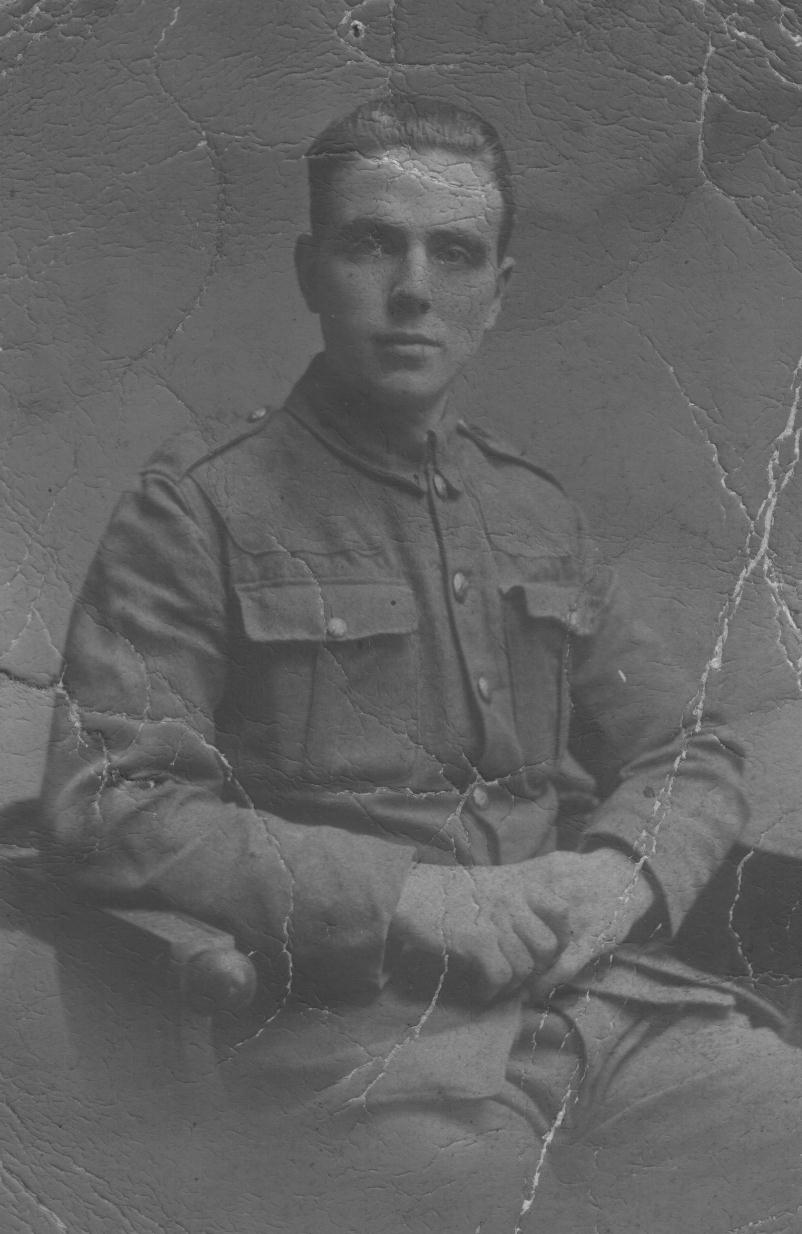
|
Henry Mitchell, known as Harry, was born in Loughborough in 1892, the son of William and Sarah Mitchell (née Clarke) who were married in Loughborough in 1881. Harry had three brothers George, William and John and four sisters Alice, Elizabeth, Florrie and Nancy. In 1891 the family lived at 12 Railway Terrace, Loughborough. Harry's father was a platelayer for the Midland Railway Company. By 1901 the family had moved to 24 Morley Street and Harry's father was now a railway foreman. By 1911 they had moved to 27 Gordon Street and Harry, now aged 19, was a car fitter for an engineering works. Harry's parents later moved to 2 Conery Terrace and then 17 Cradock Street.
Harry enlisted at Loughborough as soon as war broke out. He joined the 6th (Service) Battalion of the Leicestershire Regiment, part of Kitchener's First New Army, as Private 10899. Harry was then sent to Bordon, near Aldershot, Hampshire where the emphasis was on individual training, squadron and platoon drill. In March 1915 the battalion went into billets in Liphook.
In April 1915 the 6th Battalion became part of the 37th Division of the Army and concentrated at Cholderton on Salisbury Plain. On 25th June the 37th Division was inspected by King George V at Sidbury Hill. On 22nd July 1915 the Division began to cross the English Channel and by 2nd August all units were concentrated near Tilques not far from St.Omer in the Nord-Pas-de-Calais. Harry embarked for France on 29th July 1915.
In September Harry's battalion moved via Watten, Houlie, St. Omer, Eecke and Dranoutre to Wulverghem and Berles-au-Bois, a short distance from the front line south-west of Arras. In the months that followed the 6th Battalion did tours in the trenches, alternating with the 8th Leicesters who relieved them. The battalion was engaged in localised operations seeking a tactical advantage and remained in the area around Bienvillers and Bailleulmont until July 1916.
On 1st July 1916 the 6th Battalion moved from Saulty to Humbercamps, where it was held in reserve for the Somme Offensive which had just begun. On 6th July the battalion marched to Talmas to join the Army's 21st Division. From 7th to 10th July the battalion was in Hengest-sur-Somme, and from there on 10th marched to Ailly, entrained for Méricourt, took buses to Méaulte, and then proceeded to Fricourt. From 14th - 17th July the battalion took part in the attack on Bazentin Ridge and successfully captured Bazentin-le-Petit Wood and village. Harry, aged 24, was killed in action in this battle.
Harry is commemorated on the Thiepval Memorial, Pier and Face 2C and 3A.
Harry's brothers John and George also enlisted in August 1914. John joined the 7th Battalion of the Leicesters but was discharged a month later as medically unfit. George served with the 1/5th Leicesters and was wounded in the chest in 1915 but survived the war.
|
|
|
|
Private 8913 Arthur Monk
|
|
2nd Bn, Leicestershire Regiment.
Killed in action 25th September 1915, Aged 26.
Commemorated Loos Memorial, panel 42 - 44.
|
Arthur Monk was born in Loughborough in 1889, the son of Arthur and Mary Elizabeth Monk (née Broster). His father was a bell hanger and his parents were married in the Wirral in 1882. Arthur had two brothers Horace and Herbert and three sisters Edith, Annie and Doris. Another sister Hursilla had died, aged 16, in 1908. In 1901 the Monk family was living at 60 Russell Street, Loughborough.
When Arthur Monk Senior died in 1909 his widow took a position as housekeeper to William Henry Young at 22 Factory Street, Loughborough. Her youngest children Edith, Annie, Doris and Herbert went with their mother to Factory Street and in 1911 are listed as boarders there. Arthur's brother Horace had married and was living at 36 Freehold Street, Loughborough. Mary Monk later moved to High Street, Quorn.
Arthur himself had joined the 2nd Battalion of the Leicestershire Regiment as Private 8913 and in 1911 was with his battalion in India. He served in various locations including Madras, Wellington, Bareilly and Ranikhet.
When war broke out he 2nd Leicesters were brought from India to France as the British Battalion of the Garhwal Brigade of the 7th Indian Division. They arrived in Marseilles on 11th October 1914 and travelled north to the war zone. They were one of the units chosen to spearhead the allied assault at Neuve Chapelle (10th-13th March 1915).
Along with their Indian comrades the 2nd Leicesters attacked the German position known as Port Arthur, near La Bombe crossroads. The Garhwal Brigade's Indian battalions were held up by uncut wire, but the 2nd Battalion of the Tigers led the attack on the right and smashed a way through or over all obstacles and quickly overwhelmed the enemy holding the trenches covering the village and woods at Neuve Chapelle. On 9th May, the Garhwal Brigade was used as a second wave in the first attacks of the Battle of Aubers Ridge, without success; they saw action again on the night of 15th May at the beginning of the Battle of Festubert where the leading battalions met heavy resistance and the attack was called off.
The 2nd Leicesters spent the next couple of months alternately in the trenches or in billets while war training, in the area of Calonne and Vieille Chapelle north-east of Bethune. The corps was then rested in a quiet sector until it was deployed for the Battle of Loos.
The initial attack at Loos was to be made by three divisions, with the Meerut Division leading the attack on the Indian front; Blackader's brigade, with two Gurkha battalions and the 2nd Leicesters, was on its right flank. Whilst the attack successfully crossed no-man's land under cover of the barrage, the right flank of the brigade was caught up in defensive wire, and only one battalion successfully made its way into the German trenches. Gas also affected some of the men and the smoke caused a dense fog, making direction difficult. From the 2nd battalion 72 men were killed, 217 wounded, 42 were gassed, and 96 were recorded as missing. Arthur, aged 26, was one of the men killed.
Arthur is commemorated on the Loos Memorial Panel 42-44.
|
|
|
|
Private 20802 George William Monk
|
|
10th Bn, Sherwood Foresters.
Died of Wounds 14th September 1916, Aged 33.
Buried Warlincourt Halte British Cemetery II. G. 5.
|
George William Monk was born in Brimington, Derbyshire, in 1883. He was the son of John Monk, a bricklayer's labourer from Hathern, Leicestershire, and his wife Elizabeth (née Barson) who were married in 1867 in the Shardlow registration area. In 1891 the family lived at Sunny Hill, Duffield, Derbyshire. George had two brothers Thomas and John and three sisters Lucy, Mary and Ellen. After George's father died in 1900 the family moved to 1 Wood Lane, Milford, Derbyshire and George, now 17, was a clerk at Strutt's cotton bleach works. By 1911 George's mother had moved again, this time to 49 Rendell Street, Loughborough.
George enlisted in about January 1915 and joined the 10th (Service) Battalion of the Sherwood Foresters (Notts and Derby Regiment) as Private 20802. He was sent for training at Wool, Dorset, and then to Winchester in June 1915.
As George's service record has not survived it is not known when he was sent to France. A large group of the 10th Sherwood Foresters landed at Boulogne on 14th July 1915 and concentrated with their Division (the 17th Northern) near St. Omer. For the rest of 1915, after a period of trench familiarisation, they held the front lines in the southern area of the Ypres Salient. George, however, may not have been with the battalion at this point as he married Emily Handy at St. Editha's Church, Tamworth, Staffordshire, in the late autumn of 1915.
In 1916 the 10th Sherwood Foresters were involved in fighting at the Bluff (south-east of Ypres on the Comines Canal), part of a number of engagements officially known as the Actions of Spring 1916.
By the beginning of July 1916 the battalion had moved to the Somme and were in the area of Morlancourt and Montauban-de-Picardie. They saw action from 1st-7th July during the Battle of Albert in attacks north of Fricourt (1st July), at Lozenge Wood (2nd July), Fricourt Wood (3rd July) and north-east of Fricourt (7th July). On 11th July they entrained at Meaulté for Saleux and from there marched to St. Pierre à Gouy. From there they marched to Ailly-le-Haut-Clocher and then Hangest where they entrained for Méricourt, arriving there on 23rd July.
At the beginning of August they were in the trenches near Pommiers and on 5th August relieved the Duke of Wellington's Regiment in the trenches at Longueval. Here they experienced heavy enemy shelling. The battalion was involved on 7th August in an unsuccessful attack on Delville Wood. On 14th August the battalion was ordered to entrain at Méricourt for Candas and march to Longuevillette. This was followed by a move to Neuvillette and a transfer into billets at Humbercourt on 21st August.
September began with four days in the trenches east of Fonquevillers. From 4th to 9th September the battalion provided assistance to the 181st Tunnelling Coy of the Royal Engineers. On 10th September the battalion was relieved and marched to Mondicourt and then to Halloy where they remained until 17th September.
It is not known at what point George was wounded but he died from his wounds in No. 43 Casualty Clearing Station on 14th September, aged 33. He is buried at Warlincourt Halte British Cemetery, Saulty, Grave II. G. 5. He is commemorated on the memorial at All Saints Church, Loughborough, as well as on the Carillon.
George's only child, a daughter called Georgina, was born in Loughborough between October and December 1916. George's widow, Emily, was remarried in 1919 in Chesterfield to John T. Spencer and went to live at 26 Barber Lane, Killamarsh, Sheffield. |
|
|
|
Private 3600 John Monk
|
|
1/5th Bn, Leicestershire Regiment.
Killed in Action 13th October 1915, Aged 23.
Commemorated Loos Memorial Panels 42-44.
|
John Monk was born in Hathern in late 1893 or early 1894, the son of Frederick Watts Monk and his wife Ellen Elizabeth (née Dexter). His parents were married in Hathern in 1887. John's father was a hosiery framework knitter for most of his life but between 1911 and 1922 he became licensed victualler of The Royal Oak in Long Whatton. In her younger days John's mother was also a framework knitter. John had two older sisters Margaretta and Clarissa and between 1891 and 1901 the Monk family lived at Wide Street, Hathern and in 1911 in Derby Road, Hathern.
By 1911 John, aged 17, was an apprentice lace draughtsman and in the summer of 1914 he married Sarah Ann Margaret Spencer (known as Margaret) in Hathern. The couple settled in Gladstone Street, Hathern, and in late September 1914 their first child, Neville, was born. Margaret later moved to 61 Cumberland Road, Loughborough.
John attested into the Territorial Force to serve 4 years' service in the United Kingdom or abroad on the 6th January 1915 in Loughborough. He initially joined the 2/5th (Reserve) Battalion of the Leicestershire Regiment as Private 3600 and was sent to join the battalion at Luton for training. In July 1915 the battalion moved to St. Albans and became part of the Army's 59th Division. On 16th August 1915 John was transferred to the 1/5th Leicestershire Regiment and went to France two days later.
He joined his battalion in the Ypres Salient, near Zillebeke, where on 1st September 1915 in reply to an Allied bombardment, the Germans heavily shelled the Leicestershires' trenches causing many casualties. At the beginning of October the battalion was ordered to move towards Loos. On 12th October 1915 they travelled to the Hohenzollern Redoubt, arriving in Vermelles at 10.00pm. They spent the next eight hours in communication trenches. On 13th October 1915 during the attack on the Redoubt, part of the final stages of the Battle of Loos, the 1/5th Battalion was in reserve until just after midday, when they 'went over the top' and came under intense machine gun fire. John was killed, aged 23, during the attack.
John is remembered on the Loos Memorial Panels 42-44, on the Memorial Cross in Hathern Cemetery, on the memorial in St. Peter and St. Paul's Church, Hathern and on the memorial in the former St. Peter's Church building in Loughborough.
John never saw his daughter Madie who was born early in 1916 and who died, aged only three in 1919. John's widow Margaret was married again in 1920 in Loughborough to George W. Gilbert and moved to 22 Leopold Street. |
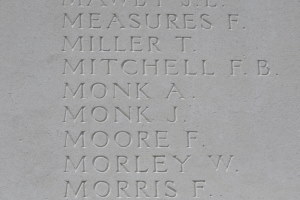 |
|
Corporal 1401 Harry Wood Moore
|
|
2nd Bn, Royal Warwickshire Regiment.
Killed in Action 25th September 1915, Aged 22.
Commemorated Loos Memorial, panel 22 - 25.
|
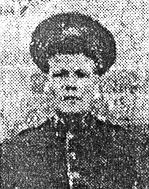
|
Harry Wood Moore was born at High Street, Barwell, Leicestershire, on 5th November 1892, the son of George Moore and Annie Moore (née Wood). His parents were married at Barwell on 25th November 1888, and at that time his father was a shoe finisher. By 1901 Harry was with the family at Long Street, Atherstone St. Mary, Warwickshire, and his father had changed occupation - George was now a coal miner (hewer).
By 1911 Harry's father had changed jobs again and was now a foreman in a shoe factory and living with his wife and three youngest children next to the Post Office in Stapleton, Hinckley. Leicestershire. Harry, meanwhile, had joined the army and was a Private with the 2nd Battalion of the Royal Warwickshire Regiment.
Harry had three siblings: Amelia, Selina, and Cyril. (Six other siblings had died when young.) Harry also had four half-brothers whom he never knew by his father's second wife Mabel Holmes, an American from New Jersey. Harry's own mother had died in 1913 and his father had married again at Woodhouse, Leicestershire, in the spring of 1915. Harry's older sister Amelia, now Mrs. James Hall, lived at 6 Fox Yard, Wellington Street, Loughborough.
When war broke out Harry's battalion was stationed in Malta. The battalion returned to England on 19th September, joined the 22nd Brigade of the Army's 7th Division and moved to Lyndhurst, Hampshire. After training they proceeded to Belgium, landing at Zeebrugge on 6th October 1914. Harry had now achieved the rank of Corporal.
The 7th Division engaged in various actions on the Western Front, including the 1st Battle of Ypres and the Battles of Neuve Chapelle, Aubers, and Festubert, the 2nd action of Givenchy, and the Battle of Loos. Harry was killed in action on the first day of the Battle of Loos.
|
|
|
|
Air Mechanic 3rd Class 84203 Herbert Bolton Moore
|
|
Royal Flying Corps.
Died at Connaught Hospital Farnborough 7th June 1917, Aged 25.
Buried Loughborough Cemetery 6/159
|
Herbert Bolton Moore was born in 1891 in Loughborough and baptised on 25th July 1891 at Emmanuel Church, Loughborough. He was the only child of James Robert Carter Moore and his wife Annie (née Bolton) who were married at the Church of St. John the Baptist, Beeston, Nottinghamshire, on 19th March 1888. The Moore family lived at 28 Devonshire Square, Loughborough, and Herbert's father was a commercial clerk in a hosiery dyeworks. By 1901 they had moved to 28 Cattle Market but in 1902 Herbert's father died.
Herbert's mother Annie, now aged 45, was remarried on 5th August at All Saints' Church, Loughborough, to David Roberts, a hairdresser aged 26. Both gave their address as 51 Broad Street. By 1911 David and Annie Roberts and Herbert had moved to Field Street, Shepshed, and Annie was assisting her husband in the business. Herbert was now nineteen and a labourer in a bottling stores. Between 1911 and 1916 Herbert moved back to Loughborough, to 13 Garden Street.
Herbert enlisted on 2nd March 1916 but was not called up for service until 21st May 1917. He joined the Royal Flying Corps as Airman Mechanic (3rd Class) 84203 and was sent to Aldershot. Eighteen days later he died, aged 25, at the Connaught Hospital, Aldershot, from a cerebral abscess. He was buried in Loughborough Cemetery, Grave 6/159.
|
|
|
|
Private 40760 William Arthur Moorhouse
|
|
1st Bn. Leicestershire Regiment.
Killed in Action 14th July 1918, Aged 23.
Commemorated Tyne Cot Memorial panel 50 - 51.
|
William Arthur Moorhouse was born in Bradford, Yorkshire, in April 1895. He was the second son of John Edward Moorhouse and Matilda (née Gallagher) who were married in Bradford in 1892. William's father was a machinery manufacturer's clerk who progressed to the position of manufacturer's bookkeeper. William had one brother Thomas and two sisters Ellen Marian (known as Marian) and Florence. In 1901 the family was living at 86 Maperton Road, Bradford. In late 1910 or early 1911, however, William's mother died, aged 40, and in mid-1911 William's widowed father was living with his four children at 2 Airedale College Terrace, Bradford. William's uncle Arthur Moorhouse and his aunts Martha and Florence were also in the household. Between 1911 and 1918 William's father moved to Holbeck, Leeds, and then to 78 Violet Street, Benwell, Newcastle upon Tyne.
In 1911 William was listed as a student. Between 1911 and 1915 he seems to have moved to 22 Duke Street, Loughborough, but it is not known what his occupation was during this time. Although his Army service record has survived some crucial parts of it, including his occupation on enlistment, have faded and are unreadable.
William attested in Loughborough for war service on 10th December 1915. He joined the Leicestershire Regiment and was sent to Army Reserve. Mobilised on 25th January 1916 he joined the 2/5th Battalion as Private 4843. He was sent to France on 4th September 1916 to join the 1/5th Leicesters but was re-posted via Depot No. 12 to the 1st Battalion on 19th September 1916. He was now renumbered as Private 40760.
When William joined the 1st Leicesters the battalion was fighting in the Battle of Flers-Courcelette (15th- 22nd September) where it incurred grievous losses. The battalion was also in action in the Battle of Morval (25th-28th September). During part of the Battle of Le Transloy (1st October-5th November 1916) the 1st Leicesters were employed carrying up stores and providing stretcher and other parties for the front line troops.
By 21st October the battalion was back in billets at Corbie where it entrained three days later for Sorel before moving over several days to Fouquières-les-Béthune in the La Bassée sector.
Most of November was spent in training with one brief trench tour and December in the trenches at Cuinchy, with breaks at Beuvry and Christmas Day at Noeux-les-Mines.
January 1917 was spent in turns in the trenches and at rest in Mazingarbe. From 1st to 21st February many raids on the enemy were carried out after which the battalion marched via Sailly Labourse to the Montmorency Barracks at Béthune.
In March and April the battalion did trench tours on the front line north of the Double Crassier, Loos, with breaks at Philosophe. On 18th April a party from the battalion raided the German trenches and incurred 29 casualties. William was one of those wounded in the action.
William was sent to No. 17 Field Ambulance in the Army's 6th Division and then to No. 58 Casualty Clearing Station at Lillers. On 20th April he was admitted to No. 16 General Hospital, Le Tréport, with shotgun wounds to his back and knee. After a period of convalescence he was posted to an Infantry Base Depot at Calais on 29th June. Between this date and 16th May 1918 William's location is unknown as the relevant notes on his service record have unfortunately deteriorated over time and are now unreadable.
William rejoined the 1st Battalion of the Leicestershire Regiment in the field on 16th May 1918. At this time the battalion was in Brigade support near Belgian Chateau, a mile and a half south-west of Ypres. Conditions were not good - the weather was very hot and gas was seeping from the ground in the dugouts causing sickness among the men.
On 18th May the battalion was sent to the front and support lines in the Chateau Ségard sector, near Voormezeele. During this trench tour they experienced enemy gas shelling and heavy artillery fire at night. On 26th May they moved to the Ravine in Brigade support and on the following day the enemy began a heavy bombardment, including gas shells, of the support lines and back areas.
From 30th May - 6th June the battalion was back in the front and support lines at Chateau Ségard. The enemy restarted shelling, including ordinary gas shells as well as those containing sneezing gas. Hostile aeroplanes were also very active. The battalion was relieved on 6th June, their relief being hampered by another hostile gas shelling attack, and moved to Dirty Bucket Camp, about two miles north-west of Vlamertinghe. Here, after inspections and cleaning up, the battalion provided working parties for the Vlamertinghe, Brandhoek and Poperinghe lines and also attended Lewis gun classes.
On 13th June 120 men became sick with influenza and on the following day 60 men were sent to hospital. The battalion was moved to School Camp near Poperinghe for further training and cases of flu continued to appear. The sickness is likely to have been the so-called 'Spanish flu', the first cases of which appeared in Belgium around this time.
On 20th June the battalion entrained at Proven for St. Omer and marched to Musketry Camp, Cornette. Here the men had four days' practice in rapid loading, trigger pressing and field firing. On 25th June the battalion entrained at St. Omer for Mendighem and marched to Rainsford Camp near Watou where training continued. Additional training took place in the Hagebaert area near Poperinghe until 5th July.
On 6th July the battalion went into the trenches in the front line of the Dickebusch sector. The trenches here were in a very bad condition and owing to the proximity of Mount Kemmel all movements were easily observed by the enemy. All available men were used carrying materials to the front line, often amid enemy action. On 11th July the battalion moved into Brigade reserve in the same sector for night wiring work in the Vyverbeek line where progress was continuously hindered by hostile shelling.
William was killed in action on 14th July, aged 23. His body was never found and he is commemorated on the Tyne Cot Memorial, Panel 50-51.
|
|
Second Lieutenant Frederick Walter Moss
|
|
8th Bn. Leicestershire Regiment. Attd. 98th Field Coy, Royal Engineers.
Killed in Action 28th May 1918, Aged 24.
Commemorated Soissons Memorial.
|
Frederick Walter Moss was born in 1894 in Loughborough and baptised, when he was aged sixteen, on 22nd March 1911 at St. Mary-in-the-Elms Church, Woodhouse, Leicestershire. Frederick was the eldest surviving son of Walter Harley Moss and his wife Kate (née Cragg) who were married in Loughborough in 1891. Frederick's father was a butcher and farmer. In 1901 the Moss family lived at 4 Moor Lane, but by 1911 had moved to Parks Farm, Nanpantan. Between 1911 and 1918 they moved again, this time to Moat Farm. Frederick had one brother Alec; another brother Harley died in infancy.
Frederick won a County Scholarship to Loughborough Grammar School and attended the school between 1908 and 1913. His obituary in The Loughburian later noted that 'He was too shy and retiring to take a prominent part in the life of the school but he was very thoughtful and always showed a strong sense of duty'.
In October 1913 Frederick went up to Jesus College, Cambridge, having won an open mathematical scholarship to the university, together with the Somerville Exhibition. In 1915 he gained a First Class in Part I of the Mathematical Tripos in 1915 and proceeded to his degree in Part II in 1916.
As soon as he graduated Frederick enlisted and joined the Suffolk Regiment as Private 34555. He received his commission in April 1917 and was appointed a 2nd Lieutenant with the 8th (Service) Battalion of the Leicestershire Regiment on 27th April 1917.
In May 1917 he joined the 8th Leicesters in Berles-au-Bois where the battalion was receiving training in musketry and tactical schemes as well as taking part in brigade sports. On 1st June the battalion marched to huts in Hamelincourt for additional training in bombing and rifle grenades and field exercises until 7th June. On the night of 7th/8th the battalion went into the trenches in the Hindenburg Line. From there they attacked the enemy on 15th June but were compelled to withdraw. They remained in the front line until 19th June when they returned to camp at Hamelincourt. A period of rest at Blairville then lasted until 1st July, after which the battalion returned to Hamelincourt. On 9th July 1917 the battalion was in the trenches near Croisilles before going into Brigade Reserve. After one more front line trench tour at Croisilles the battalion moved to Camp A at Moyenville for eight days training. Following this the battalion was in brigade support in the forward area until 17th August when it moved to a hutment camp in Ervillers for training. On 25th August the battalion moved by motor bus to Barly and from there, on the following day, marched to Ambrines. Two further periods of training followed, firstly at Ambrines and then at Avesnes-le-Comte.
On 16th September the battalion marched to Savy, entrained for Caestre and went into camp for more training. On 23rd September the battalion began a series of moves, firstly to Meteren, then by bus to Hallebast before marching to Sint Hubertushoek and from there to Ridge Wood south-west of Ypres. On 30th September they moved up to the front line at Polygon Wood.
On 1st October the enemy attacked the 9th Leicesters who were nearby and got possession of their front line. The 8th Leicesters went to assist but the enemy made repeated attacks. Counter-attacks were hit by a heavy enemy barrage in the neighbourhood of Joist Farm. On the night of the 2nd/3rd October the battalion was relieved and marched to Scottish Wood Camp. On 4th October the 8th and 9th Battalions of the Leicesters were amalgamated because of their high casualty rate. On 5th October the combined battalion moved to railway dugouts at Zillebeke and on 7th they went into the front line. The weather was very wet and the men suffered severely in the open trenches and shell holes.
Relieved on 11th October the battalion moved to Anzac Camp where the combined battalion was restored to two units. On 12th October the 8th Battalion entrained at Ouderdom station for Ebblinghem and marched to Le Croquet. From here three days later the battalion moved by motor lorry to the Gheluvelt area on the Menin Road for six days of cable trench digging. The men worked under heavy hostile barrages, moving to and from the area under shellfire. Between 17th and 22nd October 86 Ordinary Ranks were killed, wounded or went missing.
Five days at Camp A, Kruistraat crossroads, for reorganisation and training followed, after which the battalion went into Brigade Reserve in railway dugouts south-west of Zillebeke Lake to work on cable trenches. While moving into the front line on the night of 3rd/4th November the battalion suffered heavy casualties from a hostile gas shell bombardment and were withdrawn to Divisional Reserve at Camp A. Between 9th and 16th November the battalion completed another front line trench tour as well as four days in the support trenches at Zillebeke Bund. On 17th November they began a six-day march from Pioneer Camp near Scottish Wood to Coupigne for five days cleaning and reorganisation, and then marched to Monchy Breton.
On 30th November the battalion was suddenly ordered to entrain at Savy for Cambrai in order to reinforce the line there on account of a large scale German attack. From Courcelles on 1st December the battalion moved into the support line and into the front line on the following day. Four more trench tours took up most of December and in between tours the battalion concentrated on improving the village defences of Epehy with barbed wire entanglements. From Epehy, on 4th January 1918, the battalion moved back to Middlesex Camp, Heudecourt, in Brigade Reserve. Between 11th and 20th January the battalion was in training at Haut Allaines and working on wiring and tunnelling at Saulcourt. Two more trench tours in bad weather when the sides of the trenches kept falling in completed the month.
February 1918 included trench tours at Epehy, ten days at Noislains for training, digging a fire trench near Gurlu Wood, work on new aerodromes at Cartigny and near Nurlu and digging the main line of defence near Pezière. In early March it became clear that the enemy was preparing for a large-scale attack.
On 21st March the Germans opened their Spring Offensive, advancing in formation and accompanied by a bombardment of every description. The battalion, still in the neighbourhood of Epehy, suffered heavy casualties on the front line between 21st and 23rd March. Despite renewed efforts to counter the enemy the battalion was forced into retreat via Peronne, Clery, Bresle and Vadencourt to Allonville.
At the beginning of April the battalion entrained at St. Roche, Amiens, for Hopoutre, bound once more for the Ypres Salient. After six days in various rest camps the battalion was ordered into close reserve at Torr Top and Canada Tunnels, moving to the front line on 13th April. On the 15th April, they were ordered to withdraw to Forrestor Camp, by the Ypres-Kruistraathoek road. On the evening of 18th April the battalion took over a line of posts and in spite of enemy attacks, maintained a defensive flank until the end of the month.
Relieved on 1st May the battalion marched via Buysscheure to Wizernes, where on 5th May they entrained for Serzy-Savigny. Training then took place at Aougny until 12th May. Between 13th and 15th May the battalion proceeded via Pevy to D Camp, Chalons-de-Vergeur, east of Bouvancourt. The battalion remained here in training until 19th May.
At some point around this time, in April or May 1918, Frederick was attached to the 98th Field Coy of the Royal Engineers which had similarly spent April on the Ypres Salient, and had now returned to the area of the Aisne/Marne.
When the 3rd Battle of the Aisne began on 27th May part of the 98th Field Coy of the Royal Engineers was dismounted and attached to infantry manned battle positions northwest of Hermonville. These positions came under a heavy gas and high explosive shell attack from the enemy. Relieved by the French in the evening the men moved to the line at Champignonnières. Here, on 28th May, the Company was again heavily bombarded and forced to withdraw. Frederick aged 24, was killed on 28th May 1918 and his body was never found.
Frederick is commemorated on the Soissons Memorial, Aisne. He is also remembered on the memorial at Loughborough Grammar School, the memorial at Jesus College, Cambridge, and on the Carillon.
|
|
|
|
Lieutenant Gerald Alec Moss
|
|
16th Bn, Attd. 2nd Bn. Manchester Regiment.
Formerly 19th Bn, Manchester Regiment and also Artists Rifles
Killed in Action 10th August 1918, Aged 19.
Commemorated Vis-en-Artois Memorial. panel 9.
|
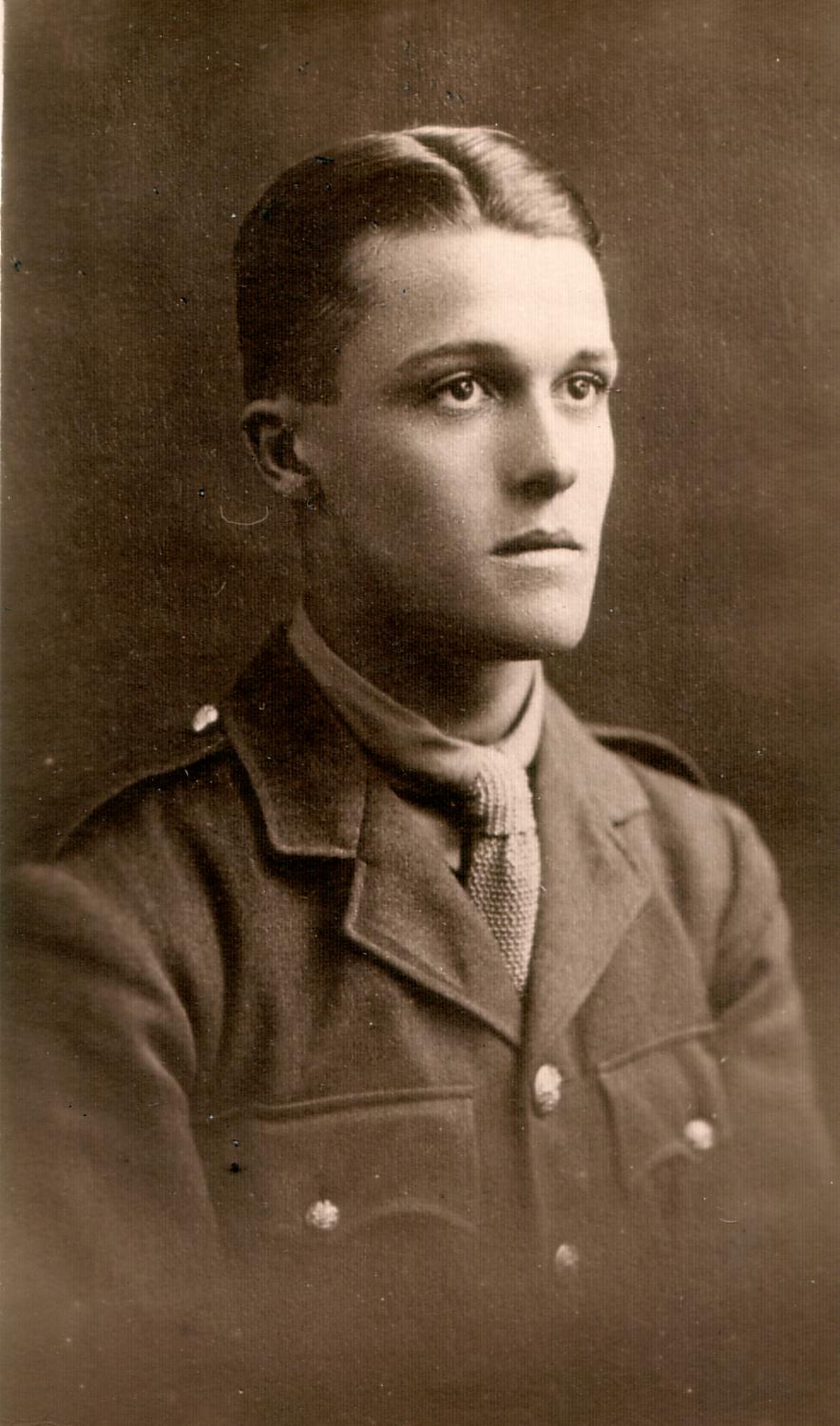
|
Gerald Alec Moss, known to his family as 'Alec' was born in Loughborough on 13th January 1899. He was the son of Charles Moss and his wife Eliza (née Atkins) who were married at Charnwood Road Baptist Chapel, Shepshed, on 1st September 1894. Alec's mother, who was the adopted daughter of Mr J. Harriman JP and Mrs Harriman of Fernside, Shepshed, sadly died a few months after Alec was born. Alec had one older brother William who was three when their mother died.
Alec's father belonged to the Moss family which in 1820 had founded the firm of William Moss and Sons Ltd., building contractors, in Loughborough. In 1901 young Alec and William were living with their father, a housekeeper, and two other domestic servants at the firm's premises, 39 Baxter Gate, Loughborough.
On 23rd September 1903 Alec's father was remarried at Holy Trinity Church, Barrow on Soar, to Mabel Agnes Black, the daughter of Henry Black, a former building contractor who became a hosiery manufacturer. In 1904 Alec's stepmother gave birth ito Frank Moss, half-brother to Alec and William. Alec's father subsequently moved around the country according to the demands of his business while his step-mother appears to have lived mostly with her father Henry Black, either at Rochberie, Leicester Road, Loughborough, or at her own property 51 Wickham Avenue, Bexhill-on-Sea, Sussex. Alec's father, meanwhile, moved to London in 1907 to open another branch of the family firm, moved back to Nottingham during the First World War and finally settled at Thurcaston Manor, Leicestershire.
For a short time between September 1907 and April 1908 Alec and William attended Loughborough Grammar School but then joined their father in London. Between 1908 and 1909 Alec lived with his father at Hiawatha, Portsdown Avenue, Golders Green, Middlesex. During this time he attended William Ellis Endowed School in Gospel Oak, Highgate, north-west London. In 1910 Alec was sent as a boarder to William Hulme's Grammar School, Manchester, to join his brother William and their cousin Howard Moss. When Alec was fourteen he left school and was apprenticed to a firm of building contractors with a view to joining his father's firm.
Alec joined the Officer Training Corps of the 28th County of London Regiment (the Artists' Rifles) in late 1916 as Private 8902 (afterwards renumbered as 762907). At this stage of the war the Artists' Rifles was about to close the cadet schools it had previously run in France and it is likely that Alec was trained at Hare Hall Camp, Gidea Park, Essex.
On 1st August 1917 Alec obtained a commission as a Temporary 2nd Lieutenant with the Manchester Regiment. He was posted to the 19th (Service) Battalion (4th City) of the Manchester Regiment and joined them in the field at some point in the autumn of 1917. The war diary of the 19th Battalion, however, omits to mention the precise date on which 2nd Lieutenant Moss joined them.
From 21st August to 12th November 1917 the 19th Battalion was operating in the area of Kemmel Hill on the Ypres Salient. During this time they did tours in the front and support line trenches at the Ridge defences, Wytschaete, and provided working and carrying parties as well as completing wiring and revetting. Breaks were taken at camps south of Kemmel Hill, Partrain Farm and Irish House.
On 13th November the battalion moved to Lindenhoek Camp before taking buses to Steenvoords for training until 24th November. On 25th November the battalion transferred to Bedford House before going into the line east of Zillebeke to garrison posts, strengthen, clean and lay duckboards in the trenches and provide carrying parties at Hedge Street tunnel. During December this work continued with breaks at Scottish Wood and Ottawa Camps.
On 6th January 1918 the battalion began an eight-day move by train and march via Fuzeville, Dickebusch, Blaringhem, Steenbecque, Longeau, and Le Quesnel to Margny-aux-Cerises. Training then took place at Margny-aux-Cerises and afterwards at Golancourt, Commenchon and Camp Frières.
In early February 1918 the Army took the decision to disband the 19th Battalion of the Manchester Regiment, the junior battalion in the Brigade. Alec is listed as being transferred on 6th February to the 16th (Service) Battalion of the Manchester Regiment. He joined his new battalion at Les Buttes de Rouy.
On 8th February the battalion began a three-day march via Manicamp and Quesmy to Ognolles. At Ognolles two companies continued to Curchy to work on the railway until the end of the month and the rest of the battalion set off via Ham for Etreillers to dig trenches until 5th March. From 5th to 16th March the battalion was in Corps reserve at Aubigny, providing working parties. After moving to the Savy dugouts and Etreillers defences on 17th they went into the front line on 18th.
When the German Spring Offensive opened on 21st March the battalion's line was pounded by an enemy barrage and gas shells. The battalion initially managed to hold back the German advance but then found itself surrounded. The remnants of the battalion withdrew to Vaux, then to Villers St. Christophe to take up positions on the canal, but were again shelled by the enemy. Forced to retire to Cressy and then Bouchoir the battalion attempted to defend Arvillers but were again forced to withdraw to Rouvrel. When the battalion concentrated at Boubert on 31st March it had suffered 627 casualties.
In April the battalion was sent to the Ypres Salient and on 12th April went into the line at Gournier Farm. On 19th April the battalion was joined with the 17th Battalion of the Manchesters to form a composite battalion and went into the front line at Spoil Bank on the south-side of the Ypres-Comines Canal. On 25th April, just after the battalion had moved into close support at Spoil Bank and Lock 8 the enemy attacked and on the following day, in thick mist, overran the forward posts and drove the remnants of the battalion from Spoil Bank to Lock 8. There were 245 casualties.
After the battalion gathered at Scottish Camp the 17th Battalion left and the 16th Battalion was attached to the 2nd Battalion of the Yorkshire Regiment. The battalion then proceeded to the trenches at Ouderdom.
In early May the battalion moved to bivouacs outside Steenvoorde and then to Buyscheere. On 13th May the 16th Battalion was reduced to a training cache of 10 Officers and 49 Ordinary Ranks. Surplus personnel were dispatched to an Infantry Base Depot at Etaples. Whether Alec remained with the training cache or was sent to Etaples in not recorded in the War diary.
On 23rd July Alec was attached to the 2nd Battalion of the Manchester Regiment. At this time the battalion was in reserve at Proven near Poperinghe in the Ypres sector of the line, undertaking training and recreational activities. A football match was held on the 24th between the officers and NCOs, which the officers lost 2 nil, and the battalion sports day was held the following day.
Training continued, interspersed with providing working parties to assist the Canadian Railway Troops, until 7th August when the battalion moved by train to Hangest, west of Amiens, and marched to billets at Briquemesnil. On the 8th August the battalion moved by bus to Boves, on the eastern outskirts of Amiens and were billeted in a field outside the town. The next day they marched nearer to the front line being billeted for the night in a field between Mézières and Beaucourt.
On 10th August 1918 the Battalion War diary states that 'The Battalion moved up at 4 a.m. into action, advancing in columns of fours to Le Quesnil, where Coys extended into artillery formation and attacked (in support to the 15th & 16th Battalions Lancashire Fusiliers), Parvillers and Dametry Woods, with slight casualties'.
The War Diary only mentions two officers being wounded but it is clear that there were fatalities on that day including Alec. Alec was only 19 years old and his body was never found.
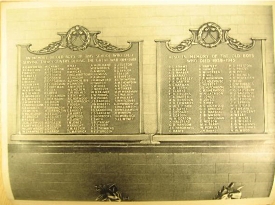 Memorial,
William Hulme's Grammar School, Manchester
Memorial,
William Hulme's Grammar School, Manchester
Alec is commemorated on the Vis-en-Artois Memorial to the Missing, situated on the road between Arras and Cambrai. He is also remembered on the memorials at Loughborough Grammar School and William Hulme's Grammar School, Manchester, and on the Carillon.
The Carillon was built by Alec's father's firm, William Moss and Sons Ltd. Bell No. 8 in the Carillon bears the following inscription: 'The gift of the Sons of William and Anne Moss, third Mayor and Mayoress of this borough, two of whose grandsons, Howard James Harding Moss (2nd Lieut., 5th Leicesters) and Gerald Alec Moss (2nd Lieut., 2nd Manchesters), fell in the Great War'.
Alec's brother William, who served with the Leicestershire Regiment, survived the war.
|
|
|
|
Second Lieutenant Howard James Harding Moss
|
|
A Coy. 1/5th Bn. Leicestershire Regiment.
Killed in Action 13th October 1915, Aged 19.
Buried Cabaret Rouge British Cemetery XXVII. G. 47.
|
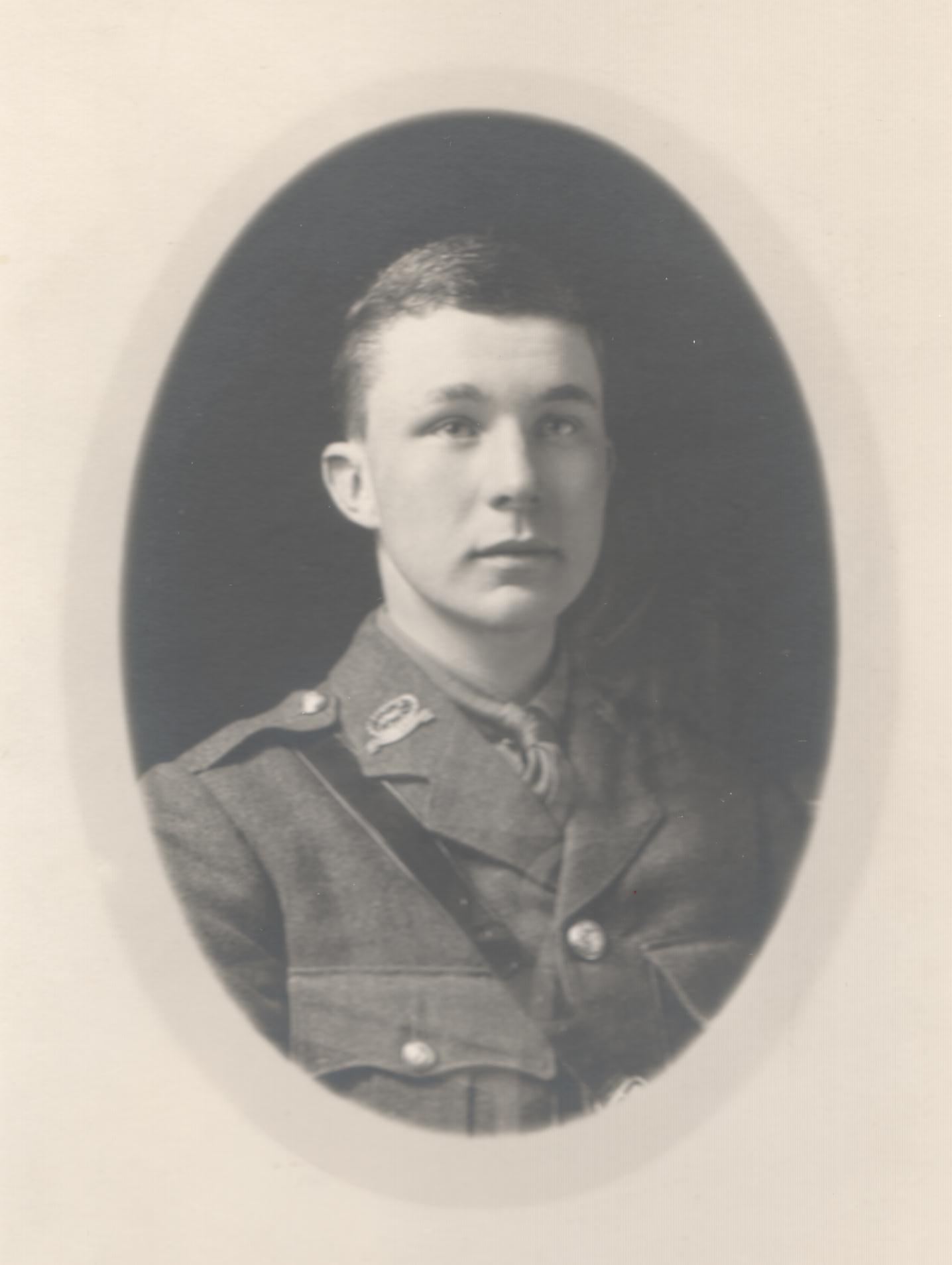
|
KILLED LEADING HIS MEN
Howard James Harding Moss was born on 20th June 1896, the eldest son of Wilfred Moss C.B.E. and Elizabeth Maud Moss (née Harding) who were married in Loughborough in 1892. Howard's father was a solicitor who had a practice at 80-81 Woodgate, Loughborough. Howard had an older sister Nora and three younger brothers Kenneth, Ewart and Malcolm. In 1901 the family lived at 3 Burton Street, Loughborough, but by 1911 had moved to the Knoll, Nanpantan, Loughborough.
Howard was educated firstly at Loughborough Grammar School and from 1906-1911 he joined his two cousins at William Hulme's Grammar School, Manchester. Thereafter he entered the business of William Moss and Sons Ltd., building contractors, of Loughborough, a firm founded by his grandfather.
For some time Howard was assistant scoutmaster of the Nanpantan Troop of Boy Scouts, in whose work he took a great interest, and with the scoutmaster was largely responsible for the high efficiency of the troop, one of the smartest in the county.
In August 1914 Howard obtained his commission in the Army in 1914 as a 2nd Lieutenant in the 1/5th Leicestershire Regiment and was attached to the 2/5th Battalion at Luton and St. Albans where he was promoted to Lieutenant.
Howard was keen for active service and, relinquishing his recent promotion, proceeded to the Front as a 2nd Lieutenant to join the 5th Leicesters. He arrived in France on 24th August 1915 and on the 31st joined "A" Company of his Regiment in the trenches near Kruisstraat in the Ypres Salient.
On 1st September 1915 in reply to an Allied bombardment, the Germans heavily
shelled the Leicestershires' trenches causing many casualties. Howard and a fellow officer, 2nd Lieutenant Tomson, had two miraculous escapes when firstly a 5.9" dud passed straight through the roof of their dugout and on into the ground almost grazing Tomson's side. Immediately thereafter they went round to the dugout of Captain Hastings and the three had only just left when this too was blown in.
Lieutenant Moss was a most promising young officer, exceedingly popular with his men of the 5th Leicesters. He quickly proved his abilities as an officer, and was highly esteemed by his colleagues. On the day of the action in which he lost his life, aged 19, he was given a position and duties of a very important nature leading his men into battle at Loos. He was killed in action on 13th October 1915.
Writing to Mr. Wilfred Moss, Lieutenant Colonel C. H. Jones, commanding the 5th Leicesters said: 'You will doubtless have heard officially already of the death of your son. I am so very sorry about it. I had only just written to you to say how much I valued him. We were in attack on the 13th October, and your son was splendid. He did all that duty and honour could demand. He was killed leading his men in battle, and when that has been said all that can be said has been said. In all sympathy with you in your great sorrow'.
In the letter referred to, written only the day before the action, Lieutenant Colonel Jones said of the deceased officer: 'I have now been with your son for a month, and am able to judge his work. I am glad to have him. I find him sensible and steady in his duties. I have had occasion to give him special work and to consult him on more than one occasion, and he has not failed me yet. My excuse for writing is that I feel a certain amount of responsibility for these young people, and it will interest you to hear perhaps that his worth is appreciated, and I am sure he will do well'.
Howard James Harding Moss is buried at Cabaret Rouge British Cemetery, Souchez, Grave XXVII. G.47. He is commemorated on memorials at St. Mary's in Charnwood Churchyard, Nanpantan, Emmanuel Church, Loughborough, Loughborough Baptist Church, Loughborough Grammar School, and William Hulme's Grammar School, Manchester. His younger brother Ewart also died in 1915, aged 11.
Howard's father, Wilfred Moss, was the original proposer of a Carillon as Loughborough's war memorial. He was also Mayor of Loughborough 1922-23, when the Carillon was opened.
Bell no. 8 in the Carillon bears the following inscription:
The gift of the Sons of William and Anne Moss, third Mayor and Mayoress of this borough, two of whose grandsons, Howard James Harding Moss (2nd Lieut., 5th Leicesters) and Gerald Alec Moss (2nd Lieut., 2nd Manchesters), fell in the Great War
|
|
|
|
Private 4351 Harry Mounteney
|
|
2/5th Bn. Durham Light Infantry.
Died at Home 6th April 1916, Aged 26.
Buried East Retford Cemetery A. J. 129.
|
Harry Mounteney (or Mountney) was born in Loughborough in 1890, the eldest son of Thomas Mounteney (or Mountney) a general labourer, and his wife Mary (née Simpkin). Harry's parents were married in Loughborough in 1888. Harry had four brothers Herbert, Arthur, George and Walter and three sisters Emma, Ada and Clara. In 1890 the family home was at 2 Court B, Baxter Gate, Loughborough, in 1901 at 16 Bridge Street, and in 1911 at 29 Falcon Street. The family later moved to 5 Falcon Street. In 1911 Harry was a basket maker.
Harry enlisted and joined the 2/5th Battalion of the Durham Light Infantry as Private 4351. This battalion was a Reserve unit in the 63rd (2nd Northumbrian) Division of the Army. Divisional HQ was set up at Newcastle upon Tyne and took responsibility for coastal defences of the sector Seaham Harbour - Sunderland - Newcastle. Harry was based at Cramlington Camp, nine miles north of Newcastle upon Tyne and King George V inspected the Division at Newcastle on 20 May 1915. In November 1915 Harry was posted with his battalion to Retford, Nottinghamshire.
Harry died at Retford Hospital on 6th April 1916, aged 26, and is buried in East Retford Cemetery, Grave A.J. 129. Harry's Company paraded at full strength at the funeral and followed the gun carriage which was also accompanied by the Battalion band, to the grave. The service was conducted by Major Lomax (Chaplain) and after volleys had been fired the Last Post was sounded over the grave. In addition to the family floral tributes, others were sent by Colonel Williams-Till and Officers, and the N.C.Os and men of the Company.
|
|
|
|
Private 12823 Charles Henry Mowbray
|
|
8th Bn. Leicestershire Regiment.
Died of Wounds 26th July 1916, Aged 21.
Buried Wimereux Communal Cemetery I. O. 24A.
|
Charles Henry Mowbray was born in Loughborough in 1894, the son of Edward Mowbray, a general labourer, and Emily Mowbray (née Tapp) who were married in Loughborough in 1884. He had one brother John (known as Jack) and two sisters Edith and Ethel. In 1901 the family lived at 48 Wood Gate, and in 1911 at 47 Cumberland Rd, Loughborough. In 1911 Charles was a brickyard labourer.
Charles enlisted on 1st September 1914 in Loughborough. He joined the 8th (Service) Battalion of the Leicestershire Regiment as Private 12823. sent firstly to Aldershot for training. He moved to Shorncliffe in Kent at the end of February 1915. In April 1915 Charles's battalion became part of the newly established 37th Division of Kitchener's 2nd New Army and the Division began to concentrate on Salisbury Plain. Charles was billeted at Perham Down. On 25th June the units were inspected by King George V at Sidbury Hill. On 22nd July the Division began to cross the English Channel and Charles travelled to France on 29th July 1915. Initially the 37th Division concentrated near Tilques.
The 8th Battalion then moved via Watten, Houlie, St. Omer, Eecke and Dranoutre to Wulverghem and Berles-au-Bois, a short distance from the front line. On 28th October 1915 Charles was admitted to No. 49 Field Ambulance with scabies. He rejoined his battalion a week later.
In the months that followed the 8th Battalion did tours in the trenches, alternating with the 6th Leicesters who relieved them. They were Involved in operations in Bailleul, Le Bizet, Armentières, Mondicourt, Beauval and Berles-au-Bois.
In April 1916 the 8th Leicesters moved to the Doullens area for six weeks for cleaning up, resting and training. In mid-May they returned once more to the trenches in the Bienvillers-Bailleulmont sector, but nearer Gommecourt. In June there was a series of nightly excursions into No-Man's Land with patrols attempting to gather information on the enemy's dispositions. On other occasions there were working parties out repairing the British barbed wire entanglements. The situation became increasingly hazardous as the month wore on when the Germans began to use a new and more accurate type of trench mortar.
The 8th Battalion did not participate in the first days of the Somme Offensive but was held in reserve. On 6th July they left billets at Humbercamps and marched to Talmas, continuing on the following day to billets in Soues. On 10th July the battalion marched to Ailly-sur-Somme, entrained for Méricourt and travelled from there by lorry to bivouacs in Méaulte. Between 10th and 13th July the battalion was in the trenches near Fricourt and subjected to fairly continuous enemy fire.
On 14th July the battalion advanced on Bazentin Le Petit Wood and Charles received gunshot wounds to his back and chest. He was taken to No. 64 Field Ambulance. Five days later he was admitted to No. 14 Stationary Hospital at Wimereux near Boulogne where he died, aged 21, on 26th July. He was buried in Wimereux Communal Cemetery, Grave Reference 1.0.24A.
Charles's brother Jack served with the Royal Garrison Artillery and survived the war.
|
|
|
|
Private John Henry Mulholland
|
|
4th Bn, Worcestershire Regiment.
Died at the General Hospital 22nd December 1920, Aged 42.
Buried Loughborough Cemetery 11/186
|
John Henry Mulholland was born in Loughborough in the early summer of 1878. He was the son of John Mulholland and his wife Mary Ann (née Winterbotham) who were married at the Catholic Chapel, Loughborough, on 6th July 1871. In 1881 John Henry's father was a labourer for Messenger and Company, plumbers, glaziers and glassfitters of Loughborough, and he later became a clerk and then cashier for the company. His mother worked in the hosiery trade.
John Henry had one brother Harry and four sisters Mary, Margaret Ellen (known as 'Nell), Theresa, and Kate. Two other siblings Elizabeth and Henry died young. In 1881 the family lived at 6 Buckhorn Square, Loughborough, but they later moved to 35 Shakespeare Street and then to 41 Broad Street. After John Henry's mother died in 1914 his father moved to 26 Burleigh Road.
In 1891 John Henry was a grocer's errand boy but he later became an iron moulder for a company of hot water engineers. He did not marry.
There are no surviving records relating to John Henry's service in the First World War. He served as a Private with the 4th Battalion of the Worcestershire Regiment but his date of enlistment and service number are unknown. He does not appear to have been sent overseas and may have remained at Leamington Spa where the battalion was based in February 1915.
John Henry was aged 36 when war broke out and it is possible that his health was not very robust. He died in the General Hospital in Loughborough on 22nd December 1920, aged 42. He was buried in Loughborough Cemetery, Grave 11/186.
|
|
|
John Mulholland
Has no memorial on his grave.
|
|
Private 5962 Walter Murdoch
|
|
1st Bn, Leicestershire Regiment.
Killed in Action 20th July 1915, Aged 35.
Buried La Brique Military Cemetery I. O. 30.
|
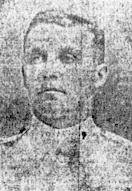
|
Walter Murdoch was born in Nottingham in 1884, the son of Walter Nathaniel
Murdoch, a warehouseman, and his second wife Mary Jane Hallam, who were
married in Nottingham in 1876.
Walter was already involved with the 1st Volunteer Battalion of the Robin Hood Rifles
when he attested for the Militia on 19th September 1900 at Leicester. He
subsequently enlisted at Curragh Camp, Ireland, on 14th November 1900. On
attesting he falsified his age, stating that he was 18 rather than 16. He was
appointed as Private 5962 in the 3rd Battalion of the Leicestershire Regiment on 22nd
January 1901, with his surname erroneously spelt as Murdock. In February 1901 he
was posted to Egypt for almost two years. Following this, and after a ten-month
break in England, he was sent to India for five years in October 1903.
After his return to England in December 1908 Walter became a Reservist, and was
employed as a hosiery counterman at the Nottingham Manufacturing Company. He
married Elizabeth Watson in Loughborough in 1910 and they set up home at 15
Ratcliffe Road, later moving to 36 Freehold Street. Walter and Elizabeth had two
children: Walter (born 1911) and Eric (born 1914).
When war broke out in 1914 Walter was recalled to the colours. He was sent to France on 9th November 1914 where he joined the 1st Leicesters who were fighting at the First Battle of Ypres.
In the spring of 1915 the battalion was stationed near Armentières, and was involved in an attack intended to divert the enemy from the area of Neuve Chapelle. In April the battalion was alternating trench tours in the area of Rue du Bois with breaks in billets in Armentières.
In late May the battalion was ordered to move north to the Ypres Salient where they relieved the 1st Hampshire Regiment on the Wieltje-Ypres Road-Roosebeke Road and heavy casualties almost at once began to be incurred. In June and July 1915 they were fighting again at Hooge, capturing a number of enemy trenches and it was here that Walter lost his life on 20th July, aged 35.
His wife heard of his death from a comrade in the same regiment before she was officially informed.
Walter was buried in La Brique Military Cemetery Grave I. O. 30. |
|
|
|
|
Private CH/1427(S) Leonard Musson
|
|
1st R.M. Bn, R.N. Div. Royal Marine Light Infantry.
Killed in Action 28th April 1917, Aged 21.
Commemorated Arras Memorial bay 1
|
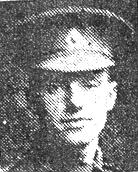
|
Leonard Musson was born on 15th December 1895 in Loughborough, and baptised at All Saints' Church, Loughborough, on 4th January 1898. He was the son of Lawrence Musson, a plasterer, and his wife Nellie (née West) who were married at All Saints' Church on 28th June 1894. Leonard had one brother Lawrence and five sisters Elsie, Millie, Nellie, Hilda and Bessie. In 1898 the family lived at 40 Paget Street but by 1901 they had moved to 10 Havelock Street. By 1911 Leonard, aged 15, had joined his father as an apprentice plasterer.
Leonard enlisted at Nottingham on 27th January 1916. He joined the Royal Marines and was posted to the Recruit Depot at Deal, Kent, as Private CH/1427/S. For a regular marine the training took a year and included artillery training for sea service and infantry training for land service, but this training was shortened due to the war. Leonard's character was assessed as 'Very Good' and his ability as 'Satisfactory'. On 15th April 1916 he was transferred to his Divisional Depot of Chatham Dockyard as part of E Coy to await posting to a Royal Navy ship or Royal Marine battalion in the 63rd (Royal Naval) Division.
On 26th July 1916 he was registered as Royal Marine Brigade at the shore base HMS Victory V. On 25th September 1916 he was drafted to the British Expeditionary Force and joined the 4th Entrenching Battalion, a temporary unit from which drafts of men could be drawn.
On 10th November 1916 he joined the 1st Battalion of the Royal Marine Light Infantry (known as the Red Marines). At the time the battalion was holding the Varennes line in the Hamel sector. Two days later the battalion moved up to battle positions and went into the attack on 13th November in the Battle of the Ancre. St. Pierre Divion and Beaumont-Hamel were captured and nearly 4,000 prisoners taken. Casualties overall, however, were high and on 15th November the battalion was withdrawn to Puchvillers. From there over six days the battalion marched to Morlay.
Leonard now unfortunately developed an abscess in his right shoulder, was hospitalised and did not rejoin his battalion from the Base depot until 14th February 1917. His battalion had just relieved the 10th Royal Dublin Fusiliers in the River Trench sector, north of Grandcourt. On 16th February the battalion lined up for an attack in the area of the Ancre. This attack once again produced heavy casualties.
On 19th they moved to the old German lines south-east of Beaumont-Hamel and from there to Engelbelmer where a battalion reorganisation took place. On 28th February they moved to the Bruce Huts near Aveluy where they remained until 19th March working on road repairs, undergoing instruction and drill.
On 19th March the battalion began a nine days march to Labourse where, after further training, they moved into the line in the Angres II sector and found that the enemy had retreated. From 16th to 23rd April the battalion cleaned up and repaired roads in the area of Maroeuil before working on trench improvement near Gavrelle. On 28th April the battalion, now in the front line trenches, was ordered to attack the Oppy-Maricourt Line. Leonard, who had joined the battalion's 'D' Company Lewis Gun Section for this attack, was reported missing in action and was assumed dead on 28th April 1917. He was just 21.
Leonard is remembered on the Arras Memorial Bay 1 and on the Carillon.
|
|
|
|
Rifleman 3039 Frederick Lionel Nash
|
|
1/12th Bn, London Regiment
Killed in Action 25th April 1915, Aged 17.
Commemorated Ypres (Menin Gate) Memorial panel 54.
(his brother Herbert also fell see below)
|
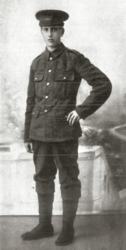 |
Frederick Lionel Nash was born in May 1897 in Woodford Green, Essex. He was the youngest son of Charles Herbert Nash and his wife Florence (née Manico) who were married on 1st June 1886 in Eynsford, Kent. Soon after their wedding Frederick's parents emigrated to Corvallis, Benton County, Oregon, USA. In 1879 Wallis Nash, a cousin of Frederick's father, had emigrated to Oregon to work on the Oregon Pacific Railroad Company, of which he subsequently became Vice-President. Charles and his new wife Florence Manico in turn settled out there in what was then a frontier town at the end of the Oregon Trail. Charles became the proprietor of the Fort Hill Dairy Company.
Frederick had three brothers Charles, Herbert and Victor and three sisters Florence, Millicent and Christobel. Charles, Herbert, Victor, Florence and Millicent were all born in Corvallis, Oregon. While the children were still young, however, the family returned to England and by 1901 were living at The Chestnuts, High Road, Woodford Green, Essex. Frederick's father then became a contractor for incandescent light bulbs but by 1911 he had become a steamship agent. Frederick and Herbert both attended Bancroft's School, Woodford Green. The family later moved to Maybank, Palmerston Road, Buckhurst Hill, Essex.
With most of their children reaching adulthood Frederick's parents went with Frederick's youngest sister Christobel to live in St. Catherine's, Ontario, Canada, and Frederick's father became an estate agent and broker.
Frederick was a frequent visitor to Loughborough where he had a number of close relatives on his father's side. His aunt Elizabeth Jane Gifford Nash had married Walter Chapman Burder, horticultural engineer and owner of Messenger and Co. His maiden aunts Edith and Frances Nash and his uncle Thomas Nash also lived in Loughborough, as did in retirement his paternal grandparents the Rev. Frederick Gifford Nash and Sarah Nash.
Frederick enlisted on 10th September 1914. He joined the 1/12th (County of London) Battalion of the London Regiment, otherwise known as 'The Rangers', as Rifleman 3039. Although Frederick was by regulations too young to serve at the front when he enlisted he signed up for service overseas.
Frederick initially trained at Crowborough. In October 1914 the battalion guarded the Waterloo-North Camp (Aldershot) railway and in December went to Roehampton.
On 9th March 1915 Frederick travelled to France on the troopship Balmoral and was with his battalion in the cavalry barracks of Ypres by the 17th of that month. He became part of D Corps.
The battalion was next to move into the line deployed in trench building around the Lindenhoek crossroads. Easter followed with an open air service conducted by the Bishop of London. The battalion then marched in the pouring rain to Bailleul.
Out of the line in the days that followed a football match was arranged against the 9th Battalion Queen Victoria's Rifles. On 15th April the battalion was again ordered to the front to occupy trenches between Ypres and Zonnebecke. A few days later they were back again in bivouacs. The 2nd Battle of Ypres with its gas and Minenwerfer attacks had commenced. Canadians suffering from the first gas attacks streamed passed their post and the Rangers were ordered to march to St Julien and form a defence line against the advancing Germans.
The whole front line was a series of craters but no formed body of German troops was encountered. The battalion, nevertheless, suffered three officer and eighteen other ranks killed by machine gun and artillery fire. Frederick was among the casualties, killed in action at Verlovenboek on 25th April 1915. He was still only seventeen years old and had been with the battalion in the field for just five weeks. Frederick's body was never recovered.
Frederick is commemorated on the Ypres (Menin Gate) Memorial, Panel 54. He is also remembered on the memorial in the former St. Peter's Church building, Loughborough, and on the memorial of Bancroft's School.
Frederick's brother Herbert, who served with the 1/12th (County of London) Battalion of the London Regiment, was killed in action in December 1915. His brother Charles who served with the Duke of Cambridge's Own (Middlesex) Regiment was severely wounded in 1917 but survived the war. His brother Victor, who served with the 23rd Battalion (Sportsman's Battalion) of the Royal Fusiliers was taken a prisoner of war in 1917 and also survived.
|
|
Rifleman 3094 Herbert Manico Nash
|
|
1/15th Bn, London Regiment
Killed in Action 21st December 1915, Aged 26.
Commemorated Loos Memorial, panel 132.
(his brother Frederick also fell see above)
|
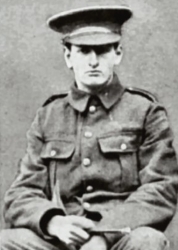 |
Herbert Manico Nash was born in 1891 in Corvallis, Benton County, Oregon, USA. He was the son of Charles Herbert Nash and his wife Florence (née Manico) who were married on 1st June 1886 in Eynsford, Kent. Soon after their wedding Frederick's parents emigrated to Corvallis, Benton County, Oregon, USA. In 1879 Wallis Nash, a cousin of Herbert's father, had emigrated to Oregon to work on the Oregon Pacific Railroad Company, of which he subsequently became Vice-President. Charles and his new wife Florence Manico in turn settled out there in what was then a frontier town at the end of the Oregon Trail. Charles became the proprietor of the Fort Hill Dairy Company.
Herbert had three brothers Charles, Victor and Frederick and three sisters Florence, Millicent and Christobel. Charles, Herbert, Victor, Florence and Millicent were all born in Corvallis, Oregon. While the children were still young, however, the family returned to England and by 1901 were living at The Chestnuts, High Road, Woodford Green, Essex. Frederick's father then became a contractor for incandescent light bulbs but by 1911 he had become a steamship agent. Herbert and Frederick both attended Bancroft's School, Woodford Green. After leaving school Charles and Herbert both secured positions as bank clerks in the Bank of England. The family later moved to Maybank, Palmerston Road, Buckhurst Hill, Essex.
With most of their children reaching adulthood Herbert's parents went with Herbert's youngest sister Christobel to live at 211 Ontario Street, St. Catherine's, Ontario, Canada, and Herbert's father became an estate agent and broker.
Herbert was a frequent visitor to Loughborough where he had a number of close relatives on his father's side. His aunt Elizabeth Jane Gifford Nash had married Walter Chapman Burder, horticultural engineer and owner of Messenger and Co. His maiden aunts Edith and Frances Nash and his uncle Thomas Nash also lived in Loughborough, as did in retirement his paternal grandparents the Rev. Frederick Gifford Nash and Sarah Nash.
When war broke out Herbert joined the 1/15th (County of London) Battalion of the London Regiment, otherwise known as the Prince of Wales Own Civil Service Rifles. As Private 3094 he was sent from Somerset House, London, to Bedmond, Hertfordshire, for training. In November 1914 the battalion moved to Watford.
The battalion left Watford for Southampton on 17th March 1915 and crossed the Channel to Le Havre on four steamers Balmoral, City of Chester, Jupiter and Munich. Having disembarked they proceeded to No. 6 Rest Camp above Harfleur. On 19th March they entrained for Berguette and marched to billets in Cauchy à la Tour. Training took place here until 6th April. On 7th April the battalion left for Béthune and the forward area.
On 8th April A and B Coys provided men for working parties in Cuinchy while D Coy went to the front line for 24 hours trench instruction by the 4th Guards Brigade. The other Coys then took turns for trench instruction. On 13th April the battalion moved into the front and reserve lines at Givenchy. Two more trench tours followed, with breaks at Béthune and Le Preol. On 24th April the battalion marched to La Beuvrière for two weeks' training and attack practice.
On 8th May the battalion moved to Gorre and from 9th-25th May the battalion was on the fringes of the Battle of Festubert, holding the intermediate line. All lines were shelled by the enemy and the men were kept busy providing carrying parties and burying the dead.
Early June was spent at Sailly Labourse and Les Brebis. Trench tours and working parties at Grenay and Fosse No. 7 de Béthune took up the rest of June and July, with breaks at Philosophe, Mazingarbe and Noeux-les-Mines. On 3rd August the battalion marched to La Beuvrière and remained there until 25th August resting and training. Another trench tour followed from 26th August until 3rd September, after which the battalion was involved in preparations at Hallicourt and Les Brebis for the Battle of Loos as well as undergoing sis days' drill at Houchin.
During the Battle of Loos the battalion was in Brigade reserve holding ground between Double Crassier and the old British front line, and in the captured German front lines. In the night the men were busy wiring and burying the dead. On 30th September they were relieved and moved to Verquin for drill and route marches. In October the battalion returned to the Mazingarbe area and took part in the renewal of the Loos Offensive at Hulluch.
During November, after four days' training at Aubrey Camp, the battalion returned to the front at Gavrelle. Between 9th and 17th November they were based at Roundhay Camp on the Arras-Bailleul road while providing working parties for the Royal Engineers. Over the following ten days the battalion moved via Ecoivres, Wanquetin, Gouy-en-Artois, Courcelles-le-Comte, Beaulencourt and Doignies to the Bourlon Wood area of the Hindenburg Line. Here they went immediately into action and suffered 211 casualties.
As winter set in, the December of 1915 saw Herbert still in the line. This time it was in the vicinity of Lillers near Béthune. The fighting had now become a series of vicious skirmishes, hand to hand, trench by trench, trench raids and 'sapping' or digging towards the enemy front line. Herbert was killed in action, aged 26, on 21st December 1915 while lobbing a grenade into an enemy trench. It was said that he threw his bombs like a cricket ball some 45 yards, and, after his Officers and N.C.Os had been hit, he performed many deeds of gallantry before he met his death.
Chas. M. Tucker, one of his friends wrote to Herbert's mother as follows: 'Your son was very popular with us all as he excelled in all games especially cricket and he was so modest and unassuming that I never heard anyone speak an unkind word against him. Nash was next to me during the night attack across the open and I was considerably helped by his perfect coolness under fire and courage in a critical position. All who had the privilege of knowing your son feel that they can never forget him'.
Herbert is commemorated on the Loos Memorial, Panel 132. He is also remembered on the memorial in the former St. Peter's Church building, Loughborough, and on the memorial of Bancroft's School. Herbert is also honoured on the memorial at the Bank of England.
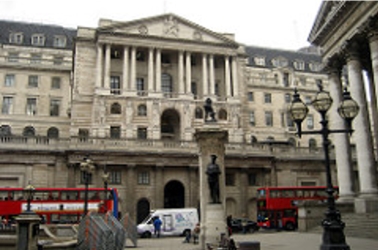
Bank
of England Memorial |
|
Lance Corporal 40576 Arthur Needham
|
|
12th Bn, Prince of Wales's (West Yorkshire) Regiment
Died of Wounds 4th May 1917, Aged 26.
Buried Faubourg d'Amiens Cemetery, Arras, V. D. 16.
|
|
Arthur Needham was born in Shepshed in 1891, the son of Arthur Needham and his wife Maria (née Thurman) who were married at St. Botolph's Church, Shepshed on 19th May 1890. In 1891 Arthur's father was a woollen glove hand and his mother was a woollen glove stitcher and in 1891 the Needham family lodged with Miss Ann Tabb in Leicester Road, Shepshed. Arthur's father died in 1909 and his mother moved to Forest Road, Shepshed, with her children. Arthur Junior had one brother Thomas and five sisters Elizabeth, Kate, Emma, Mary Ann and Annie. Another brother John had died aged two.
In 1911 Arthur Junior was an out-of-work shoe-hand while his mother worked as a charwoman. Arthur subsequently found work as a farm hand and in 1914 was living at 22 Mill Street, Loughborough. He married Rebecca May Smith, a shoe trade polisher, on 4th October 1914 at Emmanuel Church, Loughborough and their daughter Elizabeth May was baptised at Emmanuel Church on 2nd August 1916.
Arthur enlisted in the summer of 1915 and joined the 12th (Service) Battalion of the Prince of Wales's Own (West Yorkshire) Regiment as Private 40576. His service record has not survived but it is known that after preliminary training, he was sent to France sometime in 1916 or 1917. The 12th West Yorkshire Battalion received large batches of reinforcements in April, June, July, September and November 1916 and also in February and April 1917 and Arthur would have been in one of these groups.
If Arthur joined his battalion in April 1916 he would have joined them in the area of Méteren and Locre in West Flanders where the battalion was doing tours in the front line trenches. In June he would have joined the battalion in the front line at Reninghelst or at billets in Bailleul. By early July the battalion had moved to Morlancourt, Somme, and was in action at the battle of Bazentin Ridge from 14th-17th July and at Longueval on 23rd July. In mid-August the battalion was heavily shelled south of Guillemont, and on 8th September heavily trench-mortared at Noeux-les-Mines.
After a period of respite in billets at Petigny, Rupigny and Berquigny the battalion did trench tours at Serre until early December, with rest periods at Courcelles. January and February 1917 were mostly spent in training at Feiffes and Houvin-Houvieneul and training continued at Liencourt from 1st-18th March. On 27th March the battalion moved to Arras and were billeted in a cellar, Arras being heavily shelled. On 9th April the battalion advanced on Tilloy and achieved their objective despite determined enemy resistance before moving on to trenches near Monchy and going into the attack at Guemappe. They returned to the trenches near Tilloy in early May.
It is not known at which point Arthur was wounded but he died from his wounds, aged 26, on 4th May 1917. By the time he died he had been promoted to Lance Corporal. Arthur was buried in Faubourg d'Amiens Cemetery, Arras, Grave V. D. 16. He is remembered on the Shepshed War Memorial.
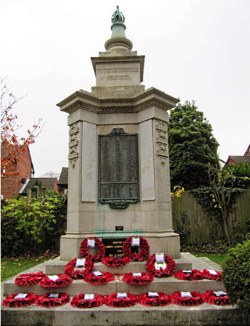
Shepshed War Memorial
|
|
|
|
Private 10464 Thomas Needham
|
|
1st Bn. Sherwood Foresters (Notts & Derby Regt.)
Died of Wounds 12th June 1915, Aged 26.
Buried Boulogne Eastern Cemetery VIII. A. 78.
|
Thomas Needham was born in 1889 in Shepshed, the eldest son of George and Mary Needham (née Wesley) who were married in 1887. Thomas' father was a rotary machine hand in the hosiery business, his mother was a hosiery seamer and in 1891 they lived in Belton Street, Shepshed. When Thomas' father died in 1900 his mother moved with her children Thomas, Joseph, William, Lizzie Ann and Zach to Leicester Rd, Shepshed. She later moved to 7 Moor Lane, Loughborough, then to 2 Wheatsheaf Yard and subsequently to 58 Regent Street, and finally to 30 Wood Gate.
Thomas, a general labourer, enlisted at Nottingham 7th October 1907 aged 18 and joined the 1st Battalion of the Sherwood Foresters as Private 10464. In 1909 he was posted to India for five years and served in Bangalore, Secunderabad, Deolali (where he caught malaria), and Colaba (part of Bombay, now Mumbai). He returned to England at the beginning of September 1914 and left for France on 4th November as part of the British Expeditionary Force.
In January 1915 the battalion was holding trenches facing Neuve Chapelle, not far from Richebourg and in one three day period had 73 casualties. The trenches were either frozen or flooded and men had to move over open ground to the front line, with the enemy only 120 yards away. In March Thomas fought at the Battle of Neuve Chapelle and on 9th May was wounded in action at the Battle of Aubers Ridge. He was moved to Boulogne General Hospital, but died from his wounds almost a month later, aged 26. He is buried at Boulogne Eastern Cemetery Grave VIII.A.78. |
|
|
|
Private 40788 Arthur Newbold
|
|
6th Bn. Lincolnshire Regiment.
Died of Wounds 25th July 1917, Aged 30.
Buried Essex Farm Cemetery Boezinge, II. H. 6.
|
Arthur Newbold was born in 1886 in Loughborough, the son of Martha Newbold (née Wheldon). Martha had married Charles Newbold, a labourer, on 5th June 1876 at All Saints Church, Loughborough, but Charles had died in 1883 three years before Arthur was born. In 1891 Martha was living at 12 Factory Street, Loughborough, with William Newbold, the older brother of Charles Newbold, a machine labourer, and two daughters Jane and Elizabeth from her marriage to Charles Newbold. In the household were also Arthur, William and Ernest Newbold whose father(s) are unknown.
By 1901 Martha was living at 21 Buckhorn Square, Loughborough, but without William Newbold who had moved to 20 Queen Street, Loughborough. She was earning her living as a charwoman and had four children with her, Arthur and Ernest Newbold, Albert (Lakin) Newbold and Florence Lakin Newbold. Arthur, aged 14, was an errand boy. On 5th July 1902 Martha Newbold married Arthur Lakin, a gardener and father of her two youngest children at All Saints Church, Loughborough and moved to 112 Freehold Street.
By 1911 Arthur had moved away from Loughborough. He was employed as a brickmaker by Williamsons of Stamford, Lincolnshire and was in lodgings with the Collins family at 4 Crocks Court, Stamford. On 2nd October 1915 he married May Dennis in Stamford and on 28th June 1916 their daughter Rose was born at 6 School Terrace, Stamford. After Rose was born May moved with her daughter to 40 North Street, Stamford.
In June 1916, Arthur enlisted with the Lincolnshire Regiment in Stamford, initially as Private 5972 with the 1/4th Battalion but on arrival at base camp was almost immediately transferred to and served with the 6th Battalion as Private 40788. He was most probably conscripted. The date on which he was sent to France is unknown as his service papers have not survived. The battalion's war diary, however, notes that the battalion received reinforcements in October and November 1916 and Arthur is likely to have been in one of these drafts.
From October until mid-November 1916 the battalion was at Cramont, Somme, in training. On 14th November the battalion returned to the line in a wretched part of the battlefield, a ravine west of Beaucourt where the front line consisted largely of unconnected shell holes, full of mud and water. Here the battalion came under heavy fire. Further trench tours followed with rest periods at Engelbelmer until February 1917 when the battalion moved to Hanchy and Le Festel for railway construction.
Between 9th March and 24th April 1917 the battalion was used for further railway work in the Authie Valley before returning to the front line at Louverval.
In May, in the build-up to the Flanders Offensive, the battalion was moved to the Wytschaete sector of the line on the Ypres Salient. Between the 7th and 14th June the battalion took part in the Battle of Messines and incurred casualties of 6 Officers and 160 Other Ranks.
After the battle the battalion was withdrawn for training at Nortleulinghem before being sent back into the St. Jean sector of the line at Ypres in mid-July.
On 25th July 1917 Arthur, aged 30, died from gas shell poisoning, a shell having fallen into the dugout where he and some comrades were sleeping. He was buried at Essex Farm Cemetery, Boezinghe, near Ypres, Grave II. H. 6.
Arthur's widow was married again in 1925 to Richard Henry Robinson of Stamford. Arthur's daughter Rose died, aged 13, in 1929.
|
|
|
|
Sergeant 10250 Bertie Newbold
|
|
6th Bn. Leicestershire Regiment.
Killed in Action 9th June 1916, Aged 25.
Buried Bienvillers Military Cemetery I. A. 26.
|
Bertie Newbold was born in Loughborough in 1891, the son of Charles Newbold and Mary Ann Newbold (née Ward) who were married in Loughborough in 1870. Charles and Mary Ann had ten children, six of whom survived to adulthood. Bertie was their youngest child; he had four brothers Willie, Charles, John, and Arthur and one sister Martha. Bertie's father was a house painter and Bertie, unlike his brothers, joined his father in the painting and decorating business. The family lived at 15 Russell Street, Loughborough, until all the children except Bertie had left home. At this point Bertie's parents and Bertie moved to 30 Russell Street.
Bertie enlisted at Loughborough on 19 August 1914 and joined the 6th (Service) Battalion of the Leicestershire Regiment as Private 10250. He was sent to Bordon, Hampshire for training. On 24 September 1914 he was appointed Lance Corporal. On 26 February 1915 he was promoted to the position of Corporal (unpaid). In April 1915 the 6th Battalion became part of the 37th Division of the Army and concentrated at Cholderton on Salisbury Plain. On 25th June the 37th Division was inspected by King George V at Sidbury Hill. On 22nd July 1915 the Division began to cross the English Channel and by 2nd August all units were concentrated near Tilques not far from St.Omer in the Nord-Pas-de-Calais. Bertie embarked for France on 29th July 1915.
In September Bertie's battalion was sent to the area of Berles-au-Bois, south-west of Arras. The battalion remained in this area around Bienvillers and Bailleulmont until July 1916 and was engaged in localised operations seeking a tactical advantage. Having been confirmed in the rank of Corporal in February 1916 Bertie was simultaneously appointed as a Lance Sergeant, followed by another promotion to Acting Sergeant on 10th May 1916.
Bertie was 25 when he was killed. Sergeant Moffat Ecob of the 6th Battalion of the Leicestershire Regiment wrote a letter to his parents describing the unfortunate deaths of Roland Austin, Frank Benskin, Bertie Newbold and Sidney Wade, all in the 6th Leicesters and all from Loughborough. Ecob had gone out to fetch a working party and on his return found that the dug-out at Saulty (13 miles south-west of Arras) where he had left his four friends had been hit by a shell, blowing it to pieces. All four men had been killed instantaneously.
Bertie is buried in Bienvillers Military Cemetery, Grave I. A. 26.
|
|
|
|
Private L/7570 Arthur Newbon
|
|
4th Bn, Middlesex Regiment.
Died of Wounds 14th December 1914, Aged 32.
Buried Boulogne Eastern Cemetery III. B. 63.
Served under the alias of 'Arthur Newman'.
(his step brother Alfred John Parr also fell)
|
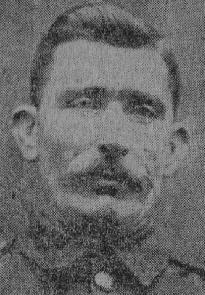
|
|
Arthur Newbon, otherwise known as Arthur Newman, was born in 1883 to Charles
Newbon, an engineering driller, and Sarah Jane Newbon of 107 Meadow Lane,
Loughborough. Arthur's mother, however, unfortunately died in 1897. In 1900
Arthur's father was remarried to a widow, Elizabeth Ann Parr, and Arthur could have
become part of the large blended family which lived at 19 Ratcliff Road,
Loughborough. Now, as well as Arthur, his older brother James and his younger
sister Mary Ellen there were three more boys from Elizabeth's first marriage, Alfred,
Archie and John Parr. In addition there was Charles (the first of the eventual five
children from Elizabeth's marriage to Charles Newbon) and an adopted daughter
Mabel Barber. Arthur, however, was eager to be off.
In the wake of his father's second marriage, on 3rd December 1900 Arthur, a brown
haired blue eyed lad, attested for the Leicestershire Regiment. On being medically
examined he was rejected as being 'of defective physique' and 'not likely to become
an efficient militiaman'.
Nothing daunted, on 23 July 1901, Arthur attested at Hounslow for the Middlesex
Regiment (Duke of Cambridge's Own) and was accepted. He was posted to the 6th
Middlesex Regiment, a militia battalion, on 6th September 1901. His attestation form
on this occasion gives the first indication of a possible change of surname, the
Recruiting Officer writing down the name Newman. Arthur nevertheless signed the
form as 'Arthur Newbon'. On another form, however, he signed his name as 'Arthur
Newman'.
Arthur next appears to have been transferred to the 2nd Battalion of the Middlesex
Regiment, and subsequently to the 1st Battalion. His initial overseas posting was in
1902 to the Atlantic island of St. Helena where over five thousand Boer POWs were
held, camped on 'Deadwood Plain' and 'Broad Bottom'. Arthur was awarded the
Queen's South Africa Medal for his role in guarding these prisoners of war. He then
served six years with the Middlesex Regiment in the East Indies.
In 1911 Arthur was lodging in Coventry where he was employed as a labourer at a
motor works. In July 1914, he married a widow, Kate Ryan (née Johnson) in
Coventry, under the alias of Arthur Newman.
When World War One broke out, Arthur was recalled and joined 'A' Company of the
4th Battalion of the Middlesex Regiment, stationed in Devonport. They promptly left
for France as part of the British Expeditionary Force, landing in Boulogne on the 14th
August 1914.
Arthur's battalion saw action in the Battle of Mons and its subsequent retreat, the
Battles of Le Cateau, the Marne, the Aisne, La Bassée and Messines, and the First
Battle of Ypres.
Arthur died of wounds on 14th December 1914 in no.13 General Hospital, Boulogne.
He left behind his wife of three months, Kate Newman of Gosford Street, Coventry,
and a young step-daughter Kate. Arthur's stepbrother, Alfred Parr, also fell during
the war. His gravestone bears the name 'Newman', rather than 'Newbon', and his
medals (Boer War and World War One) were also issued in the name of 'Arthur
Newman'.
|
|
Name has been spelt wrong
|
|
Private 3657 Ernest Newton
|
|
1/5th Bn. Leicestershire Regiment.
Killed in Action 13th October 1915, Aged 31.
Commemorated Loos Memorial panel 42 - 44
|
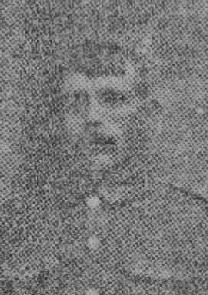
|
Ernest Newton was born on 24th May 1883 at Wheatsheaf Yard, Loughborough, the youngest son of Aaron and Fanny Newton (formerly Hallam, née Priestley) who were married in Loughborough in 1869. When Aaron and Fanny were married Aaron was a warp hand, but he later became a bricklayer's labourer at Tucker's Brickyard and finally a jobbing gardener.
Ernest had three brothers William, Robert and Walter and three sisters Eleanor, Fanny and Clara. Another sister Hannah (Mrs. Adams) had died in 1913, aged 37. He also had a half-brother John Hallam from his mother's first marriage to Henry Hallam. In 1891 the family lived at 1 Court C, Ward's End but by 1901 they had moved to 24 Woodgate.
Ernest, who like his father, was a brickmaker's labourer, married Annie Thornton in 1905 in Loughborough and the couple set up home at 13 Factory Street, Loughborough, with John Aaron Thornton, Annie's two-year old child from a previous relationship. In 1909 Ernest and Annie had a daughter of their own, Mary. Their son Thomas had died at birth in 1905.
Ernest enlisted in January 1915, giving his home address as Shepshed. He joined the 2/5th Battalion of the Leicestershire Regiment as Private 3697 and was then drafted to the 1/5th Battalion. After a period of training at Luton and St. Albans he was sent to France on 17th August 1915. He joined his battalion in the Salient, near Zillebeke, where they remained until the beginning of October when they were ordered to move towards Loos.
On 12th October 1915 the battalion travelled to the Hohenzollern Redoubt, arriving in Vermelles at 10.00pm. They spent the next eight hours in communication trenches. On 13th October 1915 during the attack on the Redoubt, part of the final stages of the Battle of Loos, the 1/5th Battalion was in reserve until just after midday, when they 'went over the top' and came under intense machine gun fire. Ernest was killed aged 31, during the attack on the Redoubt, part of the final stages of the Battle of Loos.
Ernest is commemorated on the Loos Memorial, panel 42-44, on the Shepshed War Memorial and on the memorial at Emmanuel Church, Loughborough, as well as the Carillon.
His wife Annie had to wait a year before the War Office confirmed his death. She married James Oldham, a widower with older children, at the end of 1916 in Leicester and afterwards lived at 41 Cambridge Road, Loughborough.
Ernest's stepson John Aaron Thornton changed his surname to Newton and served as a Band Sergeant with the 1/5th Battalion of the Leicestershire Regiment from about 1920. He was immediately called to the Colours at the outbreak of World War Two and served in Norway and Ireland. John Aaron Thornton's son Clifford Newton also served with the Leicestershire Regiment and served in Germany, Sudan and Cyprus in the 1950s.
Annie's second husband James Oldham died in 1925 and she married William Hart six months later in Loughborough.
|
|
|
|
Leading Stoker K/2 Arthur North
|
|
Royal Navy HMS Hampshire.
Killed in Action 5th June 1916.
Commemorated Portsmouth Naval Memorial panel 16.
|
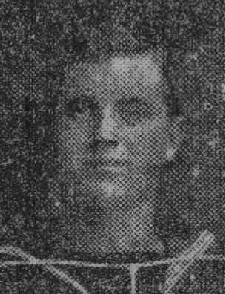
|
Arthur North was born on 11th November 1889 in Loughborough, the son of Arthur and Sarah North (née Hollingworth). His parents were married in Loughborough in 1880 and had seventeen children, eleven of whom survived to adulthood. Arthur had three brothers Edward, Harry and Isaiah, and seven sisters Jane, Sarah, Lilian, Lavinia, Catherine and Elizabeth (twins) and Evelyn. Arthur's father, Arthur North Senior, started out as a platelayer on the railway, became labourer for a horticulturer and in his later years a railway drayman. In 1891 the family lived at 8 Conery Passage, Loughborough, and by 1901 had moved to 116 Station Road. In 1911 Arthur's parents were living alone at 4 Dead Lane, all their children having left home. They later moved to 52 Regent Street, Loughborough.
Arthur had been working as a boilermaker's labourer when in January 1908, aged 18, he joined the Navy signing up for twelve years. He started his naval career as a Stoker 2 on HMS Nelson, a training ship. He then spent almost a year on HMS Essex, an armoured cruiser, towards the end of which he was promoted to Stoker 1. In June 1909 he was sent to HMS Blenheim, a Blake-class armoured cruiser, for almost six months before having a short break at the shore establishment HMS Victory II. In December 1909 he was sent to HMS Minotaur, a Minotaur-class armoured cruiser, where he remained until May 1912. This was followed by two months on the HMS Spartiate, a Diadem-class cruiser, and six months at HMS Victory I shore establishment. In 1913 Arthur served on HMS Aboukir, a Cressy-class cruiser, HMS Good Hope, a Drake-class armoured cruiser and HMS Europa, a Diadem-class cruiser. In January 1914 Arthur joined the HMS Hampshire, a Devonshire-class armoured cruiser and on 1st January 1916 was appointed to the rank of Leading Stoker.
HMS Hampshire was assigned to the Navy's 7th Cruiser Squadron in January 1915 and was detached in November 1915 to escort shipping in the White Sea. She returned home in time to participate in the Battle of Jutland on 31st May 1916 with the 2nd Cruiser Squadron. During the battle she was never actually engaged and immediately afterwards was ordered to carry Lord Kitchener from Scapa Flow on a diplomatic mission to Arkhangelsk. On 5th June 1916 in a gale force storm one and a half miles off the coast of Orkney between Brough of Birsay and Marwick Head HMS Hampshire unfortunately hit a German mine laid by a U-Boat. The detonation holed the cruiser between bows and bridge and the lifeboats were smashed against the side of the ship when they were lowered. About fifteen minutes after the explosion HMS Hampshire sank by the bows, taking all but twelve on board with her. According to the Ministry of Defence the ship's full complement at the time of sailing was 655 men and 7 passengers who were Lord Kitchener and his staff.
The bodies of over 100 officers and men were recovered from the sea and were interred into one common grave at the Lyness Cemetery, Hoy, Orkney.
Arthur is commemorated on the Portsmouth Naval Memorial panel 16 as well as on the memorial at St. Peter's Church, Loughborough, and on the Carillon. The Kitchener Memorial at Marwick Head, Orkney has been restored by the Orkney Heritage Society, with a new wall bearing the names of all those lost on HMS Hampshire. A tree for each man lost on HMS Hampshire has been planted by Woodland Trust Scotland in order to create HMS Hampshire Centenary Wood near Kirkwall Grammar School.
Arthur's brother Driver Harry North who was wounded at Mons and taken as a Prisoner of War to Germany, survived the war.
|
|
|
|
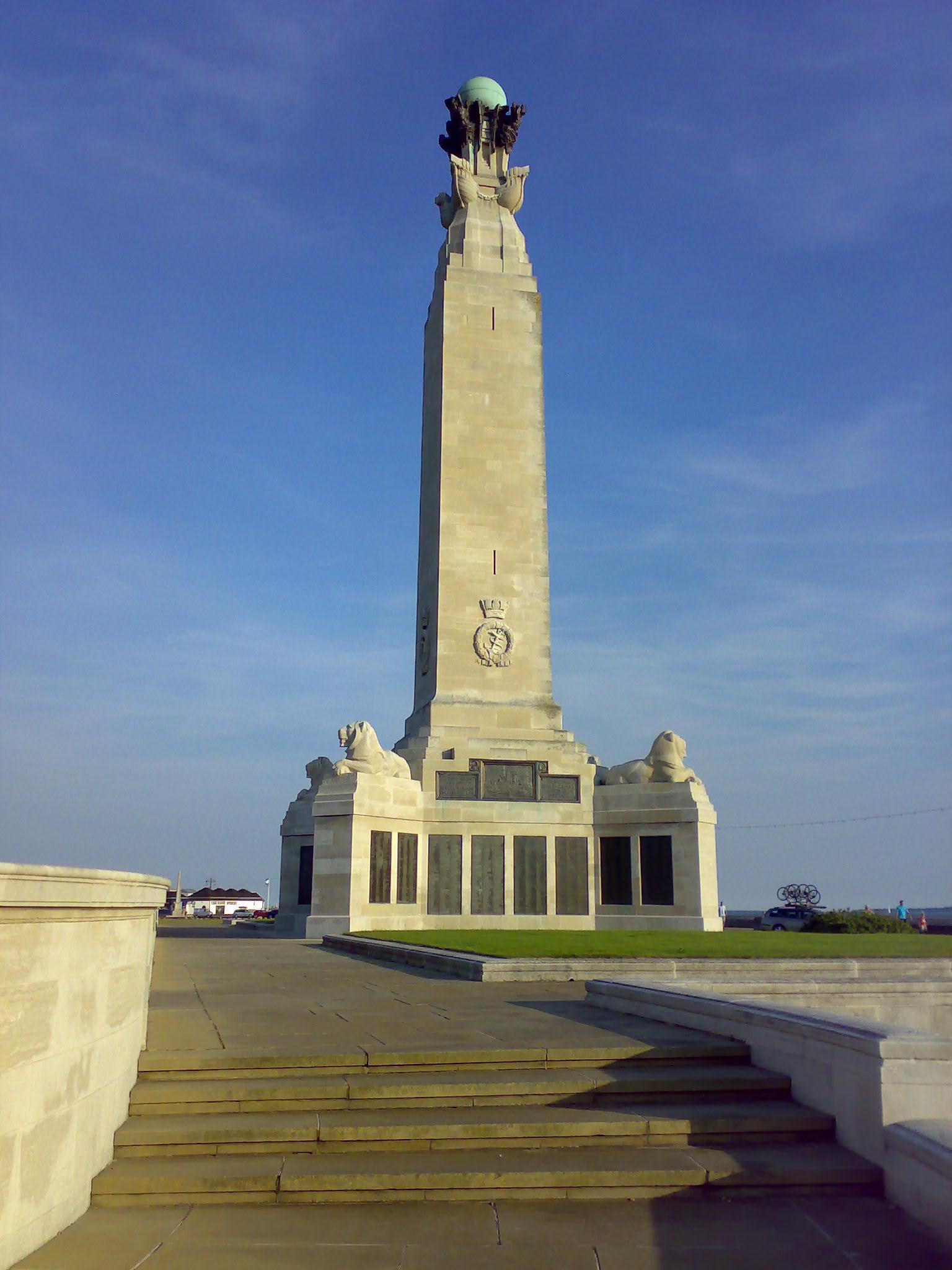
Portsmouth Naval Memorial
|
|
Private 174355 Eric Arthur North
|
|
12th Coy. Canadian Machine Gun Corps.
Died of Wounds 3rd August 1917, Aged 19.
Buried Cabaret-Rouge British Cemetery II. F. 7.
|
|
Eric Arthur North was born in Loughborough on Christmas Day 1897 and baptised on 10th April 1898 at Holy Trinity Church, Loughborough. He was the only son of Arthur North, a baker, and his wife Harriet Ann (née Grant) who were married on 11th March 1897 at the Chapel, Tur Langton, Leicestershire. Arthur had two younger sisters Alice and Harriet Ida. In 1901 the North family lived at 25 Queen Street, Loughborough, but in 1910 emigrated to Canada. Eric's father travelled in advance and Eric, with his mother and sisters, sailed from Bristol for Quebec on the SS Royal George on 21st July 1910.
By 1911 the North family had settled at 271 Hunter Street, Hamilton, Ontario, and Eric, now 13, was employed as an office boy. Two years later he was a clerk and his family had moved to 801 King Street West. By 1921 the family had moved again to 52 Margaret Street, Hamilton, and Eric's father had become a sheriff.
Eric enlisted on 10th September 1915 at Hamilton and joined the 12th Canadian Machine Gun Coy as Private 174355. The Company was attached to the 12th Infantry Brigade, 4th Canadian Infantry Division.
By early June 1916 the Company had crossed the Atlantic and was training in Bramshott, Hampshire, with three Colt guns. One month later the Colt guns were withdrawn in favour of Vickers guns, with practice at Longmoor Range, south of Bordon.
Eric landed in France on 12th August 1916. In early September the 12th Coy was sent to Kemmel in Flanders to support units of the Canadian Infantry Brigade in the front line. After this the Company moved to Houlle in the Pas de Calais for tactical training. Further training in map reading followed in early October before the Company was attached to the 10th Canadian Infantry in Destremont Trench, Albert. Here their guns took part in an action which resulted in the capture of Regina Trench, the Company incurring a number of casualties. For the last two weeks of November they stayed in the line at Albert before moving to Maisnil-lès-Ruitz until 21st December for rest, reorganisation and re-equipment.
Christmas was spent at Cambligneul and on Boxing Day the Company went into the line at Gouy-Servins. Here they carried out many night-firing operations until 8th March 1917. After a brief respite at the Bois de Bouvigny the Company began a firing operation aimed at Hill 145, the highest point on the Vimy Ridge. The Company was then heavily involved in the Battle of Vimy Ridge (part of the opening phase of the Battle of Arras) which followed from 9th-12th April.
After this battle the 12th Coy was withdrawn to Compigny Huts and provided a battlefield clearing party. On 24th April the Company was moved to the Zouave Valley where they remained in the line from May to August 1917, with breaks at Chateau de la Haie. The Company was in the area of Hospital Corner on 3rd August when Eric was wounded in action. He died the same day, aged 19.
Eric was buried at Cabaret-Rouge British Cemetery, Souchez, Grave II. F.7. He is remembered on the Canadian Virtual War Memorial and on the Carillon.
|
|
|
|
Private 15666 Percy North
|
|
7th Bn, Leicestershire Regiment.
Died at Home of Pneumonia 21st November 1918, Aged 28.
Buried Aylesbury Cemetery Buckinghamshire, Y. 56.
|
|
Percy North was born in September 1890 in Loughborough. He was the son of Absalom North (known earlier as Absalom North Shelton) and his second wife Louisa (formerly Collins, née Parrott) who were married in Leicester in 1888. Percy had one full-blood sister Rose. He also had five half- brothers and one half-sister from his father's first marriage to Alice Webster (who had died in 1879): John, George, Herbert, William, Arthur and Sarah North Shelton. In addition he had three half-brothers and one half-sister from his mother's first marriage to Harry Collins (who had died in an accident while repairing a pump in a well at Hoton in 1878): George, Charles, William and Louisa Collins.
Percy's father was a hosiery machine worker. In 1891 Percy's parents, now using the surname of North, were living at 40 Duke Street, Loughborough, with Herbert, William, Hilda and Percy North and George and William Collins. By 1901 they had moved to 76A Nottingham Road and only Rose and Percy North and William Collins were now with them. Ten years later only Rose and Percy were still at home and Percy, now 21, was a turner in an iron works. Between 1911 and 1914 Percy was employed by the Bifurcated and Tubular Steel Works at Aylesbury, Buckinghamshire, and went to live at 7 Beaconsfield Road, Aylesbury.
Percy, who had previously served in the militia for five years, re-enlisted on 14th October 1914. He was sent to the Depot of the Leicestershire Regiment at Glen Parva and on 31st October was posted to the 7th (Service) Battalion of the Leicestershire Regiment as Private 15666. He was then sent to join the battalion at Salamanca Barracks, Aldershot. Here the emphasis was on individual training, squad and platoon drill. At the beginning of 1915 the battalion began route marches and more strenuous training. In March the battalion moved into billets in the Andover area and in April to Cholderton on Salisbury Plain. On 25th June they were inspected by King George V at Sidbury Hill and on 29th July 1915 they received orders to proceed to France. The 7th Leicesters set sail for France from Folkestone on the SS Onward 'in utter darkness and complete silence'. There was no-one to see off the 110th Brigade as ships leaving full of 'Tommies bound for France' were no longer exciting.
On 30th July Percy's battalion entrained at Pont-à-Bric for Watten and marched to Eperlecques. Over the next three days they moved via Lyne and Eecke to Locre and moved up in groups to the trenches near Kemmel for instruction. On 17th August they left Locre for Eecke, with one company going to dig near Armentières. On 23rd August the battalion entrained for Doullens and marched to Mondicourt where they remained until 29th August. On 30th August the battalion began moving to Bienvillers.
The battalion remained in the area around Bienvillers and Bailleulmont until April 1916 and was engaged in trench tours and localised operations seeking a tactical advantage. When not in the trenches being subjected to enemy shelling the 7th Leicesters received intensive training in bombing, Lewis gunnery, visual signalling and a host of other activities.
Percy, however, was recalled to England at the beginning of February 1916 and on 14th March attached to the Ordnance Works, Coventry, for duty. In 1916 his mother died in Leicester and his father moved to 112 Leopold Street, Loughborough.
On 4th August 1918 Percy married Lucy Maud Chappell at St. Mary's Church, Walton, Aylesbury, Buckinghamshire. After the wedding Percy returned to work at Coventry. and his wife Lucy subsequently moved to 4 Stock Lake, Aylesbury. Percy died of pneumonia at the Warwickshire Military Hospital, Coventry, on 21st November 1918. He was only 28 and is likely to have been a victim of the influenza epidemic.
 Aylesbury War Memorial
Aylesbury War Memorial
Percy was buried in Aylesbury Cemetery, Grave Y. 56. He is commemorated on the war memorial in Holy Trinity Church and on the War Memorial in Market Square, Aylesbury. He is also remembered on the Carillon, Loughborough.
Percy's daughter, Hilda Maud North, was born in Aylesbury, on 28th January 1919.
|
|
|
|
|

